- Meet the Team
- Work with Us
- Czech Republic
- Netherlands
- Switzerland
- Scandinavia
- Philippines
- South Korea
- New Zealand
- South Africa
- Budget Travel
- Work & Travel
- The Broke Backpacker Manifesto
- Travel Resources
- How to Travel on $10/day
Home » Budget Travel » The ULTIMATE Guide to Overland Travel (2024)

The ULTIMATE Guide to Overland Travel (2024)
It is absolutely without question that my best travel journeys to date have been overland.
Some were on motorbike, others were by way of a cardboard sign on the side of the road, and I have visions of future journeys that involve a big old school bus traversing the lands between Europe and Asia.
Overland travel is inspiring, and it is undoubtedly the best way to hit the road, especially as a backpacker looking to save money and dig deep into countries and cultures. While social media may have you thinking that you need to spend tens of thousands of dollars on a tricked out 4×4 to become an overlander, I’m here to completely dispel that myth.
Sure, van life and Land Rover Defenders are certainly a type of overlanding, but they’re not the end all be all.
Overland travel can be as simple as sticking out your thumb and hitchhiking, or using trains and shared taxis to get from one place to another. But regardless of the rig you choose, I guarantee you the experience of coasting along wide open plains at your own pace, sharing meals of yak yogurt with nomads, and getting to pitch your tent (or park your ride) just about anywhere will be absolutely worth it.
But still, I totally understand that it can all be intimidating. So let’s set the record straight with this ultimate guide to overland travel – where you’ll see that this is very much a “do as you like” adventure.
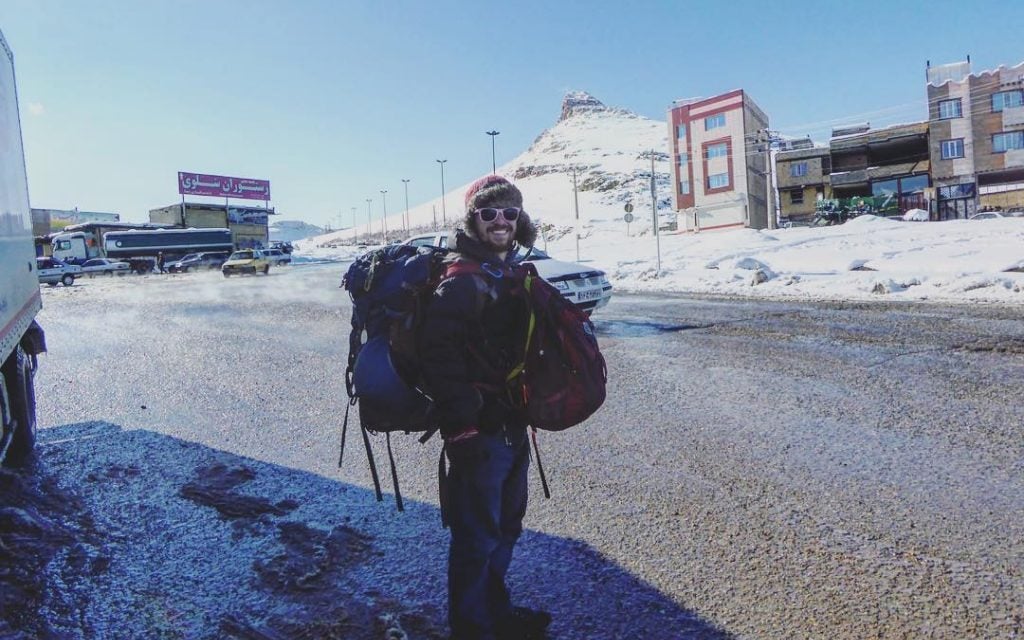
Do You Want to Travel FOREVER??
Pop your email in below to get a FREE copy of ‘How to Travel the World on $10 a Day!’.
What is Overland Travel?
While you most likely already know the literal definition – traveling by land AKA avoiding flights – there’s a lot more to overland travel than just what’s in the name.
Overland travel – whether it be by foot, by bicycle, by rail, by van or whatever method you choose – is an art in and of itself. Closely intertwined with my other favorite form of budget backpacking – slow travel – overlanding allows you to get to know the places you visit far more deeply than a bunch of flights ever could.
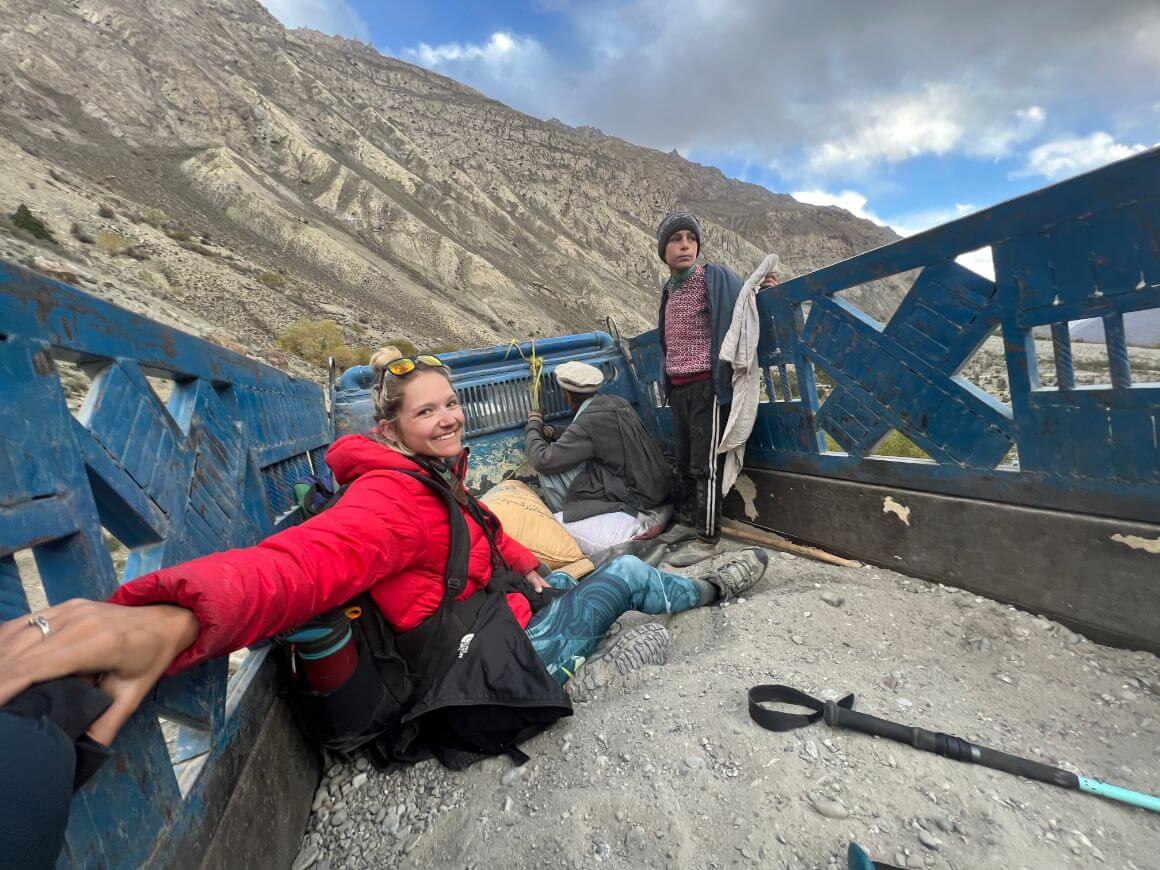
Overlanding is TRULY where the journey matters even more than even the destinations themselves. It’s what gave me some of the best moments of my life, something I know virtually all of my favorite adventurers would agree on when reflecting upon their own journeys.
And once you get started, I promise you you’ll only want to dig deeper and deeper into what it means to become an overlander…
Why YOU Should Overland
Before we REALLY get into this, I want to make something clear.
Overland travel doesn’t HAVE to be an odyssey. While it is for many travellers – like my journey from the UK to Papua New Guinea – you can travel overland without crossing a single international border.
The thing is, there are no rules to this type of travel. There’s no right or wrong way to become an overlander. You don’t need a tricked-out Land Rover Defender, you don’t need a van, you don’t need a bicycle. Hell, plenty of inspiring adventurers have embarked on incredible journeys with nothing but their backpack, a sign, and a stuck-up thumb.
So that, my friends, is one of the reasons WHY you should try overland travel: it’s truly for everyone and anyone.
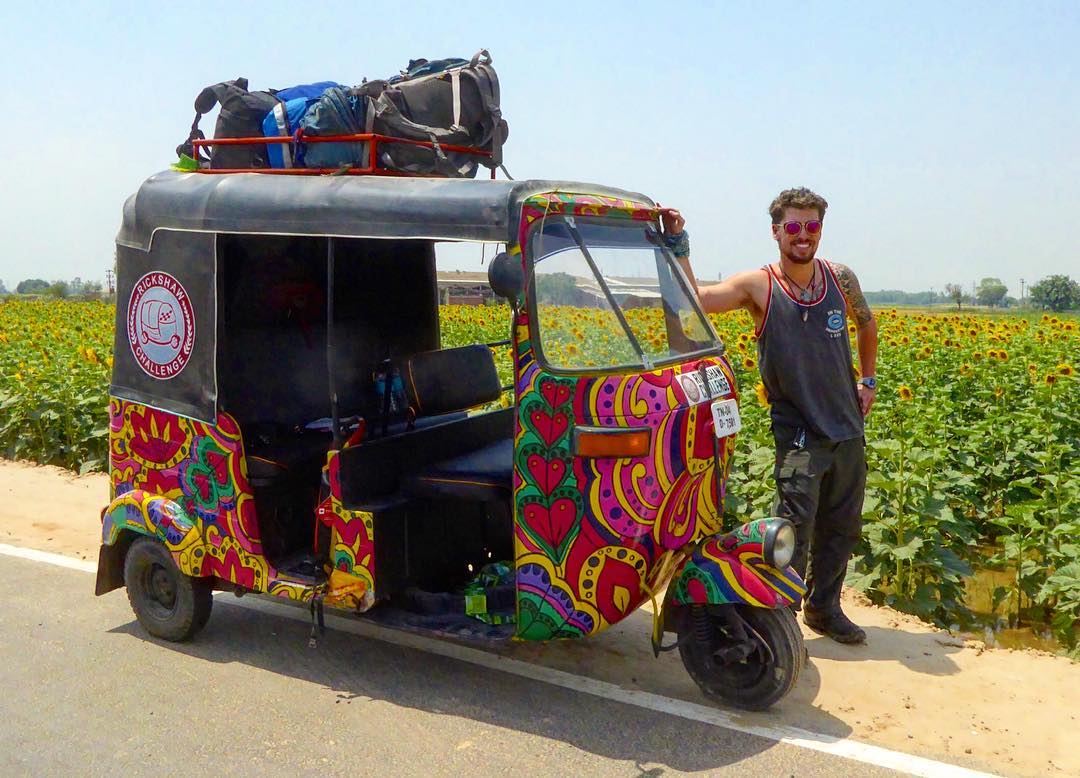
But beyond that, in all my years on the road, it’s this type of travel that’s kept me addicted to life on the road. It’s absolutely not the most comfortable, but it will teach you the most about the world, and about yourself too.
Overland travel will push you to your limits, and really make you work for each and every view and experience you attain.
For some – like cyclists – that work may be physical. For others, it may be mental: such as moving past introverted tendencies to get around by hitchhiking or dealing with driving in brand-new countries with insane motorists.
It allows you to experience life on the ground to the fullest: minute by minute, mile by mile.
Ways to Travel Overland
This is no one-size-fits-all all method of travel, as there are so many ways to overland. I’ve even seen people do it completely by foot or on something as crazy as a unicycle.
But the following are the most common, and popular, ways to get around on the ground:
While I am not a cycling fan myself, those who have done it have nothing but incredible things to say about bikepacking – which is essentially overlanding with a bicycle strapped with a whole lot of stuff. Travelling by bicycle gives you the chance to slow down and see more than virtually any other way of overlanding.
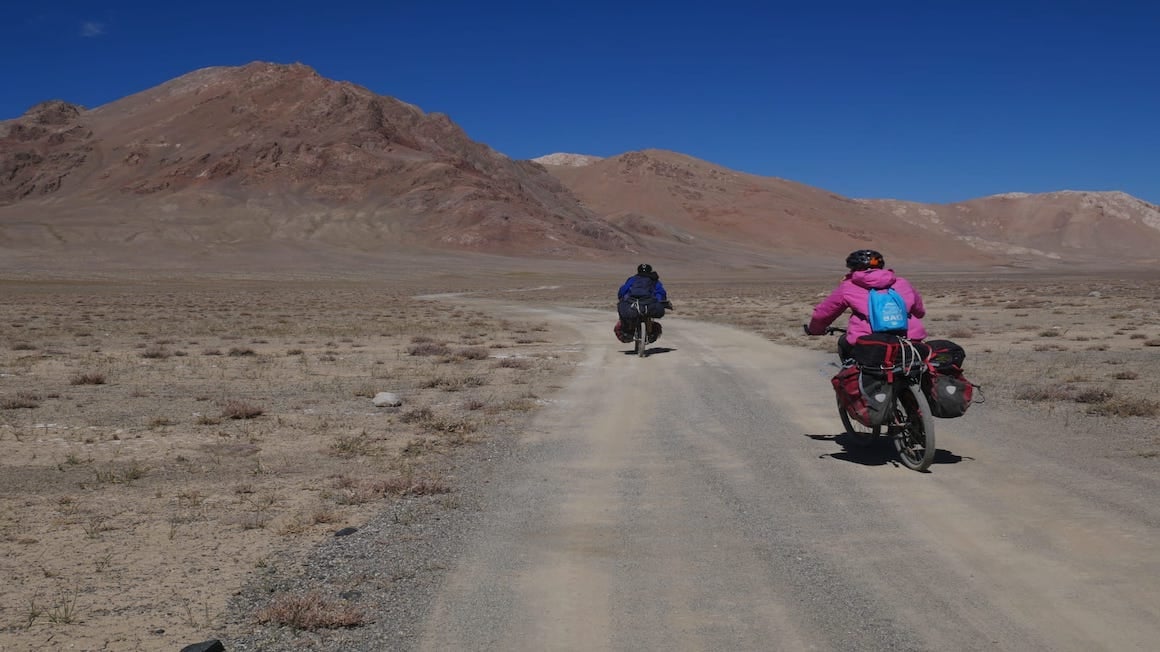
For one your speed (most cyclists don’t do more than 70km per day, depending on the terrain) will allow you to take in just about every village and turn – you’ll get to camp in places far off the tourist trail and meet an incredible lot of locals.
But moreover, cycling is as simple as it is cheap: you don’t need to worry about fuel or engine oil, it’s significantly easier to repair issues, and spare parts don’t tend to weigh that much. It’s also a hell of an accomplishment: unlike all the other forms of overland travel aside from walking, you’ll be physically putting in work every single day.
By Motorbike
As much as I love hitchhiking, traveling by motorbike truly ignites a passion that I have rarely found in other methods of exploring. The feeling of crisp mountain wind on my face as I coast through surreal scenery is one that just doesn’t get old, and it’s certainly something I’d like to try out for longer periods.
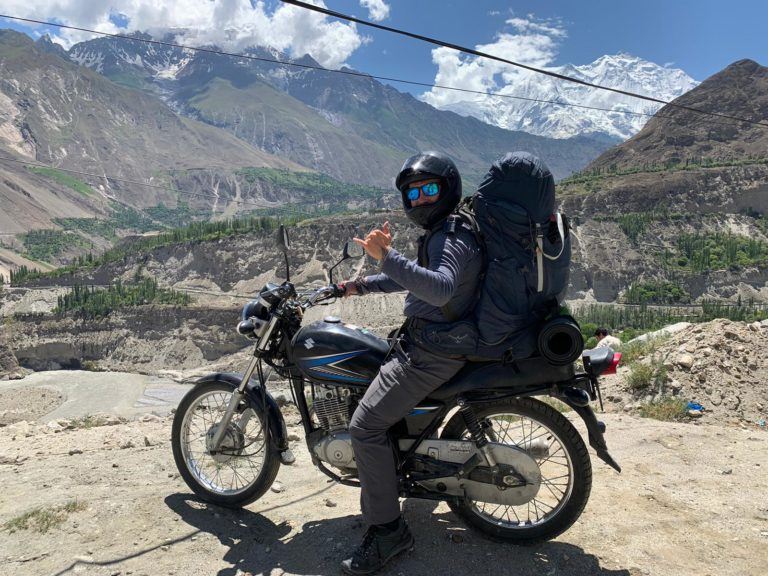
The one thing to keep in mind though is that start-up costs will not be cheap. Good bikes that can actually make it across continents are not cheap, and you’ll also need to buy extra tires, tons of fluids, and other parts that likely will not be available in the places you intend to ride.
But still: it’s worth it. You get the benefits of cycling without the intense struggle, and you’ll be able to maneuver in places where cars cannot. You’ll be able to carry a lot more than a bicycle could, and it will still be cheaper than any van or 4×4.
By Van/Your Own Vehicle
Perhaps the most OG form of overland travel is with your own car: whether it be a van, a 4×4 or an old ambulance, I’ve seen adventurous souls carving their own paths in virtually every type of rig you could imagine.
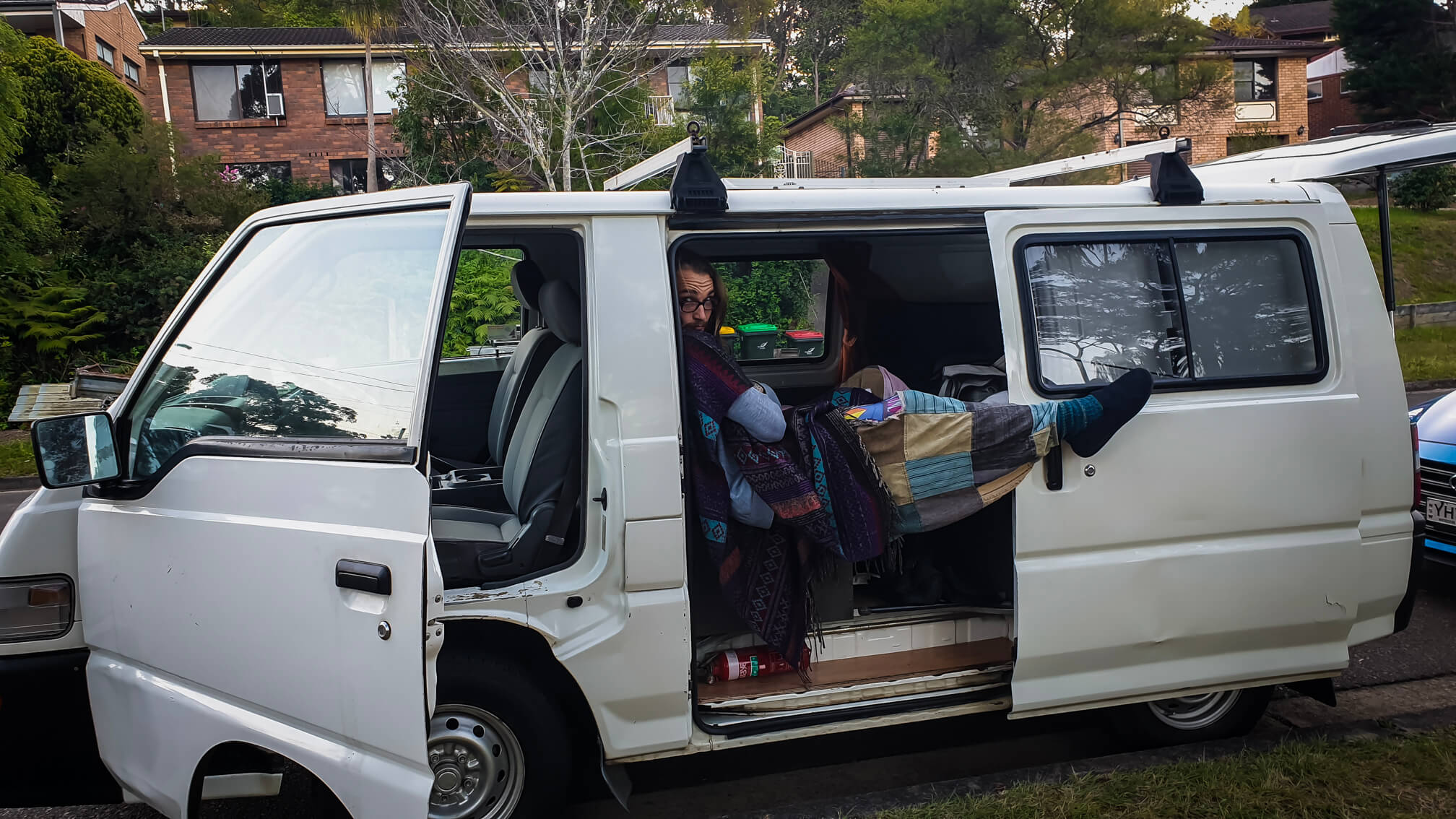
With the popularity of vanlife these days, I’m sure you’ve thought about or at least heard about this craze. I mean, the upsides are many. Your home is with you at all times, you can carry so much more stuff, and you can design your ride exactly as you like. For many, the process of building their house on wheels is just as special as the trip itself.
But there are negatives too: many countries require a carnet de passage that often requires a hefty deposit, repairs can be super expensive, and it’s a whole lot of responsibility. But if you’re determined to make it happen, this is undoubtedly the most comfortable and adventurous way to travel overland, as you can go just about anywhere and won’t be as limited by weather.
By Hitchhiking
My overland hitching journey from UK to Papua New Guinea may not have been completed, but it certainly brought me some incredible (and life-changing) travel memories that I’ll hold on to forever.
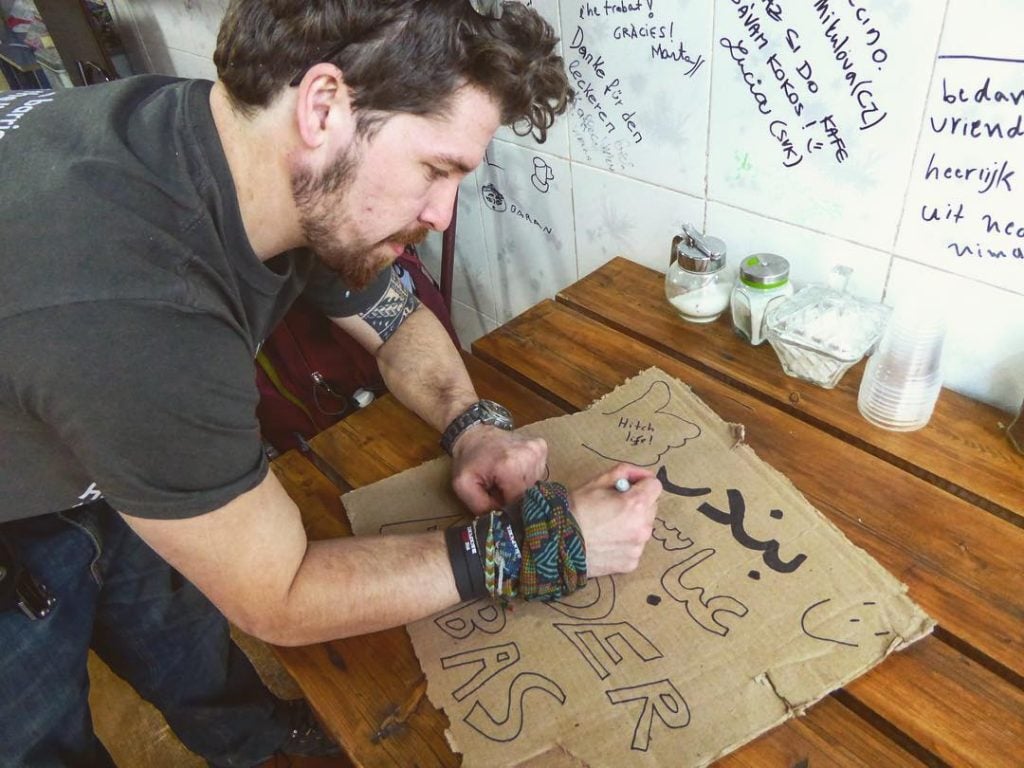
Exploring overland by way of the thumb is not for the faint of heart, or for those lacking patience. But it will bring you closer to strangers and teach you more about the world than any other type of travel. When you’re in a vehicle of any kind (even a bicycle) it somewhat separates you from locals: you’re self-sufficient, right?
But when you’re relying on the kindness of random folks to help you see the world, it opens up doors you didn’t even know were in sight. It leads to unexpected family dinners in local homes, to long chats alongside crackling fires, and to hours spent in random places you would have never visited otherwise. Hitchhiking will change you for the better if you let it, and all you need to get started is a smile, a sign and a stuck-up thumb.
Overland Travel Tips
My top travel tips for making your adventure as smooth as it can be…
1. Do your visa research
While most Westerners are privileged to be able to enter many countries without a visa, you can’t just roll up everywhere. Places like Pakistan, Vietnam, India, and Azerbaijan still require e-visas in advance, and China (often a pain for a lot of overlanders) has a set of very specific rules that usually requires applying for a sticker visa from your home country.
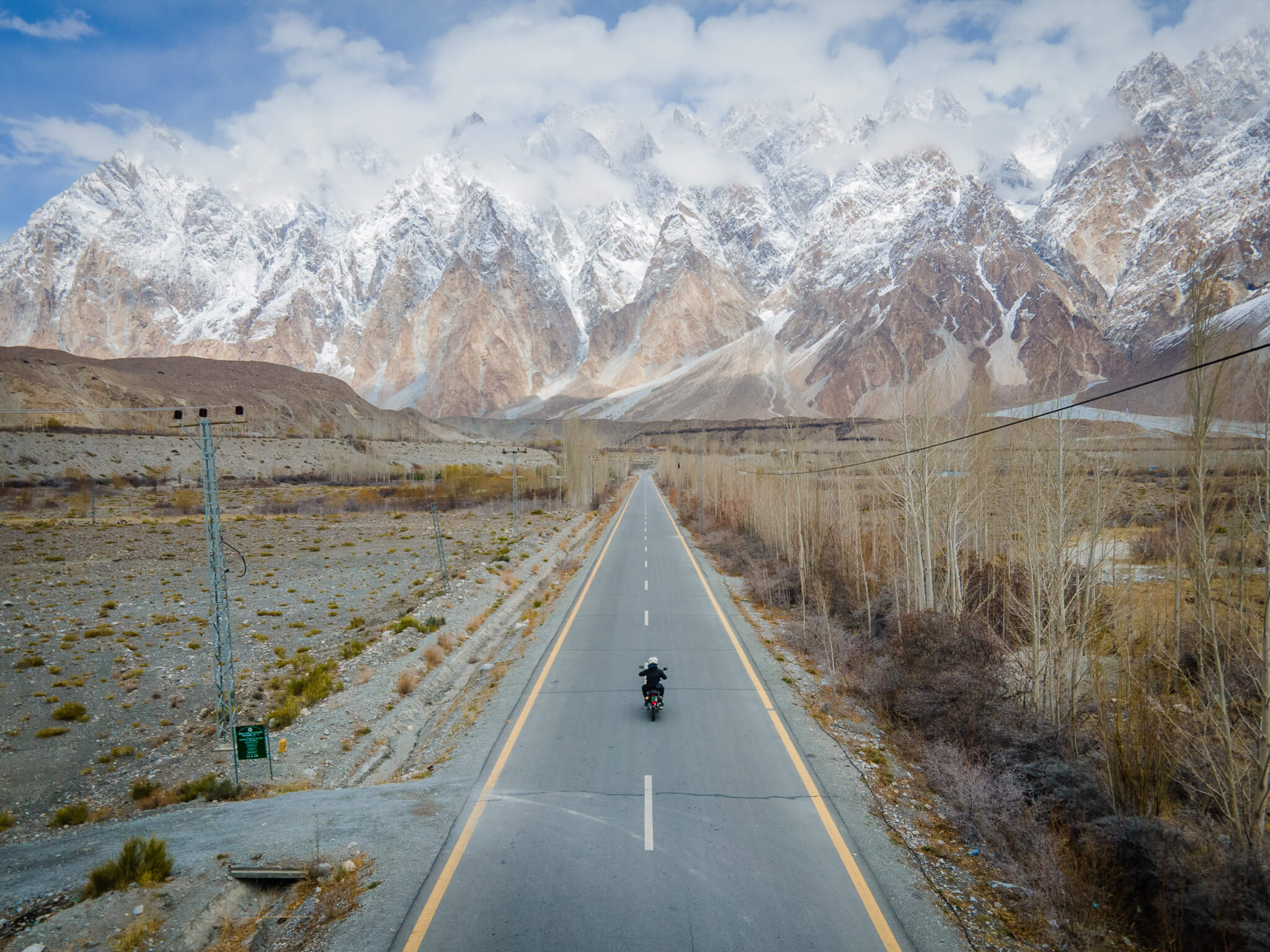
Make sure you read up on every destination you plan to overland through to ensure you don’t find yourself caught out in no man’s land. Sometimes visa rules can change abruptly too, so it’s key to stay on top of them.
2. Bring a LOT of Spare Parts
I cannot stress this enough: if you’re travelling by way of ANY vehicle, it is absolutely essential that you have a good amount of spare parts in tow. Many of the best places to overland are NOT known for their equipment, which means you could potentially be caught out far, far away from civilization.
Spruce up your rig before heading out into super remote areas, and prepare for the unplanned. It’s far better to be a bit overloaded but have everything you need for a mishap than to travel light and become stranded.
3. Don’t forget the little things
You won’t realize how much you need a laundry bag, an eye mask or a good headlamp until you’re stuck in the middle of nowhere with none of the above to be found.
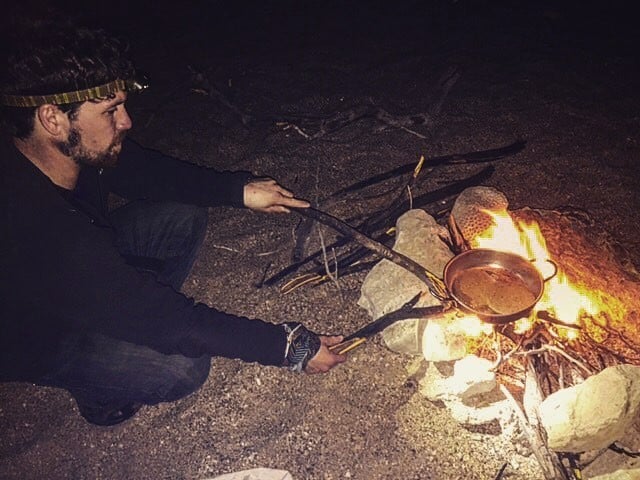
For little things like these, it’s definitely worth it to double up on your supply. You never know when something can get lost or break on the road.
4. Bring a first aid kit
Whether you’re walking, cycling, or traveling in a jacked-out 4×4, the need for a first aid kit remains. You never know when you might need it, but when that time comes, you’ll be incredibly happy you added it to your packing list.
While these honestly aren’t that cheap these days, it’s worth it to splurge on a large, well-stocked one that will actually last you a decent amount of time. If you have any favorite OTC medicines, I highly recommend hoarding them before you head out: pharmacies out in the wild leave much to be desired.
5. Go slow
The art of slow travel goes hand in hand with overlanding, but sometimes it can be easy to fixate on the destination rather than the journey.
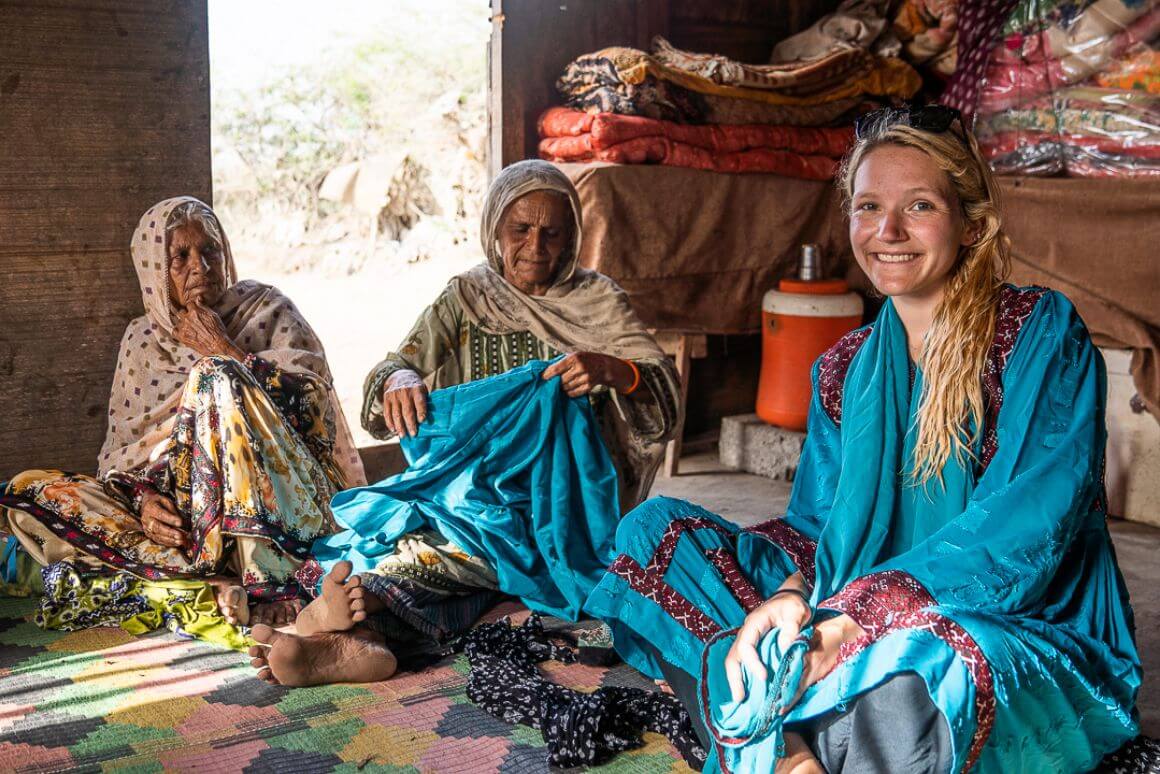
But unless you have a hard deadline to meet, take it easy out there. The whole point of overlanding is to experience the route, not just each individual destination.
Take some rest days where you do nothing but take it all in. Perhaps dive into some journaling, or park yourself at a nice lake or even a beach. The road has infinite pleasures to indulge in.
6. Download Maps in Advance
Even if you’re well prepared with a local SIM card, there will undoubtedly be places without service somewhere along your journey.
Unless you have a paper map like the kind I used to travel with back in the day, get all your necessary navigation downloaded and ready for use when you find yourself with a solid data or Wi-Fi connection.
7. Use Google Translate or Dictionaries
While English speakers are pretty privileged in that we can get by in most of the world, most does not mean everywhere. Take Central Asia for example where Russian rules – you’re going to need some assistance.
While learning a bit of the language in advance is certainly helpful, Google Translate’s offline abilities have truly saved me many times, and it’s a free app you should definitely download. The old-school dictionary method is useful too, especially if you plan to spend time in one place or region for a while.
Overland Travel Packing List
While your specific adventure packing list may look different depending on your method of overlanding, these are a few universal expedition items that anyone will need on the road.
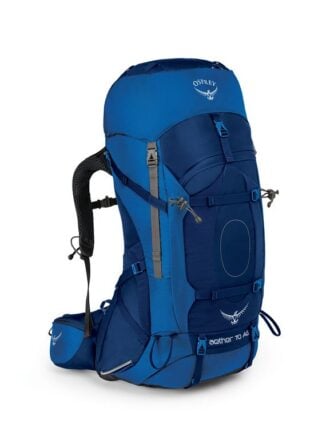
Osprey Aether 70
- Features: Stow-On-The-Go™ trekking pole attachment >
- > External hydration sleeve in backpanel
- > New IsoForm? CM™ hipbelt
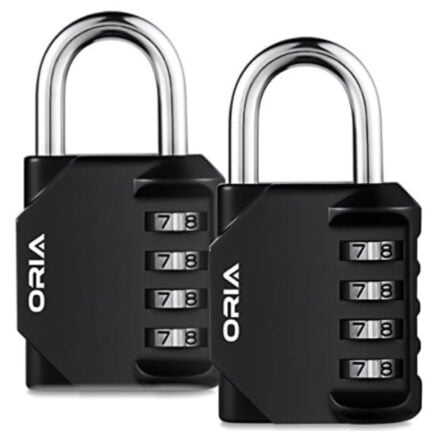
ORIA Combination Lock
- Features: 2 pack : set includes 2 zinc alloy 4-digit re-settable combination travel locks >
- > Offers 10,000 combinations
- > Small volume, light weight, fit through the holes of a lot of suitcases
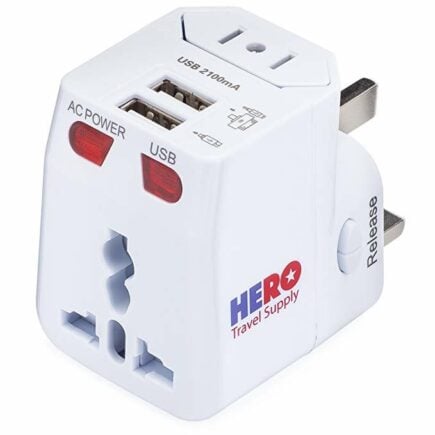
World Travel Adapter
- Features: Input socket: Euro, USA / Japan, Australia / China, United Kingdom (UK version not in Switzerland) >
- > Retractable plugs: Euro, UK, USA / Japan, Australia / China
- > Charge a laptop and two usb devices at once

- Features: Higher resolution display (300 ppi) – with twice as many pixels >
- > Built-in adjustable light – read day and night
- > A single battery charge lasts weeks, not hours
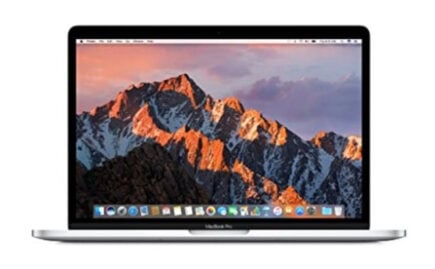
MacBook Pro
- Features: 2.3GHz dual-core Intel Core i5 processor with Turbo Boost up to 3.6GHz >
- > 8GB 2133MHz LPDDR3 memory
- > 128GB SSD storage
Where to Start Overland Travel
You can certainly overland anywhere: from somewhere as simple your home state/province to any country that calls to you, but overall I’d say these are the best places for a truly epic overland travel journey.
Central Asia
The 5 Stans are some of the most adventurous places left on this planet, and they’re home to some of the most mesmerizing roads at that. As of 2023, it’s easy for Western passport holders to travel through all of them (save Turkmenistan), and each one (Tajikistan, Uzbekistan, Kazakhstan and Kyrgyzstan) has something incredible to offer.
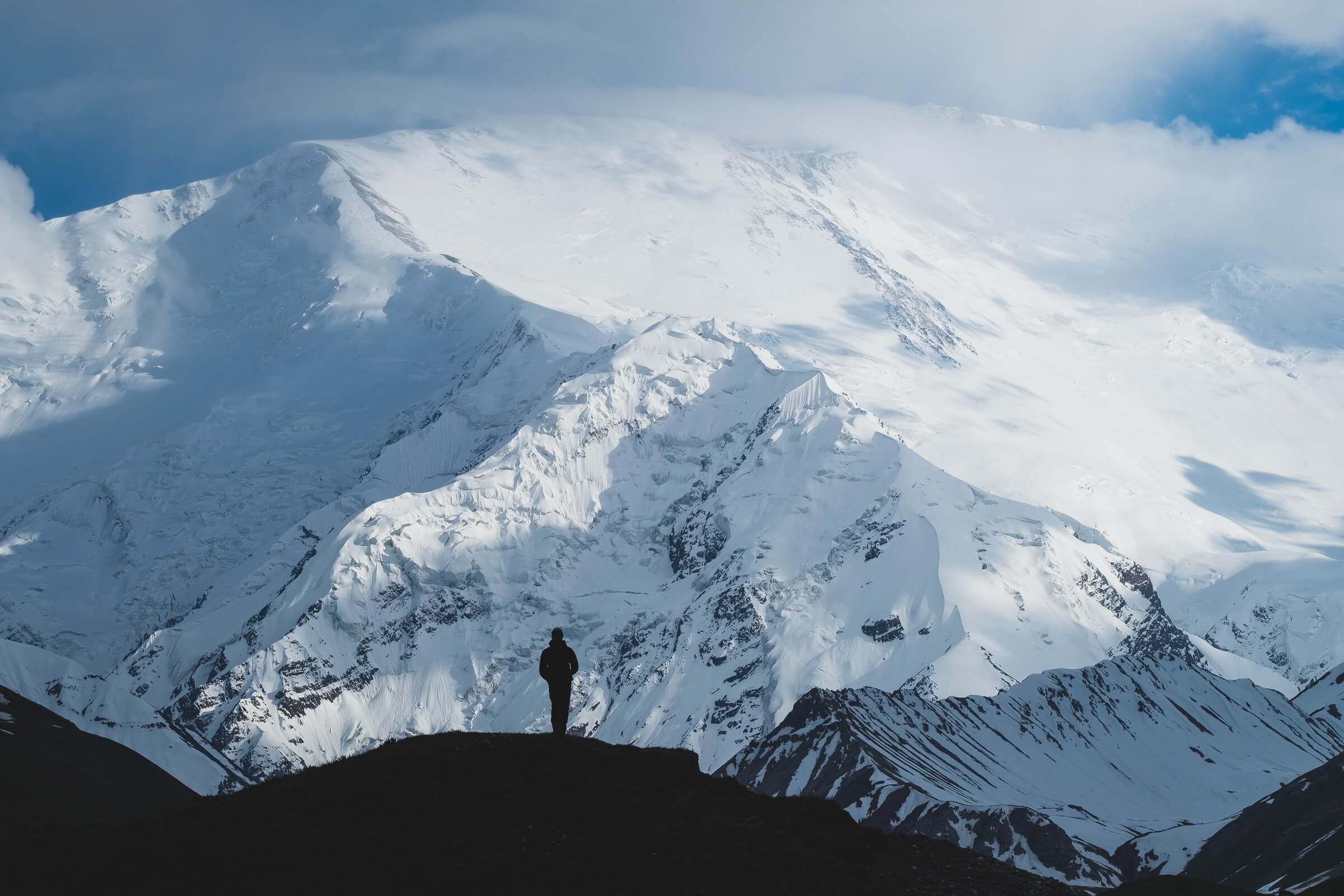
Public transport is also expensive and lacking in most of these locales, which makes overlanding that much more valuable.
All four Stans are all interconnected, safe, and essentially a big old playground for overlanders. Do not underestimate the size of this region though: I’d recommend blocking out at least 3 months to get a real feel for what it has to offer.
South/Southeast Asia
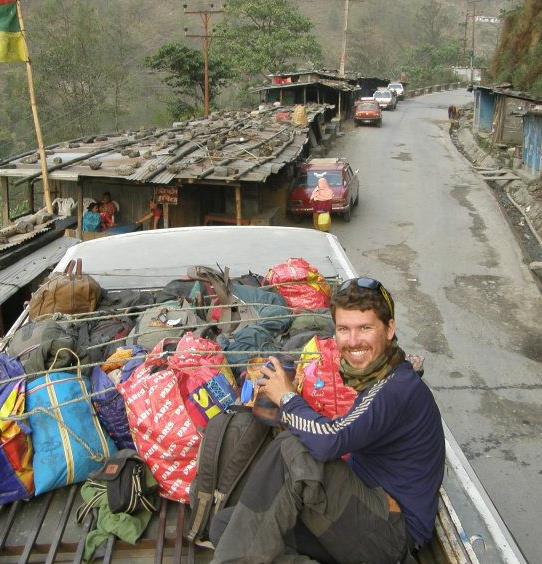
Ah, South and Southeast Asia . Home to some of my favourite countries in the world that have made the most indelible marks on my travels and my life.
India, Pakistan, Nepal and the infamous Banana Pancake trail (Thailand, Laos, Cambodia and Vietnam) are perfect places to give overland exploring a try.
Public transport is widespread, and you’ll get a feel for what it’s like to cross borders. But of course, having your own vehicle will make things even more accessible and give you access to rural areas most do not get to see.
When I rode a rickshaw around India , I found myself incredibly off trail in places that had never even seen foreigners before.
Every year, thousands of Europeans head East to Asia in their own cycles, 4x4s or by way of hitchhiking. And while the journey from Europe to Asia is absolutely epic, you can also opt to travel within the continent too.
With so many countries to check out, it may be the easiest (though certainly not the cheapest) place in the world to overland. Border crossings are simple, and so many countries are interconnected, that it’s a breeze to spend months moving about.
For Brits, Americans and other non-EU nationals, it’s key to be aware of the 90-day visa rule within the European Union. Luckily, there are some fantastic countries out East that you can visit once your time is up.
Many van lifers take to the wide open roads of the United States , with 49 to choose from (discounting Hawaii) and the ability to head north into Canada, I can see why this massive country has become so popular in the world of overland adventuring.
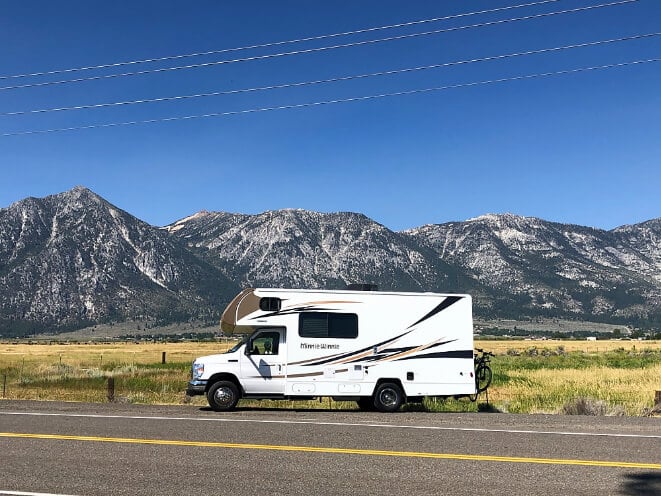
Personally, the USA is not at the top of my bucket list for many reasons, but if you’re already living there and want to get a feel for overland travel, incredible landscapes and opportunities await. Just note that public transportation and hitchhiking are definitely not recommended, as the former barely exists and the latter is not safe .
So van lifers, this is your time to shine. I know many folks who have fixed up relatively cheap vans and set out to see virtually all the states in the Union. If you have limited time or money, definitely focus your energy on the West Coast . That’s where you’ll find all the national parks and the scenery that makes the country worth exploring.
Getting Insured BEFORE Hitting the Road
Regardless of where or how you plan to overland, you should definitely sort some solid travel insurance before leaving home.
ALWAYS sort out your backpacker insurance before your trip. There’s plenty to choose from in that department, but a good place to start is Safety Wing .
They offer month-to-month payments, no lock-in contracts, and require absolutely no itineraries: that’s the exact kind of insurance long-term travellers and digital nomads need.

SafetyWing is cheap, easy, and admin-free: just sign up lickety-split so you can get back to it!
Click the button below to learn more about SafetyWing’s setup or read our insider review for the full tasty scoop.
Final Thoughts on Overland Travel
I hope I’ve now convinced you that your next trip should be an overland one. Ditching flights and committing to crossing borders and provinces on your own wheels (or by way of hitchhiking) will take your travels to entirely new heights.
You’ll have experiences that aren’t possible if you’re jetting about between places, and you’ll get to know each country and region like never before.
With so many ways to make it happen, from cycling to van life to even public buses, overland travel is something that is truly for everyone and anyone.
So what are you waiting for – get to planning and get the hell out there.
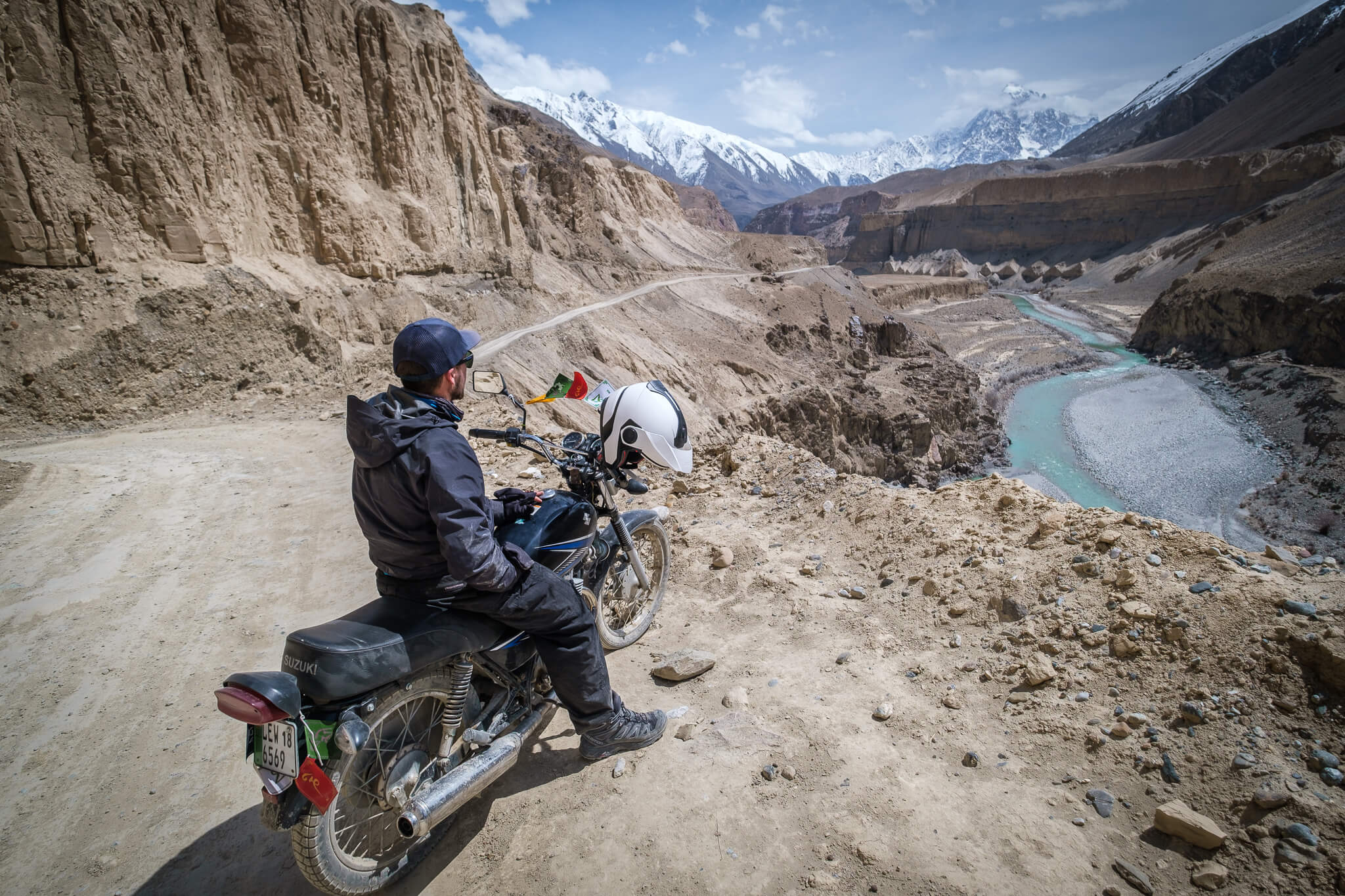
And for transparency’s sake, please know that some of the links in our content are affiliate links . That means that if you book your accommodation, buy your gear, or sort your insurance through our link, we earn a small commission (at no extra cost to you). That said, we only link to the gear we trust and never recommend services we don’t believe are up to scratch. Again, thank you!
Will Hatton
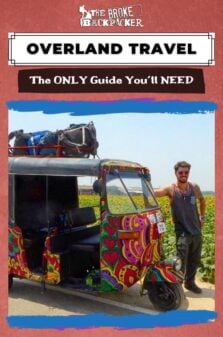
Share or save this post

Will is a freaking trooper!!! I retained great advises from this articles like: Little things we dont think about, hoard your otc in advances, travel by train, buses, mini vans, bike, download your map is a great one when you out of wifi!! Visas if we go to china or india, google translate a must have and to talk t locals and meet people on the journey, enjoy the journey more than the destination, and to buy a kindle to read if no internet, i myself always have been wanted to explore asia and reading this give me ideas on how to get there cheaper and to see the best of all places.
Leave a Reply Cancel reply
Your email address will not be published. Required fields are marked *
Save my name, email, and website in this browser for the next time I comment.
Notify me of followup comments via e-mail.
7 of the Best Overland Routes in North America
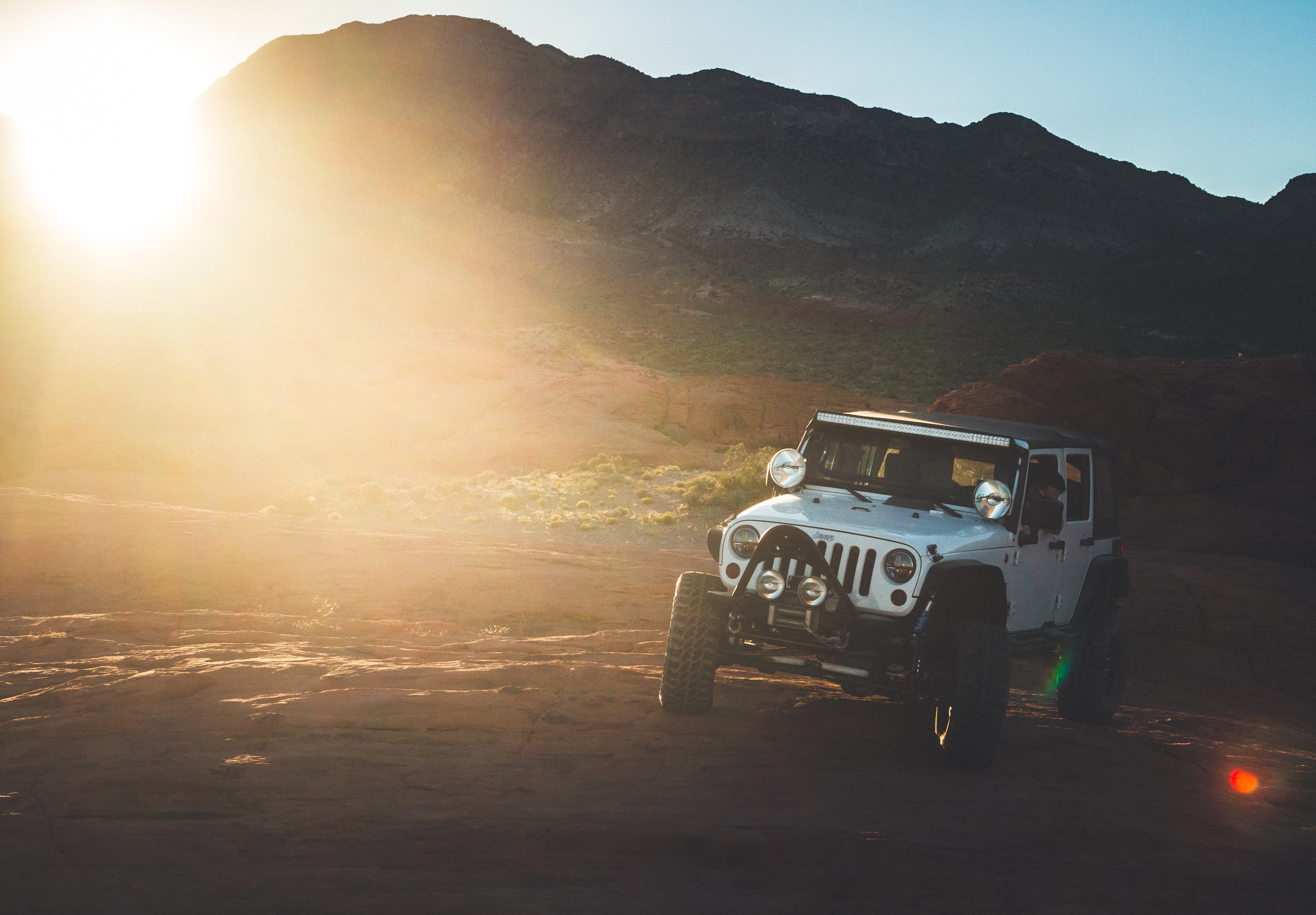
It is not a journey with a purpose. The journey is the purpose.
Originating from cattle herding, overlanding has been around for more than a century. Only in recent years has it become a mainstream sport and recreational lifestyle. Modern-day overlanding is driving an off-road vehicle across technical terrain, with a focus on the journey, not on the destination.
Many trails and roads are in remote areas that can be nearly inaccessible and require overlanders to be completely self-sufficient, that’s why we compiled seven of the best overland routes in the country to add to your bucket list.
These self-reliant, modern-day adventurers are setting out to explore the far reaches of the earth — one mile at a time. Whether you’re a seasoned overlander or itching to feel the thrill of a remote journey, the best overland routes are worth checking out. Be sure to plan your trip beforehand by using The Dyrt PRO where you can download campgrounds and maps for offline use.
From Challenging to Scenic, The Best Overland Routes Cover it All
1. the mecca: moab, utah.
View this post on Instagram A post shared by Moab Cowboy Cricket (@moabcowboy)
With old mining roads and 4×4 tracks making up hundreds of miles of trail, it’s no surprise that Moab is often considered a 4-wheeling Mecca. You can take a tour with an experienced guide, rent a jeep, or bring your own rig. With everything from easy 2-wheel drive scenic routes to adrenaline-pumping trails for the most experienced drivers, there’s something for everyone.
The spectacular red rock formations and endless trails make this rugged landscape an overlander’s paradise.
2. The Historic: The Mojave Road, California
View this post on Instagram A post shared by Maxwell Frank (@maxwellfrank)
The historic 138-mile Mojave Road takes visitors back in time. With virtually no improvements since its inception, the historic Native American trade route and wagon trail remains the same as it was 150 years ago.
Overlanders should take 2-3 days to explore the stunning desert landscape and Joshua tree-lined routes.
3. The Legend: Rubicon Trail, California
View this post on Instagram A post shared by Jeeps and Beyond (@jeep_vibe)
Another historical road to add to our list of best overland routes. The trail began through exploration for a safe route across the Sierra Nevadas. The Rubicon Trail is known for its ruggedness and versatility, inspiring the Jeep namesake. As a popular training grounds for Jeep, the overland classic has a variety of terrain ranging from beginner to expert.
Don’t be fooled by this route’s popularity; it’s still considered one of the most dangerous and difficult. Experienced overlanders shouldn’t miss this one.
4. The Infamous: Black Bear Pass, Colorado
View this post on Instagram A post shared by Jason Adams (@ifoundmyjeepgirl)
The infamous Black Bear Pass promises unrivaled views of Bridal Falls and Telluride. As one of the highest mountain passes in Colorado, it’s not for the timid. Weather conditions only allow the complete route to be open for a few weeks from late summer through the early fall. This trail earned its notoriety from steep descents with nasty switchbacks and loose falling rock.
Technical terrain and breath-taking views make this bucket list-worthy for those who crave challenges.
5. The Brute: The Dalton Highway, Alaska
View this post on Instagram A post shared by Ivan (@flyvan87)
Slightly more civilized than other trails on the list, the Dalton Highway is still no cakewalk. Crossing the Yukon River and ending at the Arctic Ocean, this road stretches for 414 miles through the wild Alaskan bush and barren tundra. Built in the 1970’s as the service road to the Trans-Alaskan Pipeline. The highway has earned fame through the controversy of the pipeline and the reality show “Ice Road Truckers.”
With steep grades, avalanche danger, and hundreds of miles between gas stations, this brutal gravel highway is not for the faint-of-heart. Those brave enough to try will be rewarded with dramatic views and if they’re lucky, a glimpse of the Northern Lights.
6. The Wild West: The Continental Divide
View this post on Instagram A post shared by Matthew Griffiths (@toyotapilot)
Border to border adventure! Stretching from Canada to Mexico across the Western United States, this route winds through iconic American landscapes, including Glacier, Yellowstone, Grand Tetons, and the Rio Grande National Forest.
Prepare for your overlanding trip by downloading maps . The Dyrt PRO lets you download maps and campgrounds without cell service. “My alternative to using pro would be to drive back out to cell service.”
With a wide variety of terrain and a border-to-border showcase of some of most beautiful American wilderness, it’s easy to see why it’s often referred to as the Great Divide .
7. The Colossal: The Pan-American Highway
View this post on Instagram A post shared by Follow The Hound (@followthehound)
Since you already made it to Prudhoe Bay on your Dalton Highway expedition, you might as well turn around and head south — really south! If you have the time, resources, and dedication you can complete the colossal 18,640-mile Pan-American Highway. If earning some miles is your goal, then you can drive from the Arctic Ocean in Alaska to Ushuaia, Argentina at the southern tip of South America.
The Pan-American Highway promises to be the road trip of a lifetime.
Wherever your trails take you, stay safe and stay connected. This article is brought to you by our friends at Midland Radio, and they’re experts in staying connected when you’re off-grid. Check out their Micromobile GMRS Two-Way Radios for staying in touch with your pals on your next overland trip.
Related Campgrounds:
- Loon Lake , Douglas County, CA
Popular Articles:
- Get the Latest 2023 Camping Travel Trends
- How To Find Free Camping in National Forests
- The Checklist Every First Time RVer Needs
- Find Free Camping With The Dyrt Map Layers
- The Ulimate Boondocking Guide To Free Camping
- Everything You Need To Know About Wifi For Your RV
- 7 of The Best Overland Routes in North America
- 14 Wilderness Survival Tools You Should Have in The Backcountry
- Here's What To Add To Your Primitive Camping Checklist
Kayla is an award-winning outdoor photographer and published author who's enthusiastic about travel and storytelling. She loves to ski and hike, and is alway looking for a new outdoor adventure. She is passionate about increasing women’s participation in the outdoors.
More Articles

18 Hacks For Storage and Comfort in a Camper Trailer
Shari and Hutch live on the road full-time in their vintage “canned ham” camper trailer. Every Thursday, they’re bringing us stories from the road. This week, Shari…

RV Travel Makes it Easier to Master the "Four M's" of Retirement
Years before our parents, Jim and Margaret, retired from careers that put four kids through college, they came up with a plan they called “The…

EarthCruiser

- Our Company
- Global Heritage
- Our Approach
- Meet The Crew
ec adventure
- About EC Adventure
- Find an Adventure
- Frequently Asked Questions
- Log In to Your Account
- Get Support
- Owner's Forum
- (541) 706-9101
- Bend, OR, USA
- [email protected]

- October 23, 2022
Overland Route Planning: How to Design the Perfect Trip
Ellen Wayte
Share this post:.
It sounds simple enough. You have narrowed down the seemingly endless list of places you’d like to go overlanding and have even figured out when you’d like to go. Now you just need to plan your route. Where do you begin? What resources are available to help with your research? What does an ideal route even look like? Designing a good trip is more than just connecting the dots between the start and finish. If you get it right, you’re hitting the area’s highlights and some off-the-beaten-path experiences. You’re spending just enough time behind the wheel every day to arrive rested and ready to explore, and you’re always prepared with enough fuel and supplies. If you get it wrong, you could find yourself running out of gas, feeling tired and stressed, and missing the very things you set out to see. The good news is that are loads of resources available to help you plan your adventure. Here are a few of my tips for creating the perfect itinerary:
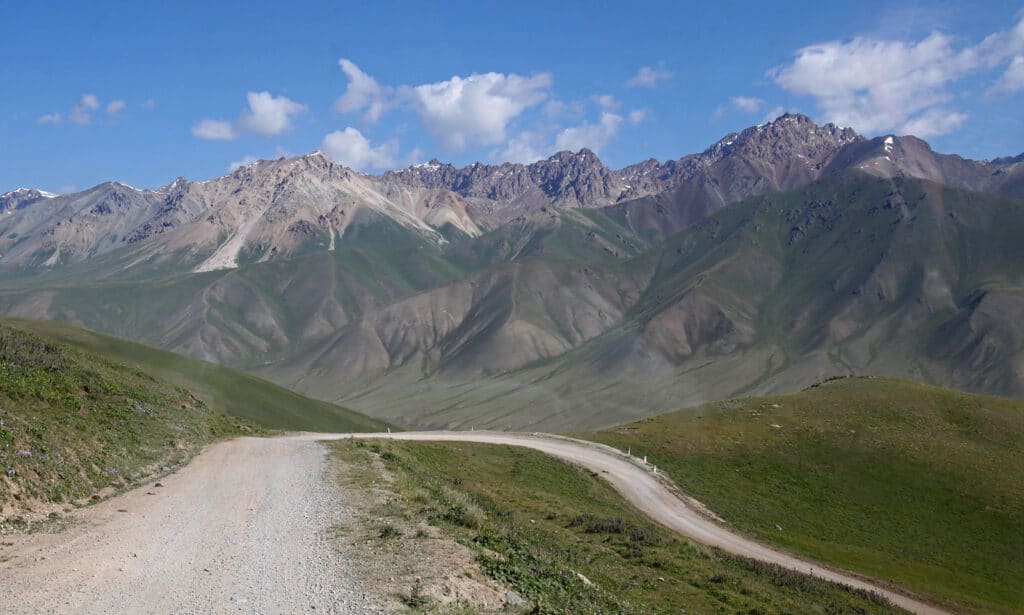
Link Your “Can’t-Miss” Destinations, or Borrow an Established Route
There’s a reason you’re drawn to a particular destination. Perhaps it’s epic scenery, a hidden waterfall you heard about, a challenging road you saw on YouTube, or incredible wildlife you’re hoping to photograph. I start by listing the top things that made this destination appealing and roughly plot a route between them. Allowing Google Maps or your navigation system of choice to pick the route between these points will give you a preliminary idea of your trip and how many days you’ll need to plan to see everything. From there, you can expand your trip by filling in stops and detours to break up long drives, take more interesting roads, and explore those hidden gems you’ll discover during your research.
There are a number of good apps these days that can assist in this process. I generally use a combination of them, along with a paper map, to plan my routes. I love the precision with which I can design a path on Gaia’s app and find much of their road and trail details to be accurate, particularly for domestic destinations. Gaia also makes sharing routes with other users and platforms easy. I use onX for information such as the boundaries of public and private lands. onX Hunt is particularly good for examining such designations. It is also helpful in determining road accessibility, going into such details as noting the location of fences and gates. On the trail, my Garmin is indispensable for keeping me oriented to my route.
Don’t have a list of sights in mind or don’t have the time to plan in detail? There are loads of established routes through almost everywhere in the world. If you’re new to overlanding, these are a great way to get your feet wet. Overlandtrailguides has loads of sample trips laid out in great detail. The internet is full of helpful people eager to share their routes via platforms such as expeditionportal.com, overlandbound.com, and the Overlanding Subreddit. Backcountry Discovery Routes have been established throughout much of the west. However, it’s worth noting BDRs were established with adventure motorcycling in mind, and not every route may be accessible with larger vehicles.
Another trick I use is to look at the itineraries of commercial travel companies, specifically those that travel via vehicle. Companies such as Intrepid, G Adventures, and dozens of smaller outfitters have been running overlanding trips worldwide for decades. Their routes are tried and true, meaning you can be confident there is a place to camp at the end of each day, the roads are generally accessible, you’re hitting the highlights, and each day’s drive is a realistic length. Following these routes will mean you’re sharing them with others. If that’s not your style, they can still offer a good starting point from which to add some off-the-beaten-trail diversions.

Determine What a Perfect Day Looks Like for You
Know thyself. When planning a trip, it’s critical to be realistic about your habits and health. I need a good cup of coffee in the mornings and am prone to getting hangry if I try to push on without a snack. I know I start to get tired and my attention wavers on long, straight stretches of highway without a break—similarly, a couple of hours of technical driving over rough roads can feel as exhausting as a full day on asphalt. My perfect day means getting up at sunrise for a quick breakfast and being on the road within an hour. I like to plan a stop every two hours or so for a snack, refuel, walk, or photo op. I try to plan so I’m not behind the wheel for more than 4-6 hours per day. My general rule is that I like to arrive at camp by 4 pm. I hate driving at night, especially in international destinations where animals like to warm themselves on the road after sunset.
I generally prefer a good, dispersed camp, away from other campers and with a gorgeous view of nature. I also appreciate occasionally camping with others; meeting fellow overlanders is part of the fun, and it’s a great way to pick up tips on the road ahead. Every week or so, I like to stay someplace where I can do laundry and resupply. Sometimes this means staying in a hotel, homestay, or campground. In my book, this isn’t cheating. It’s self-care that keeps me happy, healthy, and safe.
Some days there’s no choice but to put in more hours on the road – there might be no safe or available places to camp between two points. I try to plan for a shorter drive, or even a full day of rest, the following day to make up for the times this is unavoidable. I find inserting the occasional flex day into an itinerary to be a huge help. It can relieve the stress of trying to make up for lost time should you find yourself stuck in the mud for an afternoon or bogged down by the overlander’s other nemesis: bureaucracy. Plus, if you don’t need that day to make up for delays, you can always use it to rest or spend more time someplace unexpectedly delightful.
There is no right or wrong way to overland – only what’s right or wrong for you. So, think about your travel habits and plan accordingly. Avoid the temptation to veer too far outside your plan just to tick off as many places as possible. You’ll be happier arriving fresh and rested with adequate time to enjoy a few highlights. In six years of running overlanding trips, I never once heard someone say they wished the itinerary had gone faster.
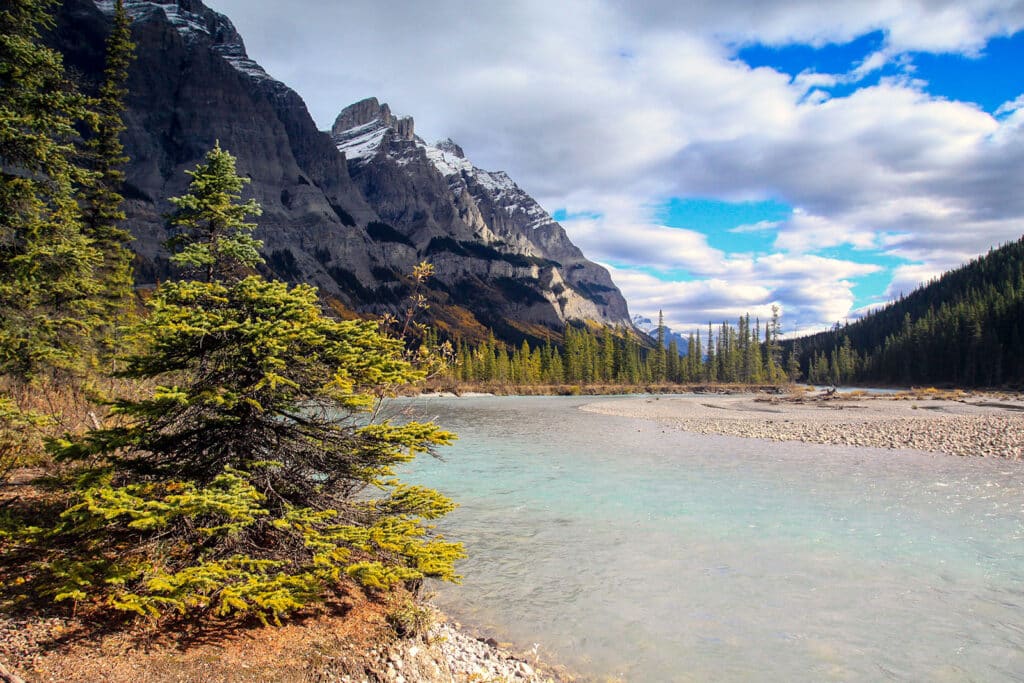
Plan Your Night Stops
Now that you have a list of the highlights you can’t miss, a rough shape of the route you’ll take between them, and what the perfect typical day will look like, it’s time to start putting it all together. To do that, you’ll want to plan where you’ll spend each night. For that, you’ll need a general idea of how long it will take you to cover each section of the drive.
Knowing how long it will take to cover a section of road requires you to understand both yourself and your vehicle’s capabilities. Google Maps is generally great for determining drive times for paved roads, assuming your vehicle is capable of highway speeds and you are a reasonably average driver. Once you leave the tarmac, things get more interesting. You want to have a good understanding of the capabilities of your vehicle, its ground clearance, approach and departure angles, width, height, and turning radius. How does it handle in deep sand, snow, and highway conditions? Even knowing all these things, short of having driven your route previously, it’s challenging to determine if off-road routes are accessible by your vehicle and skills and how long they will take for you to travel.
One place to begin is to see if a particular road or trail is rated. There are various rating systems for off-road driving routes out there. One common system rates trails as green (easiest), blue (more difficult), and black (most difficult). Others use numerical systems from 1-5 or 1-10. You can find these ratings via internet searches on off-road forums. The BLM and Forest Service produce maps of popular off-road routes with ratings. These systems take into account a route’s grade, road width, tightness of turns, surface type, and the size and type of obstacles. Generally, a rating will reflect the road’s most challenging section or element. So, a graded gravel road that contains one very steep shelf will usually be given a difficult rating even though the rest of the road is easy. There are a lot of factors to consider, and differences in vehicles, driving experience, and weather/time of year can all dramatically change drive times and experience. This means you must take these ratings as a general guideline rather than a firm set of rules. Difficult roads, which become more rock crawling than driving, can reduce one’s speed to as slow as 1-5 mph.
There are a couple of ways to gather more information on the condition of the route you’ll be driving. One is to take a detailed look at satellite imagery in your choice of mapping platforms. Zooming into a road on Google Maps can’t show each rock and pothole, but it can give you a very good idea of how tight turns are, where washouts are likely to occur and if there are significant hazards along the way. In the era of social media, you might be amazed to discover just how often you can find video documentation of someone driving your intended route. If a route is particularly challenging, there’s a good chance someone has recorded it and uploaded it to YouTube. There’s no better way, other than driving it yourself, to get a feel for what a road looks like. If you’re still unsure, hop onto one of the off-road internet forums and ask if anyone’s driven it lately. Overlanders love to help other overlanders.
You’ll also want to keep in mind what kind of fuel economy your vehicle gets in each of those conditions – there’s nothing worse than picking a beautiful route only to find out it leaves you 50 miles short of a fuel station. If you will need to restock on groceries, empty your blackwater tank or fill up on fresh water, make sure you add stops at appropriate intervals. I map out water sources, gas stations, and grocery stores at least double the frequency I think I’ll need them, especially for rural or remote routes.
Now you’re ready to start mapping out where you plan to spend each night. iOverlander remains a fantastic resource for finding places to camp. Just hop on and browse the map. Note how often and recently the information was updated. If no one has reported on a site in over a year, or it’s only been updated once or twice, consider that a red flag. Proceed with caution and plan a few backup sights, just in case. I like to confirm dispersed campsites by looking at onX to ensure it’s not on private land and then again over at the public lands authority for that area. There I’ll check on rules for dispersed camping, campfire use, and road closures. Of course you can always pioneer your own site for the night. Just be sure to check that it’s legal and safe to do so and give yourself a good cushion of extra time to allow for searching for a site. Google Earth is invaluable for finding pullovers that might be suitable for a night stop.
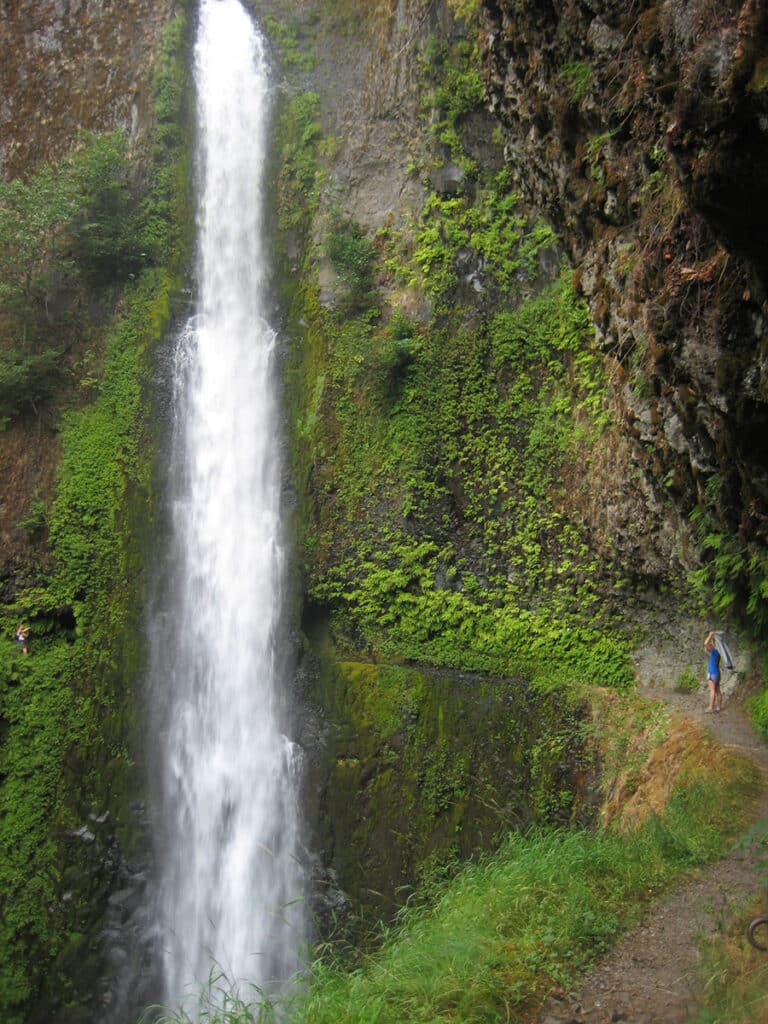
Fill In Your Route with Hidden Gems
You’re almost ready to hit the road. The last thing I like to do is fill in my trip with bonus experiences, those little hidden gems that can make a trip memorable: a secret swimming hole for a mid-drive dip, a cute little restaurant in a small town, or a short hike to an epic viewpoint. So, how do you find these? I have a few pointers:
As a wildlife enthusiast, I research the best places to look for animals via citizen science apps like eBird and iNaturalist. I’ll also check out itineraries from commercial wildlife tours for suggestions and follow wildlife photographers on social media for ideas. I open the AllTrails app whenever I’m planning an overland trip. It’s fun to browse the hikes listed along my chosen driving route. A day hike is a favorite way of mine to break up a long drive, and trailheads can be excellent night stops. AllTrails is also increasingly adding off-road driving routes to its database. Atlas Obscura’s website is full of offbeat and quirky places to explore. I always make it a habit to check their website to see if there is anything listed along my chosen route worth visiting. Ghost towns, hot springs, and waterfalls are always worth a quick stop in my book.
One of the best things you can do while overlanding is to make friends. Share your campfire with the adventure motorcycle guy who got caught in the morning downpour, and he may give you the coordinates of the amazing, dispersed camp he found down the road. Ask the campground proprietor about their favorite route or where they go with their family on their days off. Not only do you have the chance of scoring some great recommendations, but these same people might also be the ones you can count on if your vehicle breaks down, you get sick, or you need a friendly face after a long day on the road. The same goes for park rangers and local law enforcement. Too often, we’re conditioned to think of authority figures as only there to spoil our fun or hand out tickets. I’ve found they’re frequently quite eager to share their personal favorite spots with a friendly, respectful traveler. Plus, you’ll know it’s a safe and legal place to visit.
In the end, if you’ve planned well, you will most likely have seen and done everything you set out to do. You’ll have felt happy, stress-free, and relaxed. But this is overlanding, and the very nature of this kind of travel means things sometimes don’t go to plan, no matter how well-prepared you are. Freak floods wash out roads, cranky customs officials hold your paperwork for hours, or you pick up a bad batch of fuel at a dodgy gas station in the middle of nowhere. I always try to remind myself that it’s not an adventure if everything goes perfectly, and it’s often the things that go off-plan that build the most cherished memories.
find more inspiration
More articles.
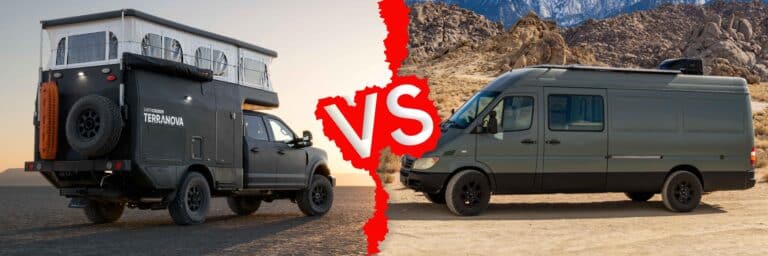
Adventure Van vs Terranova – Which is Right for You?

The GMC EV HUMMER EarthCruiser’s Journey to Chicago

Iphone Camera Tips with Terranova Owner Bruce Costa, Part 2

iPhone Camera Tips with Terranova Owner Bruce Costa
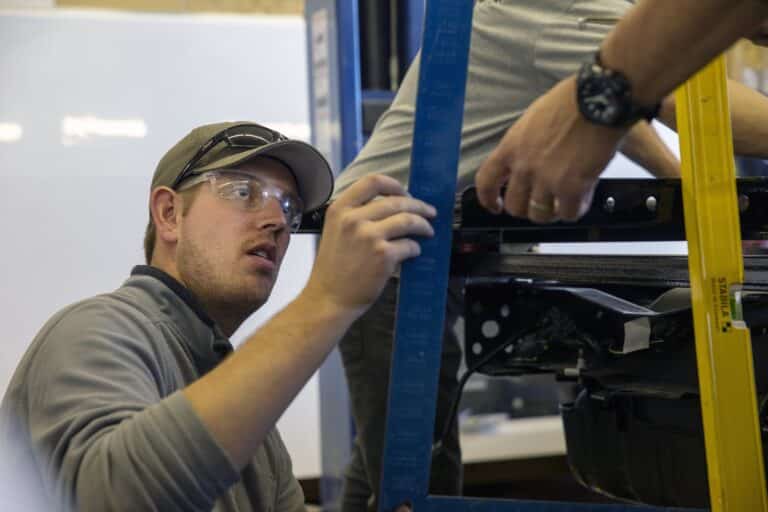
EarthCruiser Launches New Division: EarthCruiser Innovation
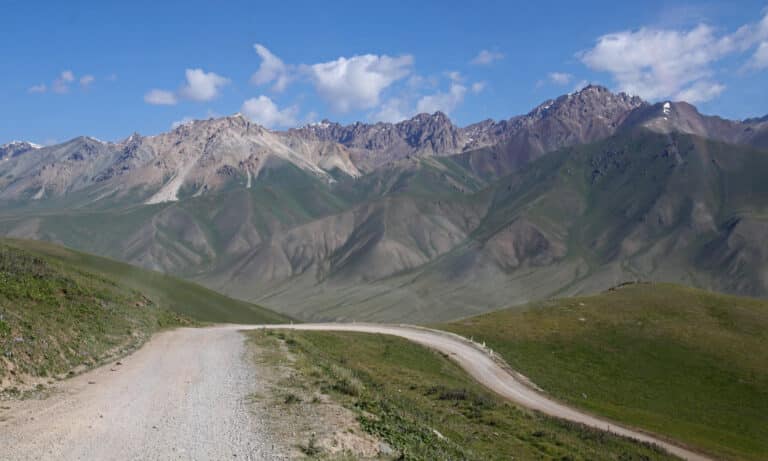
Eight Overlanding Destinations to Visit in 2024
Stay in the know, sign up for the latest news & updates.
© EarthCruiser 2024 EarthCruiser Overland Vehicles. Web Design by Structure.
Stay In The Know
Sign up for the latest news & updates.
© EarthCruiser 2020 EarthCruiser Overland Vehicles
- Skip to primary navigation
- Skip to main content
- Skip to primary sidebar

4WD Reviews, News, and Information
The Best Overlanding Trails and Routes in the US
by Jerry Ford | Last Updated February 2, 2023 | 10 min read

Overlanding is fast becoming one of the most popular American outdoor recreational activities for nature enthusiasts, gearheads, and off-roaders. This unorthodox form of camping is less about the camp spot and more about taking the road less traveled to get acquainted with the backcountry of some of the most scenic routes in the nation.
While there’s nothing like being close to nature in any venue, there are some locales considered more breathtaking than others. To give you some goals to shoot for, we’ve compiled a list of the top 10 overlanding trails in the United States.
What Makes a Great Overlanding Trail
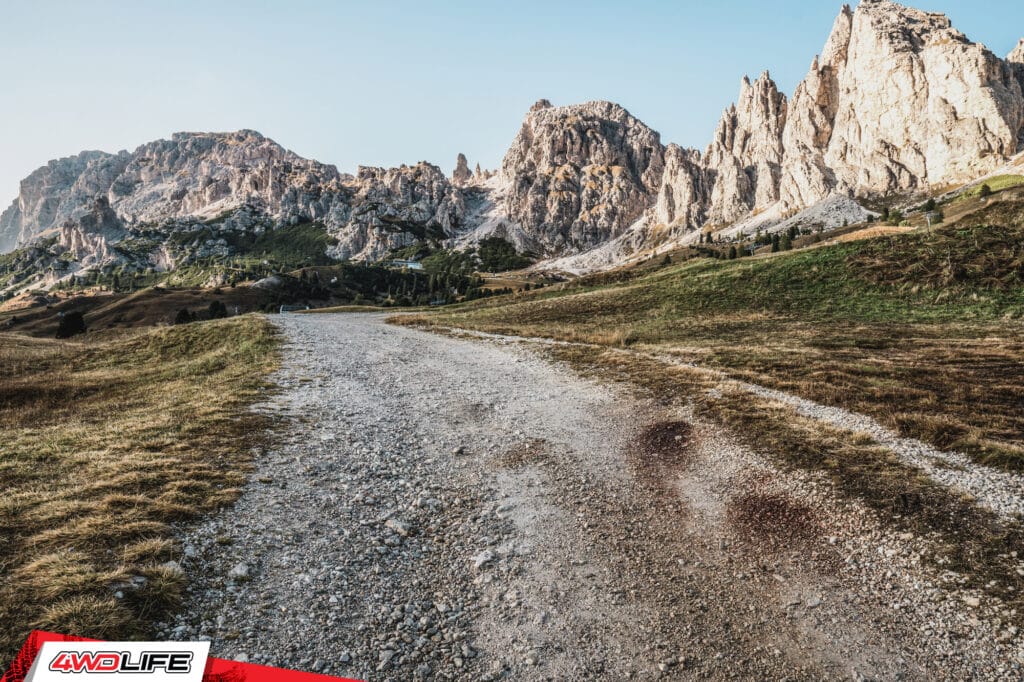
So what makes an overland route memorable? Certain characteristics have the potential to shape the difference between a good overland adventure and a great one. Although every overland route expert has their own personal preference, there seems to be a general consensus over what outlines the top overland trails.
The best overland routes should:
- Include several types of trails/paths for the rookie and the experienced driver
- Have some incredible views, preferably from higher points
- Be far enough off the beaten path so it doesn’t become saturated with tourists
- In an area that gets all four seasons
- Has varying degrees of wildlife and plantlife
Again, everybody is different when it comes to their ideal overlanding routes. However, most adventurists could agree that the above features make a great overland excursion.
10 Overlanding Trails in North America to Try
Follow along with our top 10 adventure trails North America has to offer.
1 – Chicken Corners Route

- Location: Moab, Utah
- Total Distance: 9 miles
- Estimated Time to Complete: 4 Hours
- Best Time to Travel: March-November
The location of Chicken Corners contains some of the most heart stopping overland routes in general. Moab is a rugged, scenic oasis that will definitely get you used to some intense overlanding routes. Located in Canyonlands National Park, one of many in and around Moab, Utah, this is a classic route seen on documentaries and even auto manufacturer commercials. Surprisingly, this is considered a moderate-rated trail despite the high elevation, narrow pathways, and cliff edges.
2 – High Water Mark Trail (Ozark Overland Trail)

- Location: Ozark Mountains, Arkansas
- Total Distance: 140 miles
- Estimated Time to Complete: 2-3 days
- Best Time to Travel: Fall
Located partially in the Ozark National Forest, the High Water Mark Trail is a longer trek, with the exact route taking up to three days. You’ll journey through national forest land in your off-road vehicle, weaving through the partially paved trails and encountering mud-covered logging roads that are extremely tight. The highlight of this overlanding route is the fact that it has 12 water-crossing areas, so bring your winch and recovery gear. It’s also the gateway to the Western United States, as the terrain gets noticeably different west of this area.
3 – Enchanted Rockies Trail
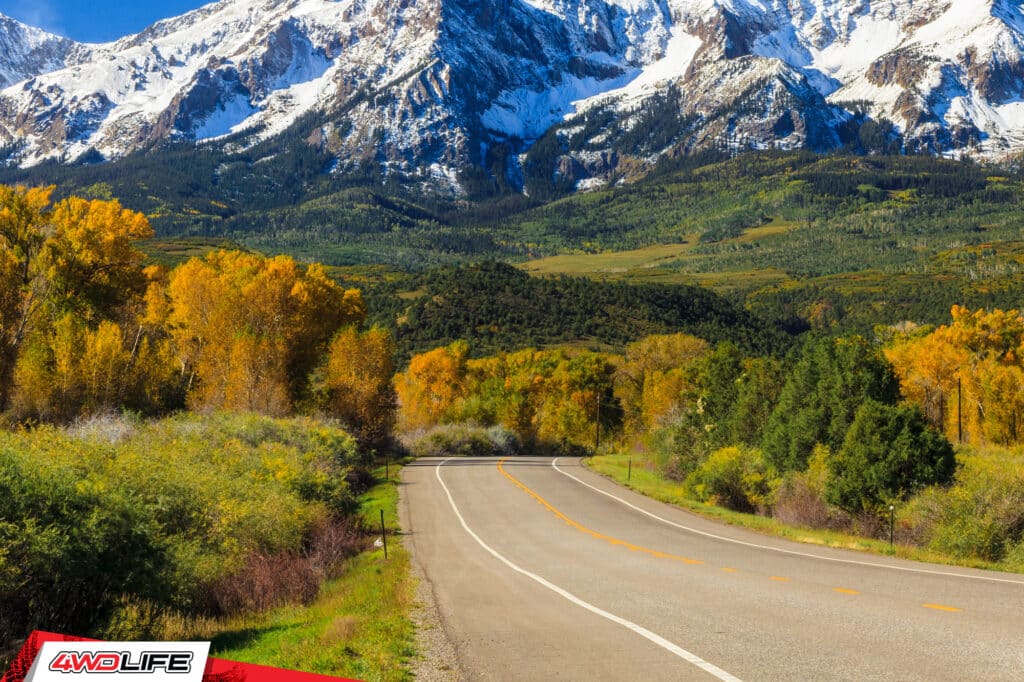
- Location: Queen, New Mexico to Estes Park, Colorado
- Total Distance: 1,200 miles
- Estimated Time to Complete: 1-2 weeks
- Best Time to Travel: Late June to early October
This CO distance trail makes for a great overlanding trip with the family. While there’s still plenty of off-roading excitement, you can definitely find overlanding trails that are more for the adrenaline junkie type. This mostly tame trail goes on for an incredible distance – and can take over two weeks, depending on your speed and conditions. During the winter, conditions can deteriorate quickly as the dirt roads on the steep grades freeze and then turn to mud. It’s mostly off pavement, but tightly packed gravel roads don’t present too much trouble.
4 – Dalton Highway
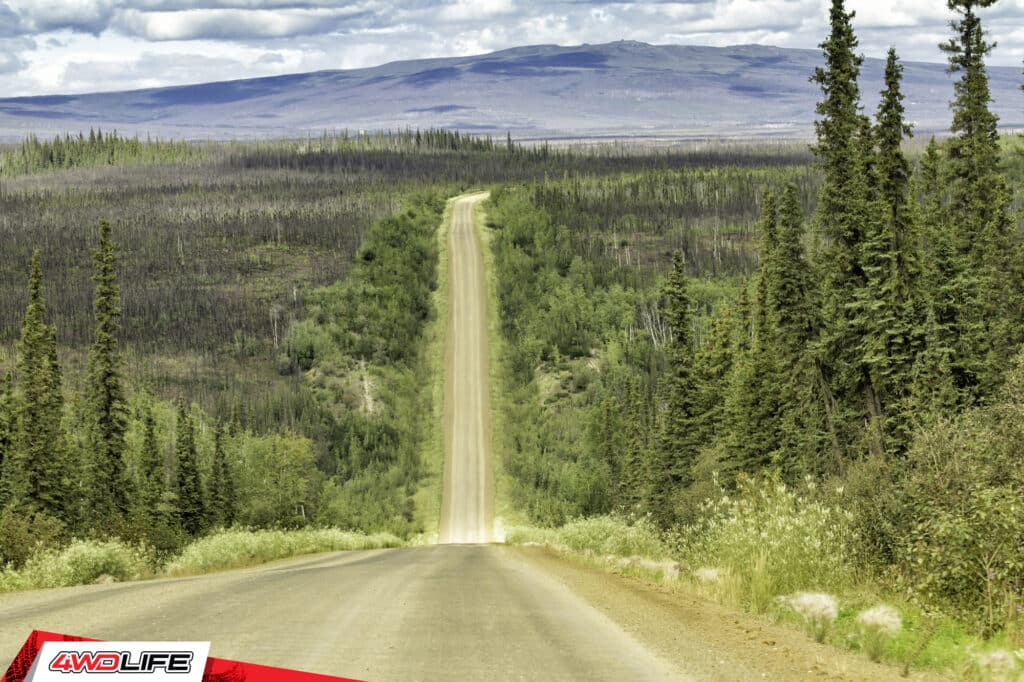
- Location: Between Fairbanks, Alaska and Deadhorse, Alaska
- Total Distance: 414 miles
- Estimated Time to Complete: 13-14 Hours
- Best Time to Travel: Summer
You’ve probably seen this Alaska distance trail on Ice Road Truckers. If you finish this long highway, you’ll end up at the edge of the Arctic Ocean, in the remote oil fields of Alaska. Traveling through Wild Alaskan bush, there’s no cell service at all on the Dalton Highway. This road runs along the Trans Alaska Pipeline and was designed solely for big rigs to deliver supplies to the oil rigs. There’s only two gas stations on the whole trip – just mostly barren tundra prone to some of the worst weather conditions on earth. If you do go – make it in March or early June, and don’t even think about taking a two wheel drive vehicle. On the upside, you’ll get great views of the Northern Lights.
5 – South Core Banks Route
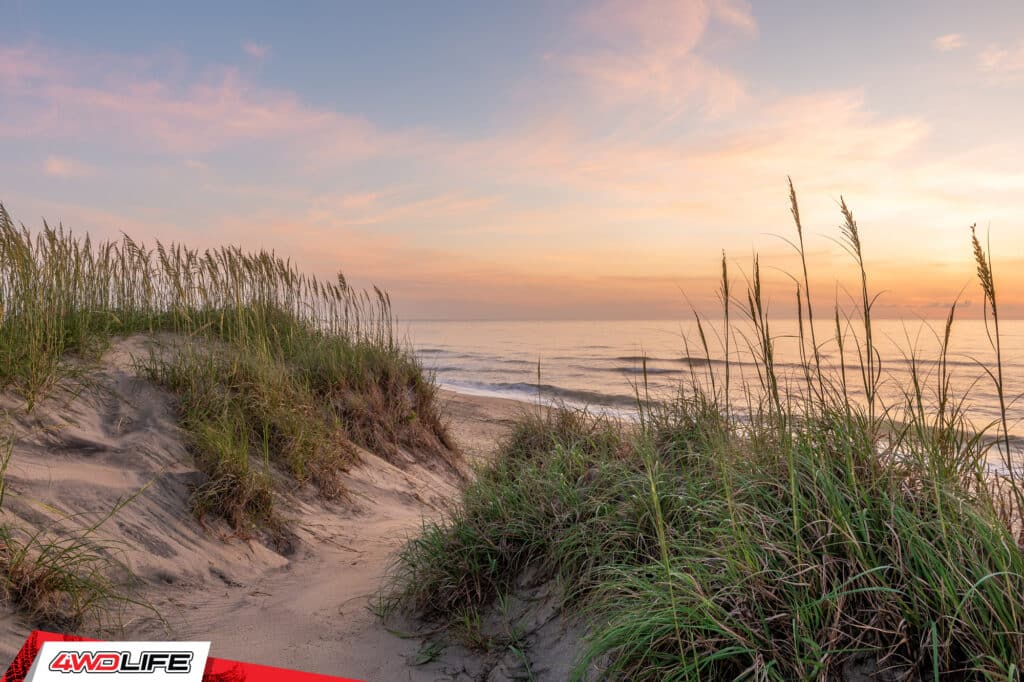
- Location: Outer Banks, North Carolina
- Total Distance: 56 miles
- Estimated Time to Complete: 3 hours
- Best Time to Travel: Summer/Fall
Explore the rich history of North Carolina’s Crystal Coast, or the Outer Banks Barrier Islands. This is a beautiful trek along the edge of the Atlantic with all sorts of stops for shelling, swimming, and ocean-side camping. One of the coolest portions of the trip is through Manteo and Roanoke Island – it’s full of pirate history from the 1500s when the feared Black Beard pillaged the area.
6 – Cape Lookout National Seashore
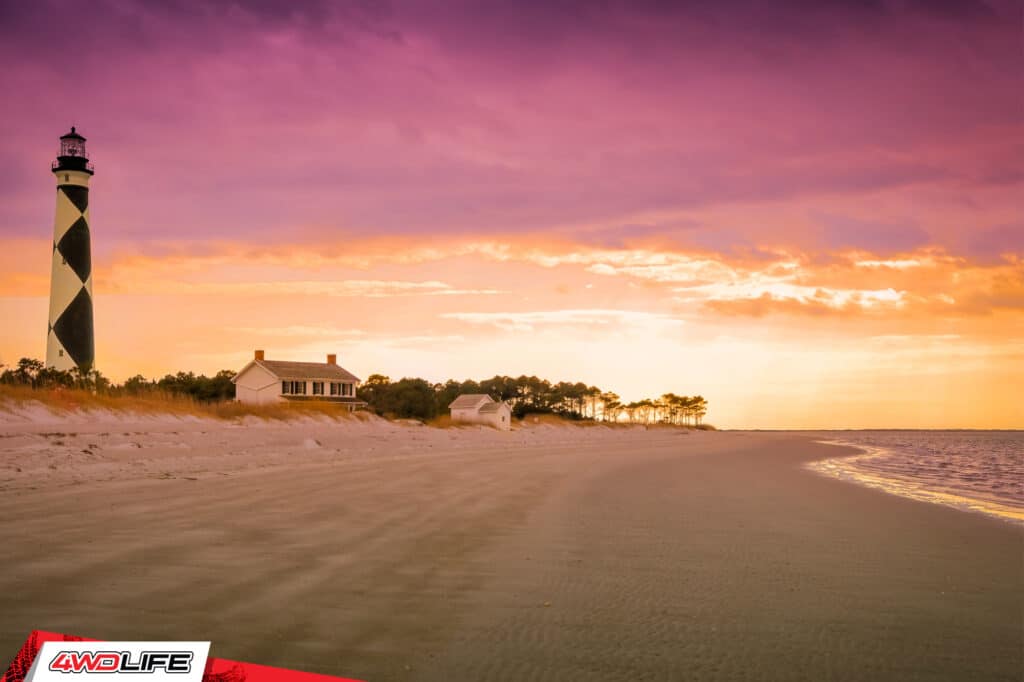
- Location: Cape Lookout, North Carolina
- Total Distance: 21 miles
- Estimated Time to Complete: 2 hours
This is another gem located at the southern portion of the Outer Banks. This is where you’ll find the historic Cape Lookout lighthouse, one of the most famous lighthouses in the US. This stretch of trail is directly on the beach – 21 miles of nothing but sand and waves, in one of the only stretches of driveable beach on the east coast.
7 – Mojave Road
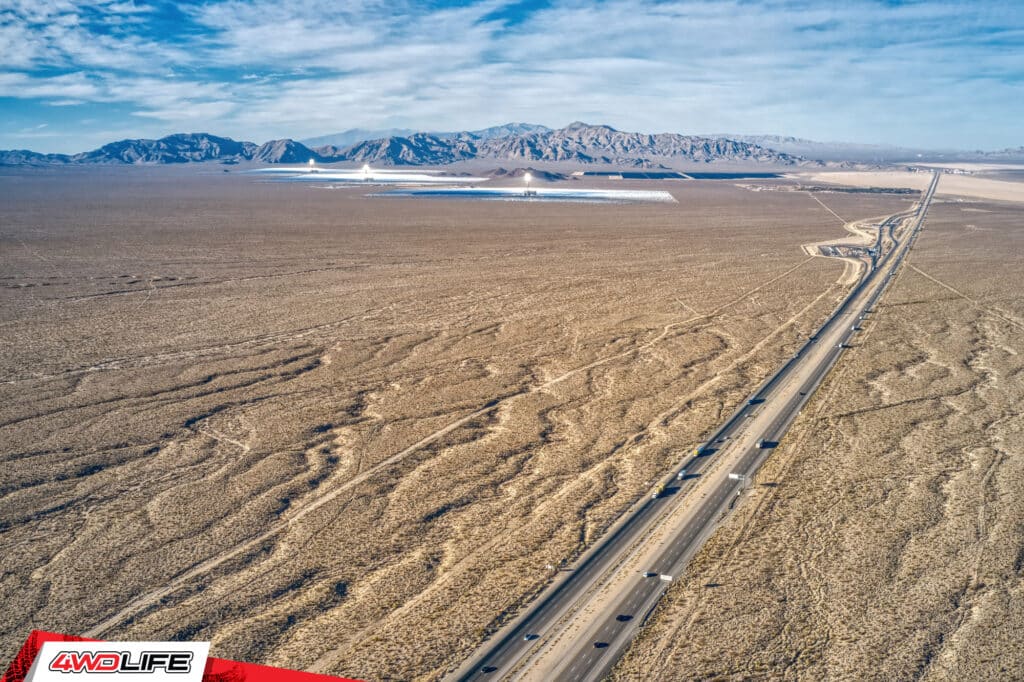
- Location: Mojave National Preserve, California
- Total Distance: 138 miles
This California distance trek winds through the Mojave Desert, where you’ll find some interesting things, to say the least. Aside from the Joshua Tree, the famous Mojave Desert has some other famous sites, including the Frog Shrine, the Mojave bus, lava flows, and dried-up lake beds. Temperatures can get well over 120 degrees during the summer, so it’s best to go during the fall weather to avoid heat exhaustion.
8 – Rubicon Trail
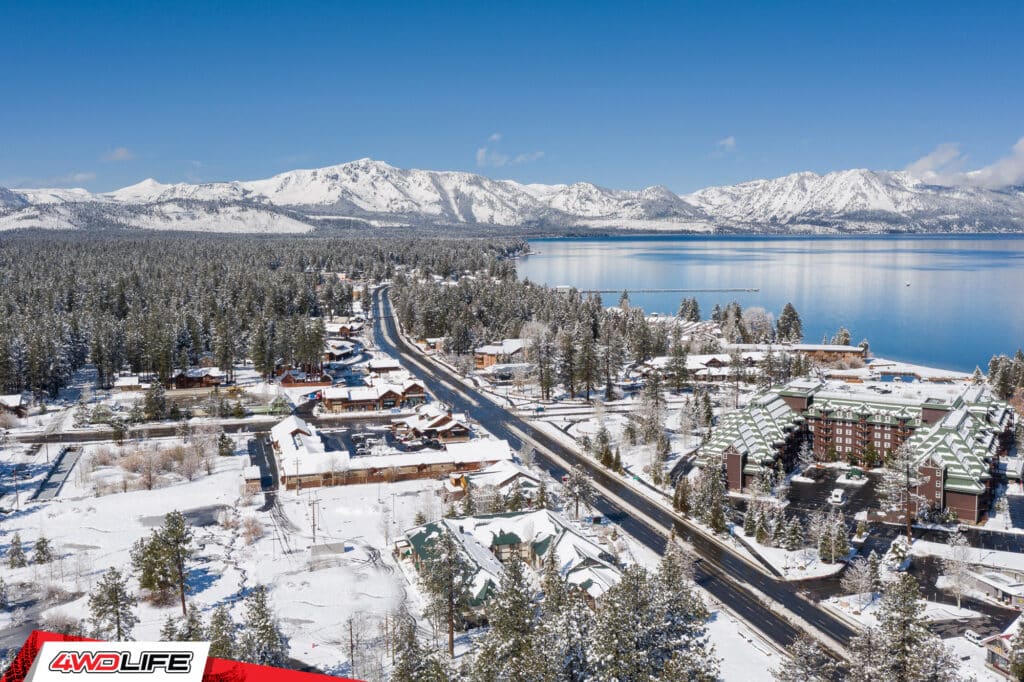
- Location: Lake Tahoe, California
- Total Distance: 16.4 miles
- Estimated Time to Complete: 7 hours
This incredible hike through one of the most famous mountain ranges in the world is nothing short of amazing. You’ll encounter places that only those who have the option of 4×4 have seen in person. You might even recognize some of the areas from photos you’ve seen in 4×4 commercials or in famous photos. Emerald Bay is one of the most scenic lakes in the country, offering views you won’t find anywhere else in the world.
9 – Black Bear Pass
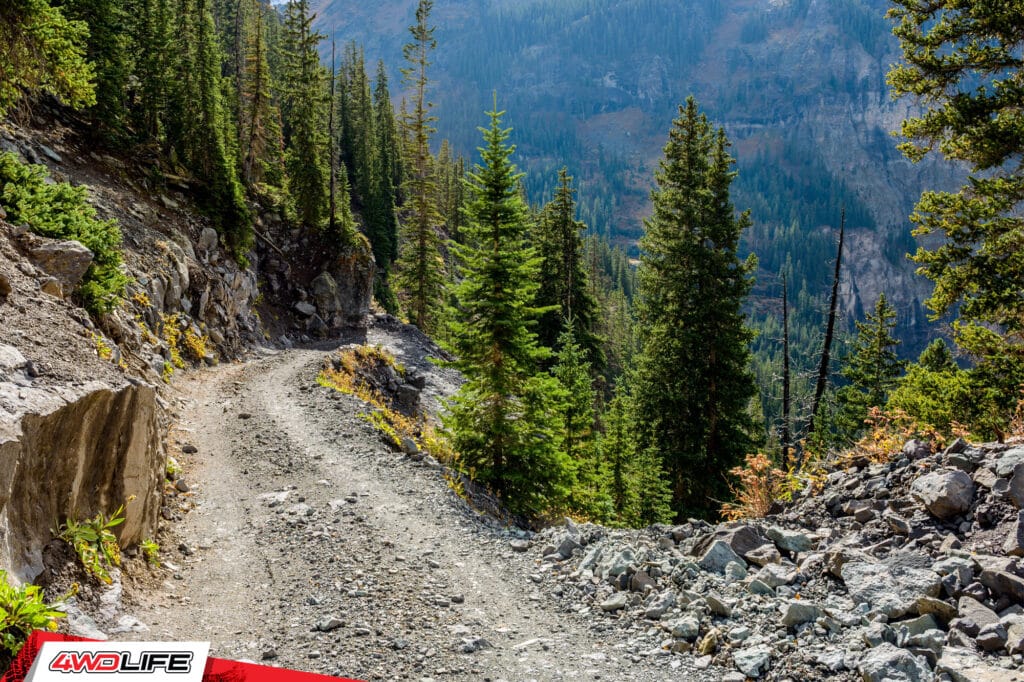
- Location: Telluride, CO
- Total Distance: 8.5 miles
- Estimated Time to Complete: 6 hours
- Best Time to Travel: July through October
This is potentially one of the most challenging trails in the entire country. Located on the Continental Divide, this is a popular destination for long-distance hikers. This path is home to Bridal Veil Falls, one of the most photographed locations in the United States. However, you’ve been warned – this trail is not for the beginner. It’s potentially one of the most difficult on the list.
10 – Pan-American Highway
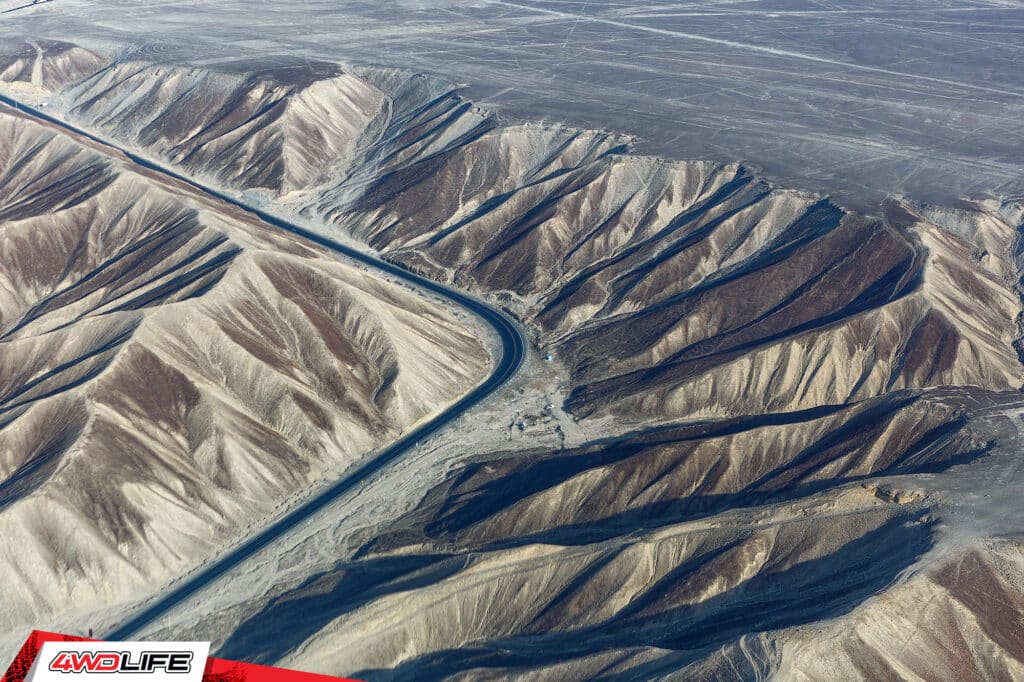
- Location: Alaska to South America
- Total Distance: 19,000 miles
- Estimated Time to Complete: Depends on your speed
- Best Time to Travel: Depends on which point you begin
The Pan-American Highway is the Superbowl of overland road trips. This series of highways connects South America and North America – with one end in Panama and the other in Alaska. It’s a total of 19,000 miles, and it will take most travelers a minimum three months, and that’s rushing things. It’s not unheard of for overlanders to take a full year to enjoy this stretch of road. It’s a grueling journey, but the reward is driving through 14 countries, seeing some of the most incredible sights the world has to offer, and meeting a versatile assortment of people while interacting with different cultures.
Preparing for an Overland Trip

Preparing for an overland excursion requires some strategic planning. Depending on where you travel, the plans could change significantly. These are some of the best tips for planning an overlapping adventure:
- Do your research. Investigate the route and traffic laws. Plan for the weather.
- Ensure your vehicle has all the right equipment. Any modifications should be done well before you embark on your journey.
- Pack your personal gear. Clothes, water, and anything else you’ll need individually.
- Get your affairs in order. Check for any permits that might be required and passports if you’re traveling to a foreign country. Inform an emergency contact and set up some type of schedule for regular phone calls to inform your contact your trip is going safely.
- Get prepared mentally and physically. An overland trip isn’t easy and can take a toll on you mentally. Get excited and get in the right frame of mind.
Conquering Overlanding Trails
Taking on overlanding trails is addicting, as you’ll soon find out if you’re a newcomer to these unique adventures. Make sure you log all of your trips and keep a photo bank of all the sights and incredible moments you encounter.
The most important thing to remember is to plan ahead, and never bite off more than you can chew. Ensure your vehicle is fully prepared for the hike in front of you, and make safety your main priority.

ABOUT Jerry Ford
Jerry Ford started his career as a freelance writer for Australian Associated Press. A wide variety of outdoor interests (off-road driving among them) brought him to car magazines. He has a distinguished career as a print and broadcast reporter and editor with over 25 years of experience writing about the car industry, best practices and new technologies.
AFFILIATE DISCLOSURE
4WDLife.com is a participant in the Amazon Services LLC Associates Program, an affiliate advertising program designed to provide a means for website owners to earn advertising fees by advertising and linking to Amazon (.com, .co.uk, .ca etc) and any other website that may be affiliated with Amazon Service LLC Associates Program. As an Amazon Associate we earn from qualifying purchases. Amazon and the Amazon logo are trademarks of Amazon.com, Inc. or its affiliates.
CREATIVE COMMONS LICENSE
Unless otherwise stated, all images on 4WDLife.com are shared under the Creative Commons BY-NC-ND License .

1-800-590-3564
We’re here to help. Call us!
Checkout using your account
This form is protected by reCAPTCHA - the Google Privacy Policy and Terms of Service apply.
Checkout as a new customer
Creating an account has many benefits:
- See order and shipping status
- Track order history
- Check out faster
Search The Blog
- Home Boosters (4)
- Vehicle Boosters (1)
- Equipment (43)
- Technology (8)
- How-To (17)
- Product Videos (1)
- Announcements (0)
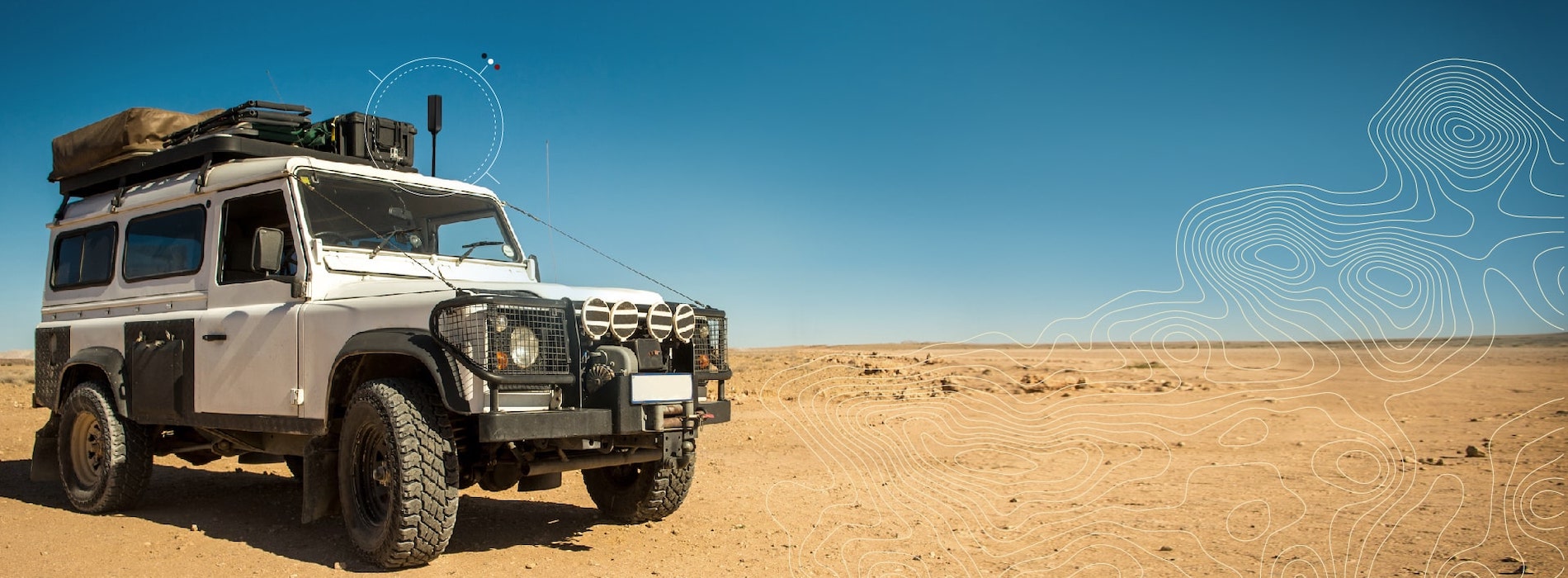
The Ultimate Guide to Overlanding: Tips, Tricks, and Destinations
By Jeff Morin on Apr 28, 2023
Overlanding has become increasingly popular among adventure-seekers and off-road enthusiasts. But what is overlanding exactly? In its simplest form, overlanding is a self-reliant, vehicle-based adventure travel that involves exploring remote destinations and being immersed in the journey itself. Unlike traditional travel, where the focus is often on reaching a specific destination, overlanding is all about the experience of the journey, the challenges encountered along the way, and embracing the unknown.
Brief History of Overlanding
The concept of overlanding dates back to the early days of automobile travel. Pioneers in the 1900s embarked on long, overland journeys to explore the vast, untamed landscapes, using rudimentary vehicles to navigate challenging terrain. These early expeditions laid the foundation for modern overlanding, which has evolved significantly with advancements in vehicle technology, navigation systems, and off-road equipment. Today, overlanding has become a way for people to escape the hustle and bustle of everyday life, reconnect with nature, and experience the thrill of adventure.
In the following sections, we'll dive into the exciting world of overlanding, from the critical role of cell phone signal boosters to the best overlanding gear and vehicles. So, buckle up and get ready for the journey of a lifetime!
The Importance of Cell Phone Signal Boosters in Overlanding
Overlanding is an exciting way to explore the world and immerse yourself in nature. However, venturing off the beaten path often means losing cell phone signal, which can be inconvenient and even dangerous. In this section, we'll discuss the importance of cell phone signal boosters in overlanding, including staying connected in remote areas, ensuring safety during the journey, and maximizing enjoyment through communication.
Staying connected in remote areas
One of the main challenges of overlanding is staying connected in remote areas. Weak cell phone signals can make it difficult to call for help, access GPS, or stay in touch with loved ones. Investing in a cell phone signal booster can greatly improve your signal, even in areas with limited coverage.
UberSignal offers a variety of signal boosters for different needs, such as vehicle signal boosters for cars, RVs , and overland vehicles . These devices work by capturing the nearest cell signal, amplifying it, and rebroadcasting it inside your vehicle. This means you can stay connected, even when you're miles away from civilization.
Ensuring safety during the journey
Safety is a top priority for overlanders, and having a reliable cell phone signal is crucial for emergencies. In case of a breakdown, injury, or other unexpected situations, being able to call for help can be lifesaving. 4G LTE signal boosters and 5G signal boosters can help maintain a strong connection, allowing you to reach emergency services or fellow overlanders for assistance.
In addition to boosting your cell signal, it's essential to equip your vehicle with other safety gear like first aid kits, spare tires, and recovery equipment. By combining these precautions with a reliable cell signal, you'll be better prepared for any challenges that may arise during your overlanding adventure.
Maximizing enjoyment through communication
Lastly, a strong cell phone signal can enhance the overall enjoyment of your overlanding trip. Staying connected with friends and family, sharing photos and experiences in real-time, and accessing information about nearby attractions can all add to the fun of your journey.
Moreover, you can use your phone to join overlanding communities like the Overlander Community by Expedition Overland , Overland Bound Community , or the Overlanding Subreddit . These platforms allow you to connect with fellow overlanders, exchange tips and advice, and even plan meetups or group excursions.
By investing in a cell phone signal booster, you'll not only improve safety and connectivity during your overlanding trip, but you'll also enhance your overall experience. Consider incorporating a signal booster into your overlanding gear to make the most of your adventures.
Types of Overlanding Adventures
Off-roading.
Off-roading is one of the most popular types of overlanding adventures. It involves taking your overlanding vehicle through rough terrain, such as dirt roads, rocky paths, and muddy trails. Off-roading is not only about conquering challenging landscapes but also about pushing the limits of your vehicle and improving your driving skills.
To fully enjoy off-roading, you need the right overlanding gear . This includes a reliable overlanding vehicle like a Jeep, Tacoma, or another 4x4 with high ground clearance, a sturdy overlanding trailer to carry your supplies and equipment, and an overlanding tent for camping in remote areas.
When planning an off-roading trip, it's essential to do thorough research on the trails and terrain you'll be tackling. Connect with fellow off-roaders through online communities like Overlander Community by Expedition Overland , Overland Bound Community , and the Overlanding Subreddit to gather valuable information and advice.
Desert Exploration
Desert exploration is a unique and exhilarating overlanding experience. This type of adventure takes you through vast, arid landscapes with stunning sand dunes, rocky plateaus, and ancient geological formations. The challenges of desert exploration include extreme temperatures, limited water sources, and potential sandstorms.
Preparing for a desert adventure means equipping your overlanding jeep or overlanding tacoma with essential gear such as a sturdy overlanding trailer and a reliable overlanding tent to protect you from the elements. It's also crucial to have ample water storage, a recovery kit for getting unstuck from the sand, and a robust navigation system.
Maintaining communication is vital during desert exploration, so investing in the best cell phone signal boosters is a smart move. Options like the weBoost Drive Reach Overland can enhance your signal in remote areas, ensuring you stay connected even in the most isolated desert landscapes.
Mountain Traversing
Mountain traversing is an overlanding adventure that offers breathtaking views, diverse flora and fauna, and the thrill of navigating steep inclines and rugged terrain. This type of overlanding requires a high level of skill and expertise, as well as a best overlanding vehicle that can handle the demands of the mountains.
When planning a mountain traversing trip, it's crucial to research the area you'll be exploring, including trail conditions, altitude changes, and potential hazards. Equip your overlanding jeep or overlanding tacoma with appropriate gear like a winch, recovery kit, and high-quality tires to handle the terrain.
A reliable communication system is essential during mountain traversing. Consider investing in vehicle signal boosters like the weBoost Drive Reach to maintain connectivity even in remote, high-altitude locations.
Jungle Trekking
Jungle trekking is an overlanding adventure that takes you deep into lush, tropical rainforests teeming with diverse wildlife and unique ecosystems. The challenges of jungle trekking include navigating muddy trails, crossing rivers, and dealing with unpredictable weather conditions.
To ensure a successful jungle trekking experience, choose a best overlanding vehicle like a Jeep or Tacoma that can handle the demands of the jungle environment. Equip your vehicle with essential overlanding gear , including a winch, recovery kit, snorkel for river crossings, and a reliable overlanding tent for camping in the wild.
As you venture deeper into the jungle, staying connected with the outside world becomes increasingly important. Invest in 5G signal boosters or 4G LTE signal boosters to maintain cell phone connectivity even in dense foliage. Depending on your carrier, you can choose from AT&T signal boosters or Verizon signal boosters to suit your needs.
While exploring the jungle, it's essential to follow responsible overlanding practices and minimize your impact on the environment. Organizations like Expedition Conservation promote responsible overlanding and can provide valuable information on how to minimize your environmental footprint during your jungle trekking adventure.
Key Elements of Overlanding Gear
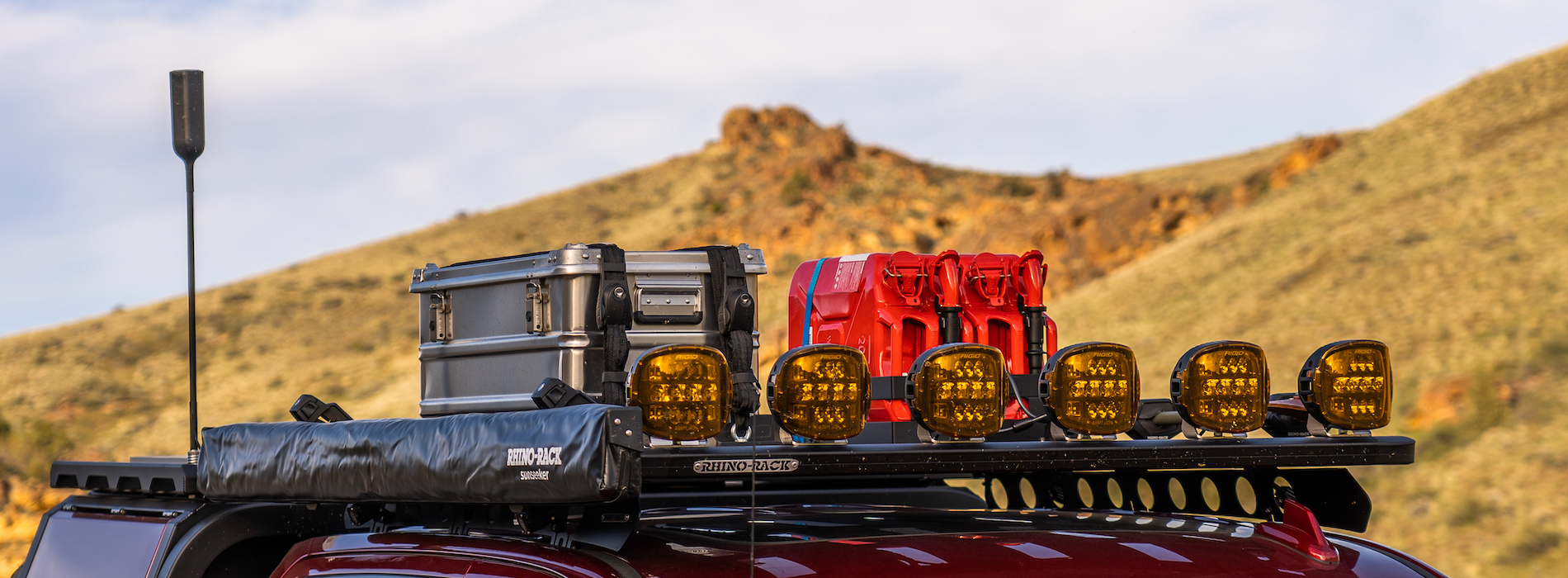
Navigational Tools
In the world of overlanding, navigation is crucial for a successful adventure. When exploring remote areas, it's essential to have reliable navigational tools at your disposal. Some popular options include:
- GPS devices: These offer accurate positioning and can be preloaded with maps and routes to follow.
- Mobile phone apps: Some apps, like Gaia GPS, allow for offline map downloads and route tracking, making them ideal for overlanding. Remember to keep your phone charged and connected using vehicle signal boosters .
- Paper maps and compass: As a backup, always carry physical maps and a compass to ensure you never lose your way.
Camping Essentials
Shelter - overlanding tents and vehicle modifications.
Shelter is an essential aspect of your overlanding gear . Options include:
- Rooftop tents: These tents are mounted on your vehicle's roof rack and offer a comfortable sleeping space away from the ground.
- Ground tents: Traditional camping tents can also be used, but make sure to choose a durable, weather-resistant option.
- Vehicle modifications: Some overlanders convert their vehicles into sleepable spaces with custom bed systems or pop-up camper conversions.
Cooking Equipment
Cooking while on the road is part of the overlanding experience. Key items to pack include:
- Portable stove: A compact stove allows you to cook hot meals, boil water, and make coffee or tea.
- Cooking utensils and cookware: Bring pots, pans, and utensils that are durable and easy to clean.
- Cooler or fridge: A portable cooler or 12V fridge is essential for keeping perishable food items fresh.
Clothing and Personal Items
When packing clothing and personal items, consider the environment and climate you'll be traveling through. Opt for lightweight, moisture-wicking fabrics, and pack layers for temperature changes. Don't forget essentials like a first aid kit, toiletries, and insect repellent.
Vehicle-Specific Equipment
Overlanding trailers.
For those who need extra space or prefer to separate their living and driving areas, overlanding trailers are an excellent option. They come in various sizes and designs, from basic teardrop trailers to fully-equipped off-road models.
Recovery Gear
Regardless of the terrain, you're likely to encounter obstacles during your overlanding adventures. As such, always pack recovery gear such as:
- Winch: Useful for pulling your vehicle out of tough spots or assisting other overlanders.
- Recovery straps: These versatile straps can help free a stuck vehicle or secure heavy loads.
- Traction boards: Also known as recovery boards, these can provide extra traction on slippery surfaces.
In addition to the gear listed above, ensure you have a reliable cell phone signal booster, like the weBoost Drive Reach or weBoost Drive Reach Overland , to maintain connectivity during your travels.
Choosing an Overlanding Vehicle
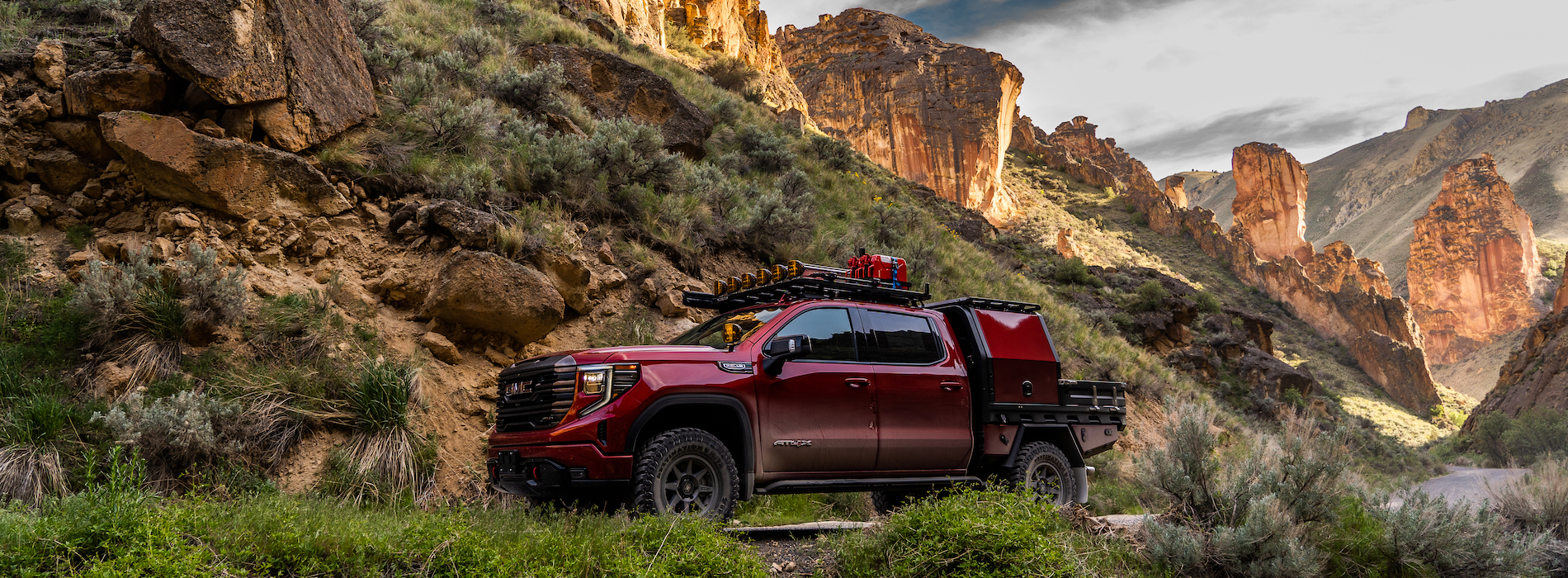
Comparing the Top Overlanding Vehicles
Overlanding tacoma.
The overlanding Tacoma has become a popular choice for adventurers thanks to its reliability, off-road capabilities, and customizability. With a strong aftermarket following, there are countless options for upgrading your Tacoma with off-road suspension, bumpers, and storage solutions. The Tacoma is also known for its durability and excellent resale value.
Overlanding Jeep
The iconic overlanding Jeep Wrangler is another favorite in the overlanding community. With exceptional off-road performance and a well-established aftermarket, the Jeep Wrangler offers a variety of modifications to suit any adventure. Additionally, its removable doors and roof make it a versatile option for warm-weather excursions.
Best Overlanding Vehicles Overall
While the Tacoma and Jeep are popular choices, other vehicles are also well-suited for overlanding adventures. Some of the best overlanding vehicles include:
- Toyota 4Runner: Boasting similar off-road capabilities to the Tacoma, the 4Runner offers additional interior space for comfortable living.
- Land Rover Defender: Known for its ruggedness and off-road prowess, the Defender has a loyal following among overlanders.
- Ford Bronco: The new Ford Bronco combines classic styling with modern off-road technology, making it a compelling option for overlanding enthusiasts.
Considerations When Selecting a Vehicle
When choosing an overlanding vehicle, consider the following factors:
- Off-road capabilities: Ensure the vehicle can handle the terrain you plan to traverse, whether it's rocky trails, sand dunes, or muddy forests.
- Reliability: A dependable vehicle is essential for minimizing breakdowns and maintenance issues while on the road.
- Space and comfort: Evaluate the interior space and layout to make sure it meets your needs for sleeping, cooking, and storing gear.
- Customizability: Look for a vehicle with a strong aftermarket presence, allowing you to modify it to your specific needs.
- Fuel efficiency and range: Longer trips may require a vehicle with better fuel efficiency and a larger fuel capacity.
- Cost: Factor in the purchase price, maintenance costs, and potential resale value when selecting a vehicle.
Don't forget to equip your overlanding vehicle with a reliable vehicle signal booster , like the weBoost Drive Reach or weBoost Drive Reach Overland , to stay connected during your adventures.
Customizing Your Overlanding Vehicle
Essential modifications for a successful overland journey, tires and suspension systems.
Upgrading your tires and suspension system is crucial for a successful overlanding adventure. High-quality all-terrain or mud-terrain tires provide better traction and durability on various terrains. A reliable suspension system not only improves off-road performance but also ensures a smoother ride for passengers. Popular upgrades include:
- Lift kits: Elevate your vehicle's height for increased ground clearance and improved off-road capabilities.
- Heavy-duty shocks: Improve ride comfort and handling on uneven terrain.
- Airbag suspension: Enhance load-carrying capacity and adjust ride height on-the-fly for varying conditions.
Lighting and Electrical Updates
Proper lighting and electrical updates can greatly improve your overlanding experience. Key modifications include:
- LED headlights and fog lights: Enhance visibility during night driving or inclement weather.
- Auxiliary lighting: Add light bars, spotlights, or floodlights for improved off-road illumination.
- Solar panels and dual battery systems: Extend your off-grid capabilities by generating and storing power for your overlanding gear and accessories.
Don't forget to install a vehicle signal booster to stay connected during your journey. Options like weBoost Drive Reach or weBoost Drive Reach Overland can provide a reliable cell signal in remote areas.
Roof Racks and Storage Solutions
Maximizing storage space in your overlanding vehicle is essential. Roof racks and storage solutions allow you to bring all your gear and essentials without cluttering your living space. Key components include:
- Roof racks: Mount a roof rack for added storage and easy access to your overlanding tent or other large items.
- Bed racks: For overlanding Tacoma or other pickup trucks, bed racks can provide additional storage and mounting options.
- Drawer systems: Keep your equipment organized and easily accessible with a custom drawer system in the rear of your vehicle.
Personalization and unique features
Custom paint jobs and decals.
Make your overlanding vehicle truly your own with custom paint jobs and decals. Choose a color scheme that reflects your personality or the spirit of your adventure. Decals can include your favorite brand logos, travel quotes, or even a custom design representing your overlanding journey.
Interior Upgrades for Comfort and Functionality
Customizing the interior of your overlanding vehicle can greatly improve both comfort and functionality. Consider the following upgrades:
- Insulation: Adding insulation to your vehicle can help regulate temperature and reduce noise.
- Swivel seats: For overlanding Jeep and other vehicles, swivel seats can maximize interior space and create a more comfortable living area.
- Custom cabinetry and storage: Design and build custom cabinets to house your kitchen equipment, clothes, and other essentials.
- Ventilation and climate control: Install roof vents, fans, or even an air conditioning unit to maintain a comfortable living environment.
By following these tips, you can transform your vehicle into the perfect home away from home, ready for any overlanding adventure. And don't forget to join communities like the Overlander Community by Expedition Overland or the Overland Bound Community
Planning an Overlanding Trip
Researching trail information and conditions.
Before embarking on your overlanding adventure, it's essential to research trail information and conditions. This can help you choose the best route and avoid potential hazards. Here are some tips to get you started:
- Consult guidebooks, online forums, and websites: Resources like the Overland Bound Community and the Overlanding Subreddit can provide valuable information from experienced overlanders.
- Reach out to local authorities: Contact park rangers, forest service offices, or other local authorities for up-to-date information on trail conditions and potential closures.
- Monitor weather reports: Check local weather forecasts and historical weather data to plan for possible inclement weather during your journey.
Mapping Out a Route and Determining Fuel Needs
Once you have a better understanding of trail conditions, it's time to map out your route and determine your fuel needs. Consider the following steps:
- Plan your route: Use mapping tools, GPS devices, or apps to outline a detailed route for your overlanding trip. Include waypoints, campsites, and points of interest along the way.
- Calculate fuel consumption: Based on your overlanding vehicle's fuel efficiency and the total distance of your trip, estimate how much fuel you'll need. Factor in additional fuel for off-roading, idling, or detours.
- Identify fuel stops: Mark fuel stations along your route and determine how much fuel you can carry. For remote areas, consider carrying extra fuel in jerry cans or using a long-range fuel tank.
Acquiring Necessary Permits/Licenses for International Travel
When overlanding across international borders, it's essential to acquire the necessary permits and licenses. Here are some considerations:
- Vehicle permits: Many countries require a temporary import permit (TIP) for your overlanding vehicle . Research the requirements and apply for permits well in advance.
- International driving permit: An International Driving Permit (IDP) may be required to drive legally in some countries. Apply for an IDP through your local automobile association.
- Visas and passports: Ensure your passport is up-to-date and research visa requirements for each country you plan to visit. Apply for visas well in advance to avoid delays or complications.
When traveling internationally, also consider installing a vehicle signal booster to stay connected. The weBoost Drive Reach and the weBoost Drive Reach Overland can help maintain a reliable cell signal, even in remote areas.
By thoroughly researching trail conditions, planning your route, and acquiring the necessary permits, you'll be well-prepared for a successful overlanding adventure. Remember, the more prepared you are, the more enjoyable your journey will be!
Necessary Preparations Before Embarking on an Overland Adventure
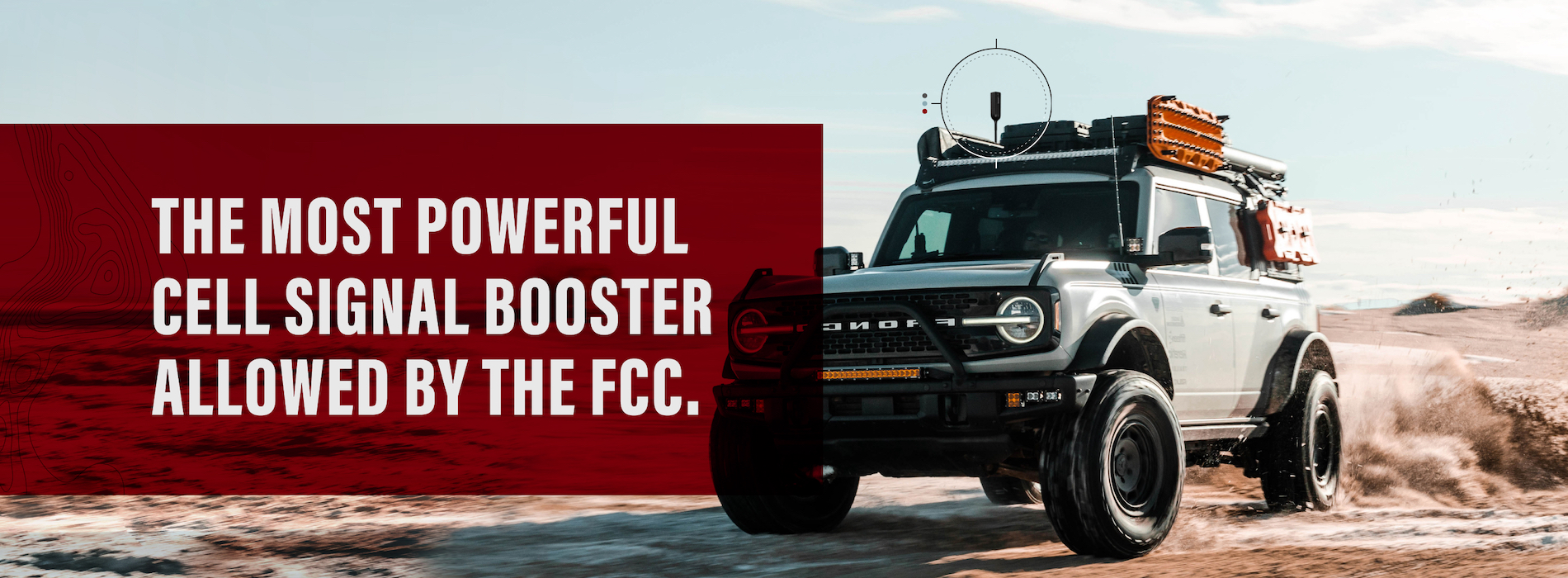
Vehicle Maintenance and Inspection
Before setting off on your overlanding adventure, it's crucial to perform a thorough vehicle maintenance and inspection. Proper maintenance ensures that your overlanding vehicle is in good working order and helps prevent breakdowns during your trip. Follow these steps:
- Inspect and maintain essential components: Check the engine, transmission, brakes, suspension, tires, and cooling system. Replace worn parts and fluids as needed.
- Test your vehicle signal booster : Make sure your cell signal booster, such as the weBoost Drive Reach or weBoost Drive Reach Overland , is functioning correctly to ensure reliable communication during your journey.
- Pack essential tools and spare parts: Carry basic tools, spare tires, and replacement parts to address minor repairs on the road.
Double-Checking Gear Lists
It's vital to double-check your overlanding gear list to make sure you have everything you need for your trip. Keep the following in mind:
- Compile a comprehensive gear list: Include essential items like camping equipment, cooking supplies, navigation tools, and your overlanding tent .
- Verify the functionality of key items: Test equipment such as your overlanding trailer , GPS devices, and recovery gear to ensure they're in good working order.
- Pack strategically: Organize your gear to maximize space and accessibility in your overlanding vehicle or overlanding jeep .
Familiarizing Oneself with Survival Skills (First Aid, Navigation, Vehicle Repair)
Before embarking on an overland adventure, it's crucial to familiarize yourself with essential survival skills. These skills can help you overcome challenges and stay safe during your trip. Consider the following:
- First aid: Learn basic first aid techniques and carry a well-stocked first aid kit. Know how to treat common injuries like cuts, burns, and sprains, as well as more severe emergencies.
- Navigation: Master the use of maps, compasses, and GPS devices to navigate unfamiliar terrain confidently. Familiarize yourself with landmarks and terrain features along your route.
- Vehicle repair: Acquire basic mechanical knowledge to perform simple repairs on your overlanding vehicle or overlanding tacoma . Learn how to change a tire, replace a fan belt, or troubleshoot common engine issues.
By taking the time to prepare your vehicle, double-check your gear, and brush up on essential survival skills, you'll set yourself up for a successful and enjoyable overlanding adventure. Remember, thorough preparation is the key to a safe and memorable journey!
How to Get Started Overlanding
Finding a local overlanding community.
If you're new to overlanding , finding a local community can provide valuable support, advice, and friendship. To locate a group near you:
- Use social media: Search Facebook or Instagram for overlanding groups in your area. One popular group is the Overlander Community by Expedition Overland .
- Attend local events: Look for overlanding meetups, workshops, or gatherings in your region. These events are excellent opportunities to meet like-minded people and learn from experienced overlanders.
- Visit outdoor stores: Check your local outdoor or off-road vehicle stores for information about overlanding clubs or events. Store staff are often knowledgeable and can direct you to nearby groups.
Joining Overlanding Clubs and Online Forums
Joining overlanding clubs and participating in online forums can be an invaluable resource for learning more about overlanding and connecting with others who share your passion. Here's how to get involved:
- Sign up for clubs: Research and join local or national overlanding clubs that align with your interests. The Overland Bound Community is a popular choice for many overlanders.
- Participate in online forums: Engage in discussions, ask questions, and share your experiences on overlanding forums like the Overlanding Subreddit . These platforms are great places to learn from others and receive feedback on your ideas.
- Stay active: Regularly contribute to discussions and attend club events to build connections and gain valuable knowledge about overlanding gear , vehicles, and best practices.
Participating in Overlanding Events and Workshops
Attending overlanding events and workshops can help you build essential skills, learn about new gear, and network with fellow overlanders. To get started:
- Research events: Look for overlanding expos, workshops, or trail rides in your area or region. These events often feature demonstrations, classes, and opportunities to test out the latest overlanding gear and vehicles.
- Attend workshops: Participate in workshops that focus on specific aspects of overlanding, such as vehicle maintenance, navigation, or trip planning. These sessions can help you build your skills and confidence as an overlander.
- Support conservation efforts: Get involved with organizations like Expedition Conservation that promote responsible overlanding practices and work to protect the environment.
By finding a local community, joining clubs and forums, and participating in events and workshops, you'll be well on your way to becoming a successful overlander. Remember, the overlanding community is full of passionate, knowledgeable individuals who are eager to share their experiences and help newcomers. Don't be afraid to ask questions, seek advice, and immerse yourself in this exciting world of adventure!
Top Destinations for Overlanding Adventures
Iconic international routes.
Embarking on an overlanding adventure often means exploring breathtaking landscapes and experiencing diverse cultures. Here are three iconic international routes that should be on every overlander's bucket list:
Trans-Africa Route
The Trans-Africa route stretches from Cairo, Egypt, to Cape Town, South Africa. This epic journey takes you through deserts, savannahs, and jungles, showcasing the stunning diversity of Africa's landscapes. Along the way, you'll encounter unique wildlife and vibrant cultures. Make sure to pack your overlanding gear and prepare your overlanding vehicles for the rugged terrain you'll encounter.
The ancient Silk Route extends from Istanbul, Turkey, to Xi'an, China. This legendary trade route offers a wealth of historical and cultural experiences, from the grand bazaars of Istanbul to the Great Wall of China. A reliable overlanding jeep or overlanding Tacoma would be perfect for navigating the varied terrain of this once-in-a-lifetime adventure.
Istanbul to Cairo Route
Another historically significant route is the Istanbul to Cairo route, connecting Europe and Africa. This journey offers a blend of natural beauty and rich history, taking you through ancient cities like Jerusalem, Petra, and Luxor. Be sure to equip your overlanding tent and gear for both desert and mountainous conditions.
Popular Domestic Locations
For those who prefer to stay closer to home, there are plenty of incredible overlanding destinations right here in the United States. Here are some popular domestic locations:
West Coast Trails
The West Coast is a haven for overlanders, offering a range of scenic trails that cover diverse landscapes like deserts, forests, and coastal vistas. Some highlights include the Pacific Northwest's Olympic National Park, California's Mojave Desert, and Arizona's Grand Canyon. Equip your best overlanding vehicles and hit the trails!
East Coast Excursions
The East Coast also offers plenty of opportunities for overlanding enthusiasts. From the Appalachian Mountains to the coastal landscapes of Maine and Florida, there's no shortage of exploration possibilities. Key destinations include the Blue Ridge Parkway in Virginia, North Carolina's Outer Banks, and the Green Mountains of Vermont.
Midwest Off-Road Spots
The Midwest may be known for its vast plains, but it also boasts numerous off-road spots for overlanders. Explore the sand dunes of Michigan's Silver Lake State Park, or take on the challenging trails of the Ozark National Forest in Arkansas. Don't forget your overlanding trailer to make your Midwest adventure as comfortable as possible.
Whether you're drawn to the allure of international travel or prefer the familiarity of domestic destinations, there are countless overlanding adventures waiting to be discovered. As you plan your next trip, remember to research the local regulations, culture, and environment to ensure a safe and enjoyable journey. And with the right overlanding gear and a strong sense of adventure, the world is truly your playground.
Overcoming Challenges and Embracing the Overlanding Lifestyle
Building a support network of fellow overlanders.
Embarking on an overlanding adventure can be a daunting experience, especially for newcomers. Building a support network of fellow overlanders is essential for learning tips, tricks, and sharing experiences. Here's how to connect with like-minded adventurers:
Join online communities: Many overlanding enthusiasts gather in forums and social media groups like the Overlander Community by Expedition Overland , Overland Bound Community , and the Overlanding Subreddit . These platforms offer a wealth of knowledge and advice for beginners and seasoned overlanders alike.
Attend events and gatherings: Local and regional overlanding events are great opportunities to meet fellow enthusiasts, share stories, and learn from one another. These gatherings often include workshops, trail rides, and other activities that promote camaraderie and skill-building.
Seek out mentors: If you know experienced overlanders, ask them for advice and guidance. They can provide valuable insights into selecting the best overlanding vehicles , choosing the right overlanding gear , and navigating challenging routes.
Learning from Mistakes and Growing as an Adventurer
Mistakes are inevitable when you venture into the world of overlanding . Embrace these learning opportunities and grow as an adventurer by:
Reflecting on experiences: After each trip, take the time to evaluate what went well and what didn't. Did your overlanding tent hold up in harsh weather? Was your overlanding jeep or overlanding Tacoma well-equipped for the terrain? Use this information to make improvements for future adventures.
Seeking feedback: Reach out to your support network for feedback and advice. Fellow overlanders can offer valuable perspectives on your experiences, and help you identify areas for improvement.
Continuous learning: Stay up-to-date on the latest overlanding trends, gear, and techniques by reading blogs, watching videos, and participating in online forums. The more you know, the better prepared you'll be for your next adventure.
Committing to Sustainable Practices and Conservation Efforts
Responsible overlanding involves minimizing your impact on the environment and supporting conservation efforts. Here are some tips to help you embrace sustainability in your adventures:
Follow Leave No Trace principles: Proper disposal of waste, respecting wildlife, and minimizing campfire impacts are just a few examples of the Leave No Trace principles. Adhering to these guidelines helps protect the environment and preserve natural spaces for future generations.
Invest in eco-friendly gear: Choose overlanding gear that is sustainable, durable, and eco-friendly. Solar panels, biodegradable soaps, and reusable water containers are just a few examples of products that can help reduce your environmental footprint.
Support conservation organizations: Many groups, like Expedition Conservation , work to protect and preserve natural areas. Consider donating, volunteering, or participating in their events to support their efforts.
By building a strong support network, learning from your experiences, and committing to sustainable practices, you can fully embrace the overlanding lifestyle and make the most of your adventures. Happy trails!
In conclusion, overlanding is an adventurous and exciting way to explore the great outdoors, while also pushing your personal boundaries and creating unforgettable experiences. As you embark on your journey to becoming an overlander, it's crucial to understand what is overlanding and how to properly equip yourself with the right overlanding gear .
Investing in a reliable overlanding vehicle is the first step towards a successful expedition. Whether you choose an overlanding jeep , overlanding Tacoma , or one of the many other best overlanding vehicles available, having a dependable mode of transport will ensure a safer and more enjoyable trip. Don't forget to outfit your vehicle with essential accessories, such as a sturdy overlanding tent and a well-built overlanding trailer to carry your gear.
Another critical aspect of overlanding is staying connected while off the beaten path. Consider installing a vehicle signal booster to improve cell reception during your travels. Options like 4G LTE signal boosters , 5G signal boosters , and AT&T signal boosters can help you maintain a strong connection, regardless of your preferred carrier. For a comprehensive guide, check out UberSignal 's best cell phone signal boosters to find the perfect fit for your adventure.
Finally, remember that the overlanding community is an invaluable resource. Connecting with fellow adventurers through forums like the Overland Bound Community and the Overlanding Subreddit can provide you with essential knowledge, support, and camaraderie throughout your journey. As you grow in your overlanding experience, always strive to learn from your mistakes, embrace sustainable practices, and support conservation efforts to protect the beautiful landscapes we all love to explore.
Now that you're equipped with the knowledge and resources needed to embark on your overlanding adventure, it's time to hit the road and start making memories. Safe travels, and happy overlanding!
Overlanding FAQ
What is overlanding.
Overlanding is a form of self-reliant, adventure travel, where the journey is more important than the destination. It typically involves traveling through remote areas and exploring off the beaten path, with an emphasis on self-sufficiency and living out of your vehicle.
How to start overlanding?
To start overlanding, begin by researching the activity, connecting with fellow overlanders, and acquiring essential gear. Invest in a reliable and capable vehicle, outfit it with necessary equipment, and plan your routes based on your skill level and desired destinations. Don't forget to practice Leave No Trace principles and always prioritize safety.
How to find overlanding trails?
To find overlanding trails, consult online resources like trail databases, overlanding forums, and local off-roading clubs. Smartphone apps and GPS devices dedicated to off-road navigation are also helpful for finding suitable routes. Always verify trail conditions and accessibility before embarking on a journey.
What is the best vehicle for overlanding?
The best vehicle for overlanding depends on personal preferences and the type of terrain you plan to explore. Popular choices include 4x4 trucks, SUVs, and off-road-capable vans. Key features to look for include reliability, off-road performance, payload capacity, and adaptability for modifications.
What does RTT stand for in overlanding?
In overlanding, RTT stands for Roof Top Tent. A roof top tent is a type of shelter that mounts directly on the roof rack of a vehicle, providing a comfortable and elevated sleeping area. RTTs are popular among overlanders due to their convenience, quick setup, and added protection from ground-dwelling critters.
What kind of tent for overlanding?
When choosing a tent for overlanding, consider factors such as size, weight, durability, and ease of setup. Roof top tents (RTTs) are popular for their convenience and elevated sleeping platform. Ground tents can also be a suitable option, especially if they are designed for rugged conditions and quick setup. The best choice depends on personal preferences and vehicle capabilities.
Related Posts
The Complete Guide to 5G and Signal Boosters
5 Myths About Cell Phone Signal Boosters Busted
Get the Most Out of Your weBoost Signal Booster: Tips and Tricks You Need to Know
Related products.

weBoost Drive Reach Overland Signal Booster Kit | 472061
- Best for boosting signal in your truck or overland vehicle.
- Outside antenna mount has multiple mounting options, including the ability to fold down the antenna.
- Most powerful multi-carrier mobile amplifier available.
Looking for a Signal Booster?
Answer a few questions to find the perfect booster for your situation.

Start your engines: our ultimate guide to overland travel
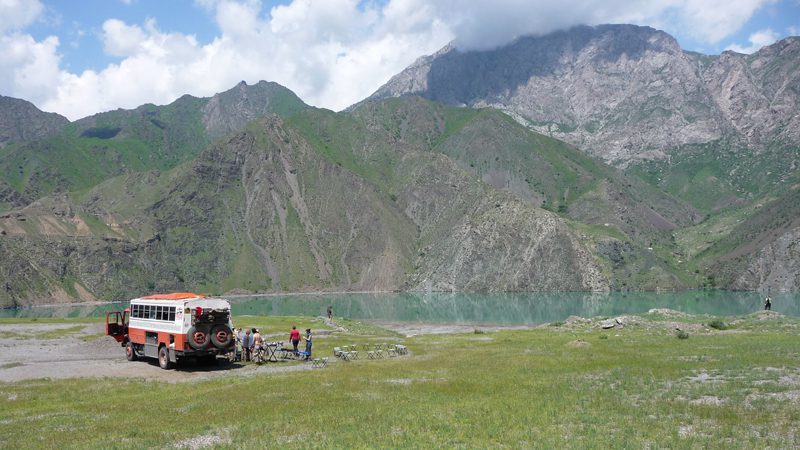
The beaming and curious smiles of the locals watch on as we load our bags into the back locker of our overland truck. The dirt road snakes its way onwards through gentle hills, punctuated by traditional thatched straw homes. Smoke from early morning cooking dots the horizon and mixes with the cool mist in the early morning sun. Another epic day on the road awaits.
Overland travel provides a different approach to the tired practice of flying between ‘must see’ destinations. With the use of a sturdy, purpose-built overland truck, complete with everything you need (including the kitchen sink!) ‘Overlanding’ gives you access to remote and little visited areas of a country that other travellers simply don’t see. Being perhaps one of the purest forms of travel, overlanding really gets you under the skin of a country and its culture. The following tips are aimed to turn your overland experience into the journey of a lifetime. The awe inspiring landscapes and interactions with local peoples who rarely experience tourism give real meaning to the quote ‘It’s the journey, not just the destination’.
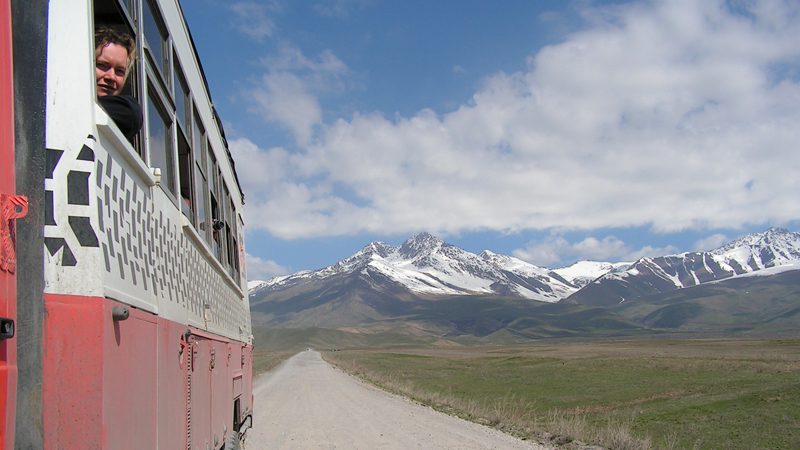
Here are my tips for surviving on the road.
1. Learn a few words
You’ll be surprised just how much a jubilant ‘Jambo!’, ‘Xie Xie!’ or ‘Tudu Bem!’ can open up even the most reserved of locals. Often met with giggles and shy smiles, learning just a few words can be a great ice-breaker and can lead to to the most amazing opportunities. On my recent overland trip to Myanmar, a smile and ‘Mingalba!’ greeting saw me invited into someone’s home to share tea and to coo over their gorgeous newborn son. What an experience!
2. Patience
Drives can be long and roads can be bumpy but the rewards reaped far out way the minor discomforts. Whether it’s a sealed road stretching off into the distance, back-dropped by the snow- capped Patagonian Andes, or a muddy track through the bewitching tribal lands of Ethiopia, you’ll always find yourself gazing out the window with a smile. Travelling in this way can sometimes throw up frustrating roadblocks but often it might be the very situation you’re dealing with that proves to be the highlight of your trip, or a story told around a camp-fire or a pub table for years to come.
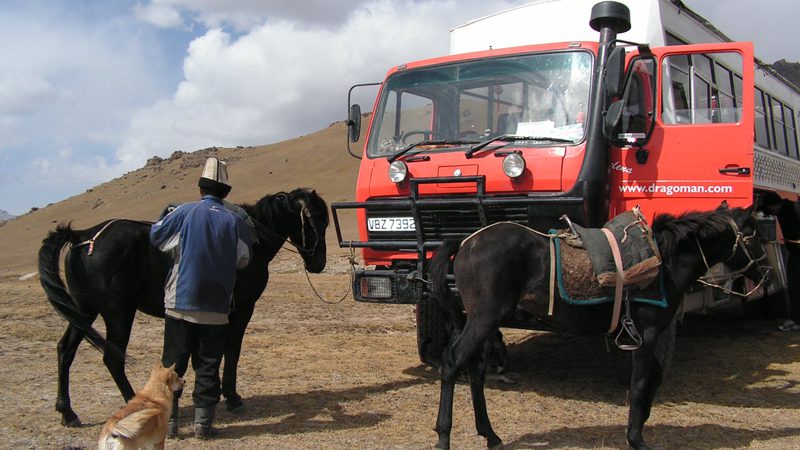
3. Bring a good book
A good book is a must but an audio book gives you the opportunity to see the world pass by without having your head stuck in its pages. Imagine listening to the tales of Marco Polo through the Silk Route, then retracing his footsteps at your destination; or being captivated by the novel ‘Shantaram’, whilst negotiating the bustling pandemonium of Mumbai’s busy streets.
4. Wet-wipes
Let’s face it, at times overlanding can be demanding, dusty and sometimes just downright dirty! A trusty pack or two of wet-wipes can be a godsend at a hot border crossing or a bushcamp under the stars. Sometimes a shower is just not available, so you might find that after hiking through the primordial wilds of the Amazon Basin, or when crossing Lake Aswan into Sudan in the blistering heat, a quick wet-wipe goes down a treat. Fellow travellers in close proximity will thank you too!
5. Upgrades
Whilst some of the most unique and magical experiences lie way off the beaten track, a lot of campsites offer upgrades when at times, a tent just won’t cut it. Sometimes after an action packed day of meandering through the Okavango Delta or searching for gorillas in the Rwandan jungle, the allure of a comfy bed is just too much! Along with camping, all trips have comfortable hotel stops; the frequency just depends on the style and location of the trip itself. The boutique Bissau Palace Hotel in the pink city of Jaipur, the minaret clad skyline of Samarkand, gazing out as feluccas negotiate the gentle current of the river Nile and the Peruvian mountain views from the La Casa De Mi Abuela are all standout hotel delights.
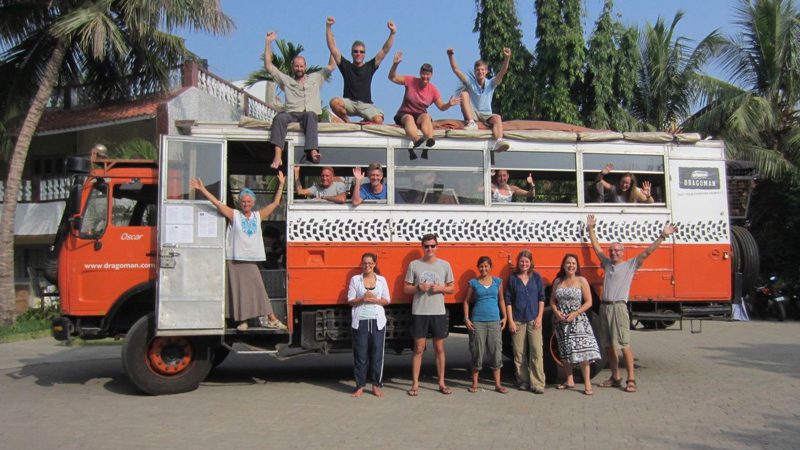
6. Pitch in
One of the great things about an overland journey is the camaraderie between passengers and crew alike. Minor chores, help with cooking and even grabbing a shovel to help free a truck stuck-fast in the sand are integral parts of any overland experience. Like with most things the more you put in, the more you get out. Lending a hand and getting involved will enrich your journey no end.
7. Bring a couple of extra memory cards
It might seem obvious but it’s easy to underestimate just how many fantastic photos you can take. It’s not just that postcard perfect shot of you perched in front of the Taj Mahal illuminated by a coral sunrise or a close up of a yawning lion baring its enormous teeth that are important. Whether it be an impromptu dress-up truck party, or a round of beers with your rhino-tracking bush guide, there are always plenty of possibilities to capture a memory. With everlasting views and countless opportunities to view locals without another tourist in sight you might just find that bringing a third or even a fourth SD card was a good idea.
8. A good sense of adventure
Getting out of your comfort zone is what overland travel is all about and an intrepid sense of adventure is a key ingredient of any journey. River crossings, close-up encounters with wildlife and remote wilderness camping are all possibilities that make up part of the truly epic adventure that an overland journey provides. For those of you with a penchant for the extreme, white knuckle experiences abound. Mountain biking down Bolivia’s ‘Death Road’, skydiving over the Namibian desert, bungee jumping over the White Nile in Uganda and gut-wrenching bridge swings in the Nepalese Himalayas await.
Incorporating all the iconic locations and all the joys of the in between, wild-camps, mucking in and even ‘bush pees’ are all part of it! However it doesn’t mean you won’t find yourself tango-ing the night away in the Buenos Aires moonlight, bar hopping through Beijing’s sizzling night-life or treating yourself to a meal at the regal and magnificent Royal Livingstone Hotel. So for those with a venturesome ethos and taste for something a little different, the road is calling.
Ready to hit the open road? Check out Intrepid’s overland trips.
Feeling inspired?
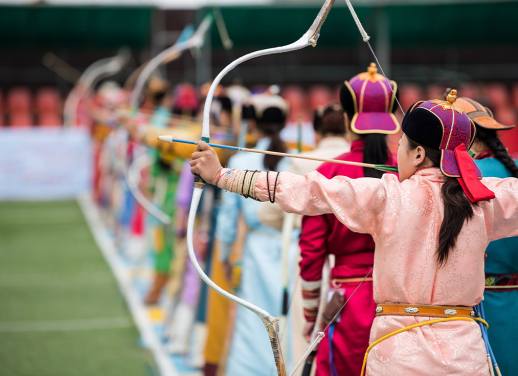
Originally hailing from the Pommy countryside, I first realised my love for the road after hitch-hiking round Canada on a diet of rum and baked beans. With money gained from cleaning the soiled hotel rooms, I set off for New Zealand, bought a van and spent a good year or so lost in 'Lord of the Rings' landscapes. From there I went on to work in the Finnish Arctic, trekking throughout Asia and leading snowmobile trips in Japan's backcountry. This led me to a job as an overland driver, running trips all over Central and South America, Africa and the Middle East, Central Asia and the Indian Subcontinent. Along with writing, I still work as a guide part time and although I've gone off baked beans the rum remains a constant.
You might also like
The 7 best places to go on a..., 5 reasons to visit sri lanka in the..., why 2024 is the best year to see..., yellowstone vs yosemite: which national park to visit, 6 unique experiences you can have in el..., from delhi to udaipur, here are the five..., cinque terre vs amalfi coast: which destination to..., love at first bite: 10 famous sandwiches from..., galapagos or madagascar which unique destination should be..., central vs south america: how to plan your..., 4 reasons you should take a road trip....
Life is an Adventure, Best Enjoyed Outdoors

Tales from the Untamed Trails
Discover the Thrill of Overlanding:
Embark on an overlanding adventure: discover captivating stories, expert tips, and breathtaking experiences from intrepid travelers who have conquered the roads less traveled.
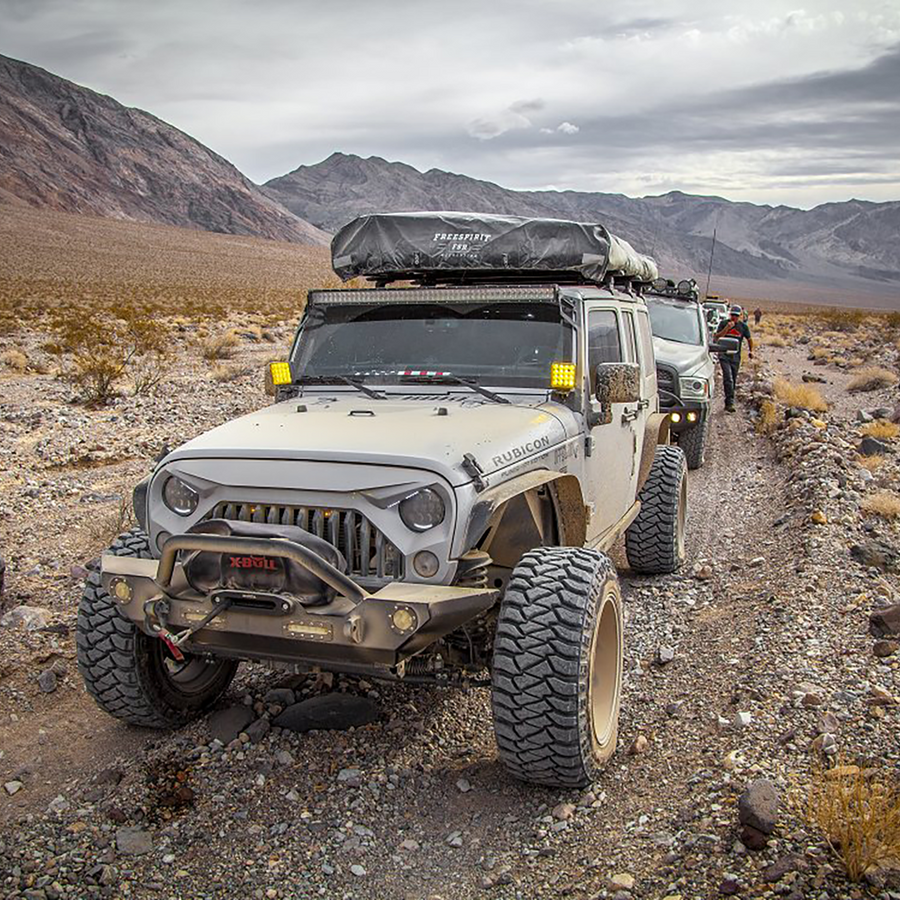
A Beginner's Guide to Overlanding: Tips, Gear and Ways to Explore
Are you new to overlanding and eager to embark on exciting off-road adventures? This beginner's guide is your gateway to the world of overlanding. Overlanding is a thrilling way to explore remote and less-traveled destinations, far from the beaten path.
In this guide, you'll find essential tips for planning your overlanding trip, including route selection, camping gear recommendations, and insights into preparing your vehicle for rugged terrains.

The Benefits of Overlanding: Why it's a Great Way to Explore the Great Outdoors
Overlanding offers a host of incredible benefits that make it a unique and fulfilling way to explore the great outdoors. Unlike traditional forms of travel, overlanding allows you to escape the hustle and bustle of cities, connecting you with nature in its rawest form.
Imagine waking up to breathtaking sunrises amidst scenic landscapes or falling asleep under a canopy of stars in remote wilderness areas.
The Ultimate Overland Checklist: Your Adventure Awaits!
Embarking on an overland adventure is a thrilling endeavor that takes you off the beaten path and into the heart of nature. Whether you're planning a short escape or dreaming of a full-time on-the-road lifestyle, our comprehensive overland checklist is here to guide you.
Designed for those who want to create lasting memories while staying prepared, this checklist will help you pack efficiently and make the most of your journey.
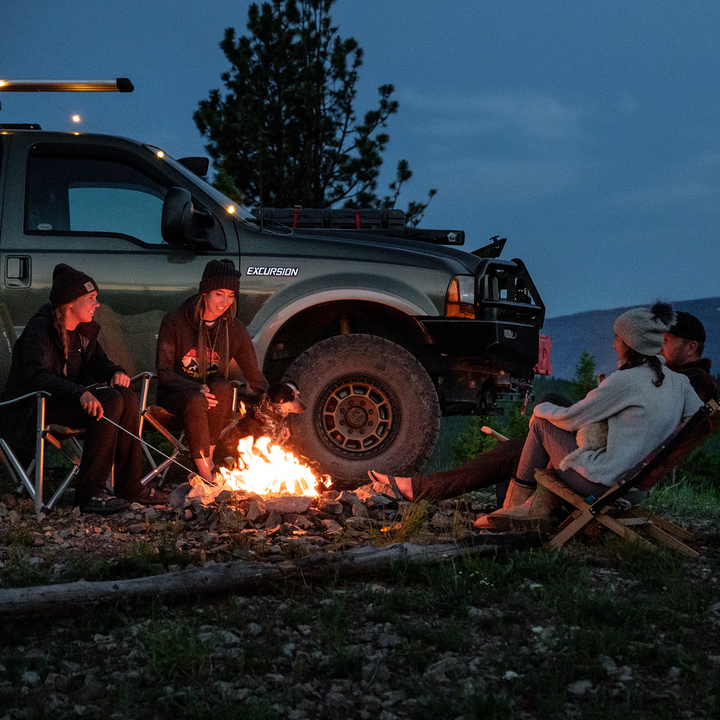
Overlanding vs. Camping: What's the Differences, and Which is Better?
Overlanding and camping are both immersive outdoor experiences, but they have distinct characteristics that set them apart. Camping typically involves setting up a base at a designated campground and exploring the surrounding areas on day hikes or short excursions.
On the other hand, overlanding revolves around the journey itself, where the travel becomes an integral part of the adventure.
The Best Vehicles for Overlanding: SUVs, Trucks or Jeeps?
Are you an adrenaline junkie looking for the perfect vehicle for your overlanding adventures? We’ve got the perfect guide for you! Check out our blog to explore the world of SUVs, trucks, and Jeeps and find the best option for your next off-road excursion.
When it comes to choosing the right vehicle for overlanding, there are several factors to consider. Ground clearance, four-wheel-drive system, ample storage space, and a reliable suspension system are all key. Read our blog to find out more!

Top 10 Off-Road Upgrades for Your Vehicle
As truck lovers, we love to modify our rigs.
Sure, manufacturers do a relatively good job of producing vehicles that can go off-road. However, there are certainly many improvements to be made. When a vehicle is designed, factory engineers try to strike the balance between off-road abilities and on-road performance.
In this post we discuss what we consider the Top 10 most important upgrades when building your off-roader.
Overlanding Safety Tips: Exploring the Great Outdoors with Confidence
While overlanding can be an exhilarating experience, it also comes with potential risks, especially when venturing into remote and uncharted areas. Prioritizing safety is essential for a successful overlanding trip.
Before embarking on your adventure, thoroughly research the destinations you plan to visit, assess potential hazards, and plan alternative routes in case of unexpected challenges.
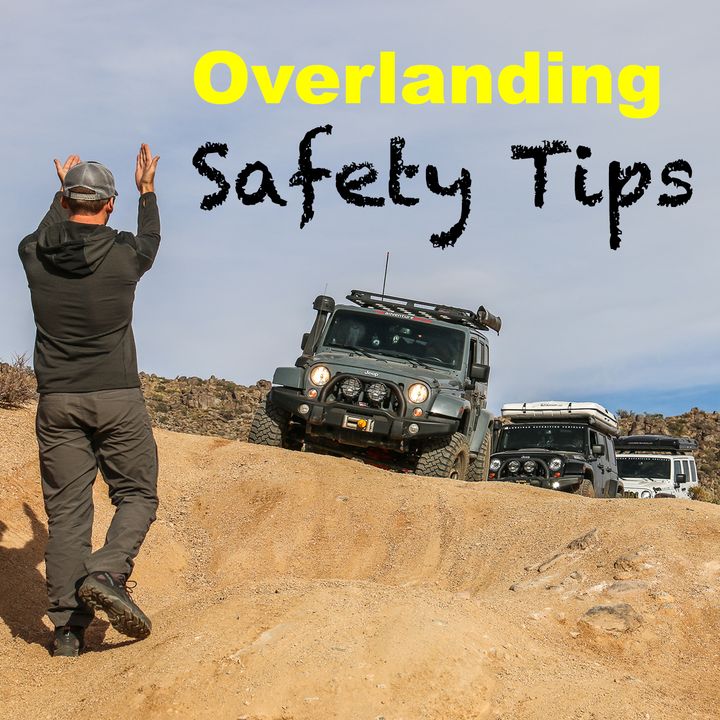
Overlanding: Solar Power Setups
As outdoor enthusiasts, we all want to enjoy the great outdoors without sacrificing our comfort. That's why solar power is the perfect solution for camping and overlanding adventures! Not only is it a convenient source of energy, but it's also eco-friendly and cost-effective.
Check out our blog to learn more about the benefits of solar power and how you can make the most of it during your next outdoor adventure.
What is the best GPS for Overlanding?
Navigation is a vital aspect of overlanding, as many adventures take you through remote regions with limited cell service and no internet access. Choosing the best GPS device will help you stay on track and navigate with confidence.
Handheld GPS devices are popular among overlanders for their ruggedness and long battery life, making them reliable companions on extended trips.

How to Set Up a Dual Battery System for Overlanding
If you're an overlanding enthusiast who uses electrical accessories like a winch, air compressor, portable fridge, camp lights, GPS, or USB outlets, you might be putting a strain on your vehicle's electrical system.
When embarking on off-road adventures, having a reliable power source is crucial. A dual battery system comes to the rescue, ensuring you have ample power for your accessories and keeping you well-equipped in remote locations.
Onboard Air Compressor Setups
Are you an avid overlander?
Upgrading to an onboard air system is a must for any serious off-roader! Not only does it provide you with the flexibility to adjust tire pressure on the go, but it also opens up a world of possibilities with other air-powered accessories.
Check out this post to learn more about the benefits of an onboard air compressor for overlanding!
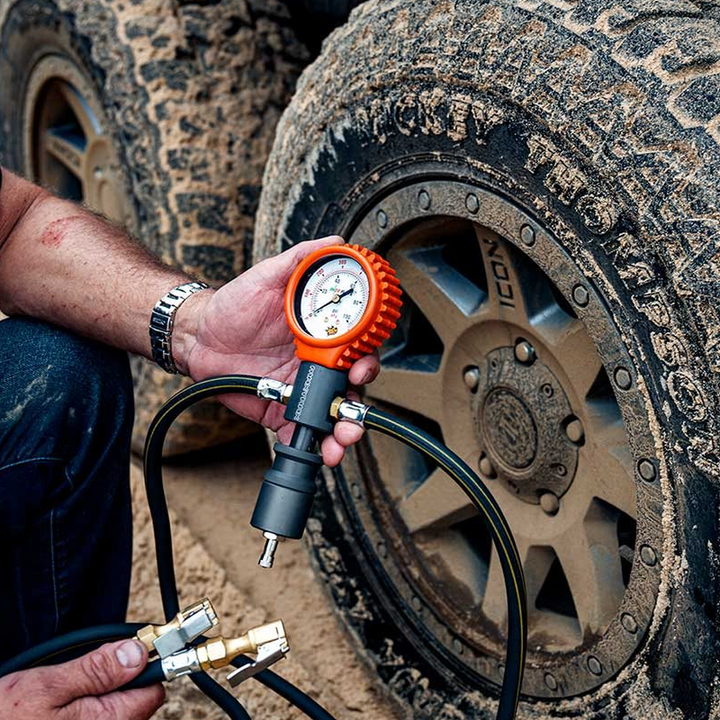
How to Air Down Tires for Overlanding
You've secured the maps, the refreshments, and the daring attitude, yet there's a vital element you must not disregard: your tires.
Deflating your tires before venturing onto the challenging paths can have a profound impact. Within this post, we will uncover the nuances of this crucial off-road method that has the potential to transform a rough ride into a seamless expedition.
The Essential Gear You Need for a Successful Overlanding Trip
Proper gear is essential for a successful and comfortable overlanding adventure. As you embark on your journey into the wilderness, pack essential camping gear such as a sturdy tent, sleeping bags, and camping cookware.
Adequate clothing for various weather conditions is a must, including waterproof and insulated layers, as well as hats and sunglasses for sun protection. Additionally, make sure to bring ample food supplies and drinking water, especially when traveling to remote areas with limited access to resources.

Overlanding with Kids: The Ultimate Family Adventure Guide
Overlanding with kids can be an unforgettable and enriching family experience, creating lasting memories and fostering strong bonds. Introducing children to the wonders of overlanding allows them to develop a deeper connection with nature and cultivate a spirit of adventure from a young age.
Safety is of utmost importance, so we'll also cover essential safety measures to follow when overlanding with children, including first aid preparedness and emergency planning.
Overlanding with Man's Best Friend
Are you ready to take your pup on the ultimate adventure? Overlanding with your dog is a great way to explore the great outdoors and make lasting memories. Check out our blog for tips on how to keep your pup safe and comfortable while overlanding!
Comfort and safety are vital when spending nights in the wilderness. The best way to ensure your pup is comfortable and protected during an overlanding experience is to have them sleep inside your vehicle or inside your tent with you.

Overlanders' Dilemma: Gear vs. Weight
Overlanding is an exhilarating adventure that captivates the spirit of exploration. The allure of traversing uncharted territories, finding solace under the open sky, and immersing oneself in the grandeur of nature is a magnetic draw for adventurers.
Amidst this remarkable journey lies an essential component: gear. Yet, as the excitement of packing for an expedition ensues, a crucial question emerges: when does the weight of your gear transform from an asset to a liability?
Camp Cooking Guide for Overlanding
Join us on a delectable adventure with the ultimate guide to camp cooking for overlanding enthusiasts. Explore a world of mouthwatering meals, essential survival strategies, and plenty of fun in this comprehensive culinary journey.
From mastering the art of cooking in the great outdoors to learning survival hacks, this guide has you covered. Ignite your camp stove, savor the flavors, and prepare for a gastronomic experience like no other!
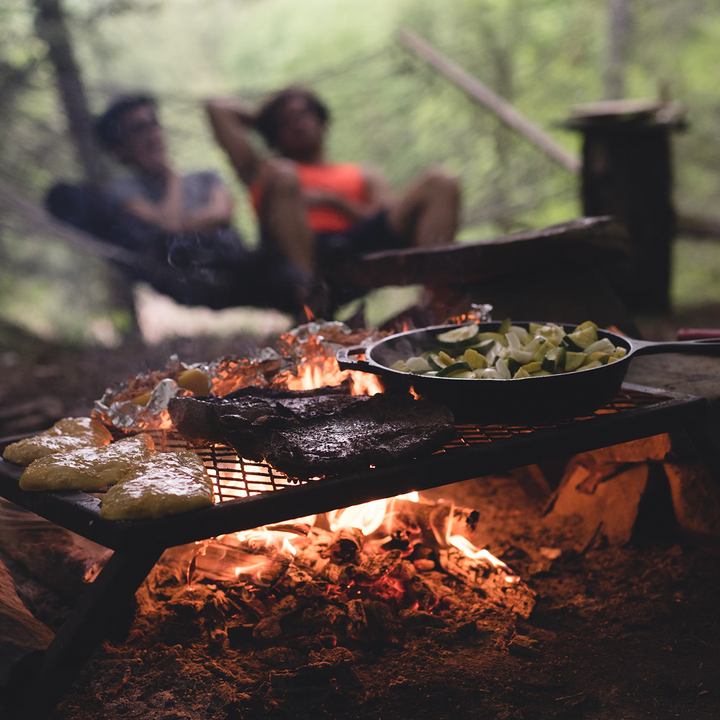
Hungry for More?
Ready to be part of something extraordinary? Sign up for our newsletter and enter a world of like-minded individuals who share your interests and curiosity!
Congratulations and welcome aboard! 🎉 You're officially part of our vibrant community of curious minds and content enthusiasts.
This customer is already subscribed
- Everything Else
- Unusual Off-Road
- Portable Power
- Latest Videos
- Body/Chassis
- Transmission/Drivetrain
- Wheels & Tires

- 4WD & Trucks
- Overlanding
- How To & Tech

Best Jeep Accessories of 2024
Are electric 4wd vehicles ready for serious overlanding, dodge ram off roading tips, how good is a rivian off road, how good is the 2022 toyota tacoma trd pro, what type of oev camper is right for you, are overland trucks more susceptible to corrosion, essential tips for a last-minute camping trip, essential tips for family camping with a rooftop tent trailer, how to upgrade a compact trailer for different outdoor activities, campluxe cabovers first impressions: luxury camping in your truck bed, allpowers s2000 portable station review, overland vehicle systems sidewinder roof top tent review, transforming space: the ultimate mercedes sprinter 170 extended van conversion, eezi-awn jazz roof top tent review, payload vs. towing capacity: what can your truck handle, breaking down the myths and misconceptions about all-terrain tires, how tire size and fitment can enhance off-roading performance, choosing the right overlanding tires, exploring the benefits of all-terrain truck tires, a beginner’s guide to overlanding.
Photo by ianmcdonnell via iStock
Are you ready to hit the open road? Do you want to pack up your vehicle and get away from it all for a few days, weeks, or even months?
Then overlanding is for you…
But how do you get into overlanding as a beginner?
In this beginner’s guide to overlanding, we’ll hit the highlights of some of the most critical things you need to consider before taking off on an overlanding adventure.
We’ll talk about overlanding vehicles, essential gear, and staying safe, so let’s get to it!
What is Overlanding?
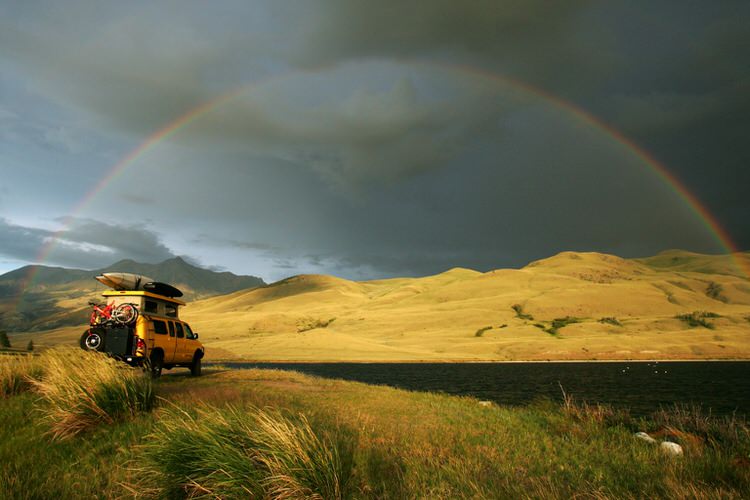
Photo by oksanaphoto via iStock
You can consult our overlanding vs off-roading comparison for a detailed review of how these pursuits are similar and different.
But for a short and quick answer, overlanding is like backpacking with your car. You cover long distances, carry everything you need with you, and make it about the journey and things you see and do along the way, rather than worry about the destination.
Many folks that overland do it simply to see the scenery as they drive. Others bring along their mountain bike, kayak, fishing poles, and other gear to enjoy outdoor pursuits as they travel.
What You Need in an Overlanding Vehicle?
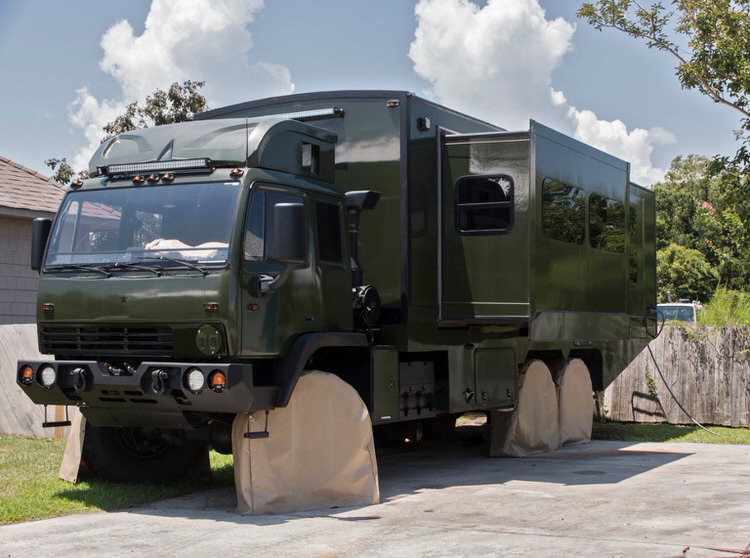
Photo by Balashark via iStock
You don’t need to go hog wild for an overlanding vehicle. You can actually overland in any vehicle – a truck or SUV, a station wagon or motorcycle. It’s really up to you and what you want your overlanding trip to look and feel like.
You can overland in a two-wheel-drive vehicle, AWD, or four-wheel-drive. Heck, you can make a Volkswagen Bug into an overlanding vehicle if you want!
If you plan to leave the tarmac, though, you should seriously consider having AWD or four-wheel-drive to enhance your vehicle’s capabilities off-road.
Jeeps, Land Rovers, and Land Cruisers are all well-loved in the overlanding community in large part because of their ability to handle off-road situations.
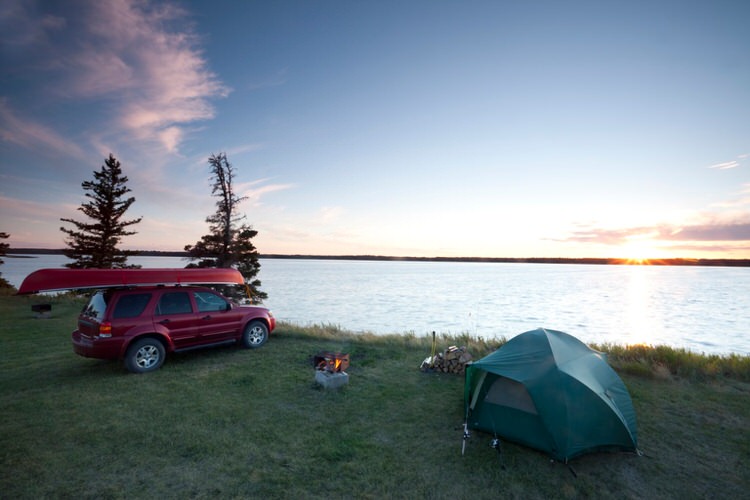
Photo by mysticenergy via iStock
No matter what vehicle you use, having one with a good suspension, good ground clearance, and off-road tires is certainly a benefit.
While you’re at it, a vehicle with good storage space is a bonus. After all, if your vehicle is your backpack, you’ll need room for all your gear.
This doesn’t necessarily mean you need a station wagon or SUV, either. You can get a roof rack or if you have a truck, get a bed cover or a bed rack (or both) to give you more space to store the necessities for your trip.
Pro Tip: Whatever vehicle you use for your overlanding trip, know its limitations. Not every vehicle can tackle the Rubicon Trail! If you don’t have a capable off-roader, stick to well-maintained roads in order to minimize the risk of getting stuck or damaging your vehicle.
Beginner’s Guide to Overlanding : Basic Gear for Your Vehicle
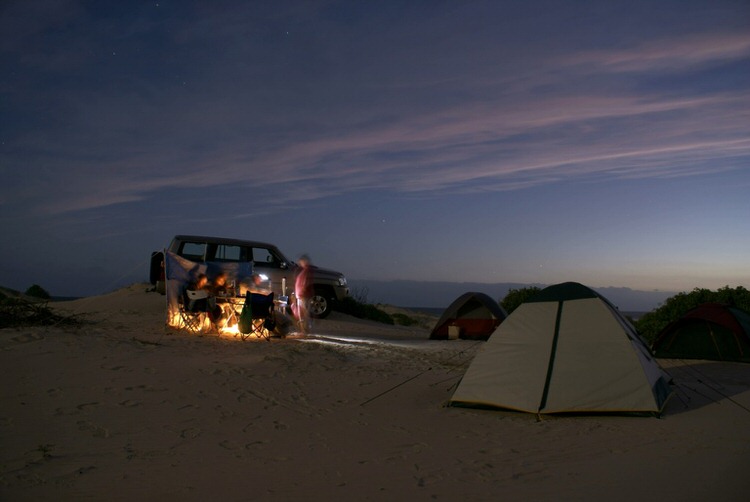
Photo by mato750 via iStock
There is certain gear you’ll want to think about getting before you set out. While this is not a comprehensive list, it should get you pointed in the right direction. Also remember that not all of these accessories are necessary for every overlanding situation. It’s just a general guide!
- High-Lift Jack – These jacks are bigger, better, and stronger than the one in your trunk. It will prove to be a valuable resource if you get a flat. It can also be used in recovery situations to help you get unstuck.
- Tire repair kit – You might be hours away from the nearest repair shop. Having tire repair items with you can save your bacon!
- Tool kit – Bring along things like a socket set, a multi-tool, zip ties, duct tape, and other tools that can help you fix up your vehicle on the road.
- Shovel – A good, solid shovel is a must-have for your overlanding rig.
- Tow Strap – A basic necessity for getting yourself (or someone else) out of a jam.
- Spare items – Things like extra fuses, belts, hoses, oil, and tires are necessary for long journeys.
Of course, there are some off-road mods you might consider making as well. Check this guide for some of our favorite vehicle modifications if you plan to get off the beaten path on your overlanding trip.

Learn More:
- Camping 101: A Beginner’s Guide to Gear
- Always Be Overlanding
Other Overlanding Gear
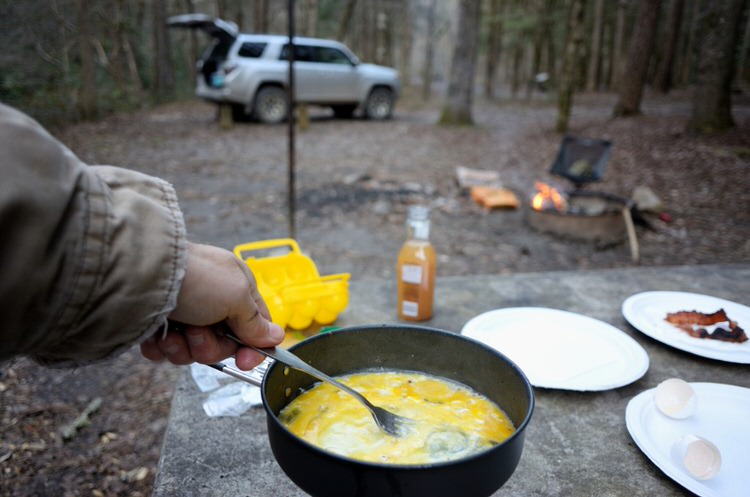
Photo by sshepard via iStock
Remember as well that you’ll have all sorts of gear with you that might need mending. A needle and thread is useful for patching torn clothes or a hole in your tent. A screwdriver is handy for tightening up loose screws on your car, camp chair , or roof rack as well.
Since you’ll be on the road for an extended period of time, you’ll need something to keep your food in, means of refrigeration (either via a cooler or a small fridge for the car), kitchen items like a camp stove, pots and pans, plates and bowls, and the like, and water storage.
Include a first-aid kit as well. You never know when you might need it!
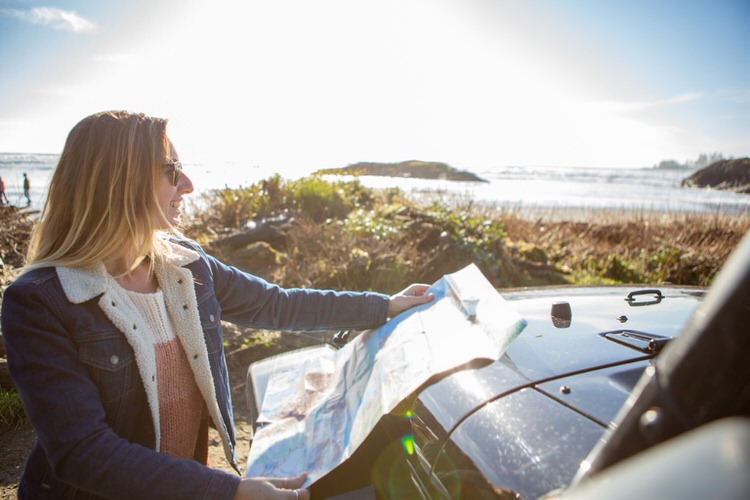
Photo by swissmediavision via iStock
I always bring printed maps of my intended route, too. While GPS is great, batteries can die (or the GPS can simply be wrong), so having a good ol’ map will give you some peace of mind.
A satellite phone isn’t a bad idea for extended trips, particularly if you aren’t sure of the cell service. I also have a CB radio installed in my Jeep to give me extra reach in case of an emergency in which I don’t have cell service.
Of course, you need items like a tent, sleeping bags and pads, camp furniture, and other “household” items for your trip. Fortunately, using your car as your backpack means you don’t have to worry as much about weight.
Pro Tip: You don’t need to bring your entire house with you. Don’t overload your vehicle as it will put undue stress on the suspension in addition to negatively impacting the fuel economy.
Guide to Overlanding : Planning and Preparation is Key
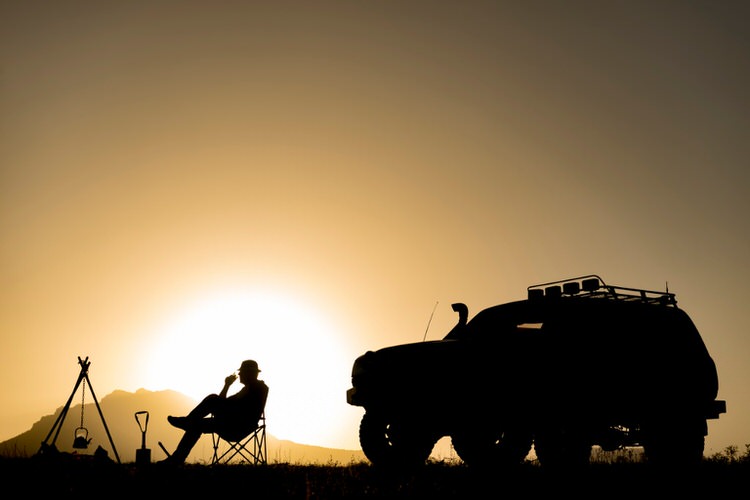
Photo by Huseyin Bostanci via iStock
Overlanding isn’t really something you should do on a whim. Planning and preparation will be key to your success – and your safety as you travel.
Having things like extra food, extra water, spare parts, and extra fuel will help get you through emergency situations. But so too will understanding basic first aid, how to read a map, and how to use a compass.
Using common sense helps too – read road signs, pay attention to potential hazards, use good judgement as you travel, and understand what your vehicle can and cannot reasonably do. Also tell someone when you leave, where you’re going, how you’re getting there, and when you expect to arrive. Check in periodically so your contact knows where you last were.
This isn’t meant to make you think that overlanding is hard or dangerous. But having a safety net to support you is critical whether you’re going off on a weekend trip a few hours from home or whether you’re setting out for a three-month cross-country trip.
So, if you’re ready to go overlanding, use these tips and our other overlanding articles to help you plan and prepare. It’ll be a fun journey – especially if you have all the right gear to help you along!
- guide to overlanding
- overlanding
- overlanding accessories
Related Articles
Latest articles, 3 incredible examples of what a ford conversion van can be, off-road tire maintenance tips and tricks.

© Copyright - 4wdtalk 2020 - 2024 | Privacy Policy | Terms and Conditions
- Gear Showcase
- Editors’ Choice
- Events News
- Industry News
- Trips & Trails
- Industry Spotlight
- Community Spotlight
How-to: Plan an Overlanding Trip
- May 16, 2022
Planning a trip is the first step to getting out there and having the adventure of your dreams. If you’re just starting out in overland travel, here are a few tips to take you from map to trail in no time flat.
Where are you headed?
Whether you have your sights set on a cross country trip or a long weekend in your home state, start your trip planning by choosing a destination or a region of interest to get you pointed in the right direction. In the world of overlanding, we often say that the journey is the destination, but setting a goal will help guide your path.
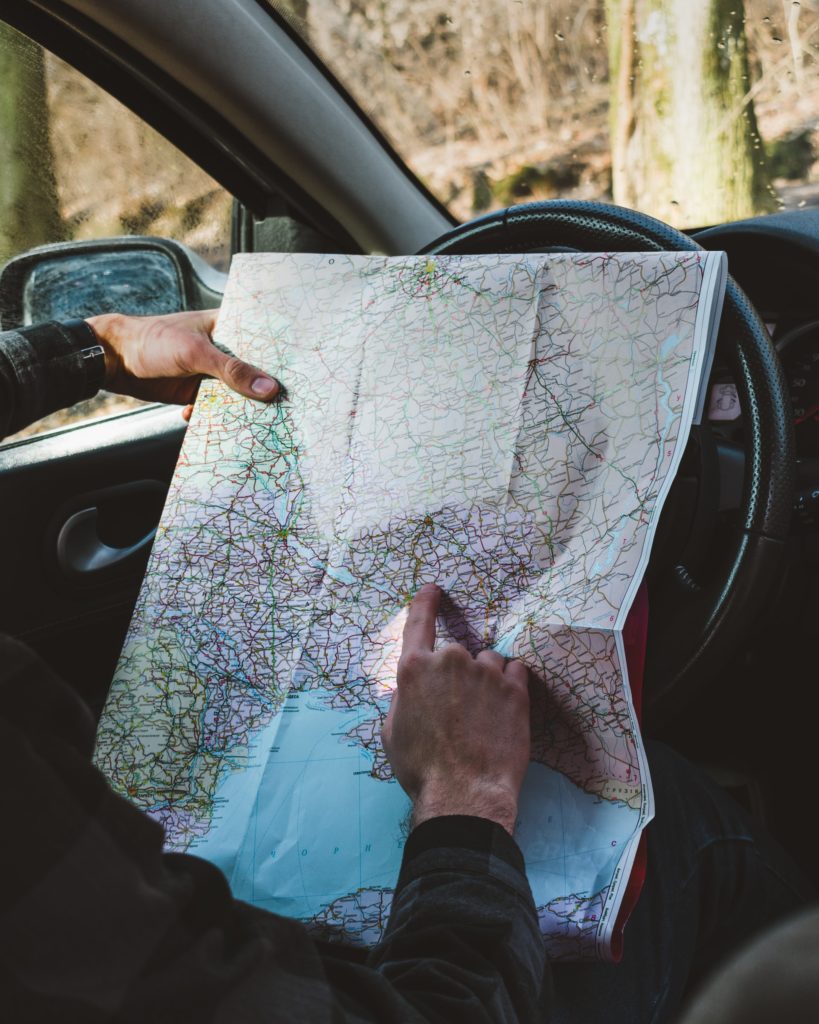
Determine how much time you have for your adventure and remember to be reasonable with your expectations. Overland travel has a way of taking longer than you might expect and there’s nothing worse than feeling rushed when you’re deep in the backcountry. It is far more satisfying to dial down your daily mileage in favor of exploring the spur trails and points of interest, rather than just rushing along to the next campsite.
READ MORE: What Is Overlanding?
A reasonable travel goal can range from 50 to 200 miles of off-road travel per day. Your distance will vary depending on a range of factors from your skill level, to your choice of vehicle, to the type of terrain you decide to tackle. Remember that it’s always better to get into camp early with daylight to burn than to still be slogging along once the sun has set.
If you are interested in learning more about trip planning and overlanding in general, Overland Expo makes a great waypoint to aim for. Every event is located in the heart of a fantastic overlanding destination so you can plan a great route to get there and leave with all the knowledge you need to head out on your next adventure.
How are you getting there?
There are lots of resources to help you determine your route, including the Trips & Trails section here on the Compass . Once you have a destination and timeline in mind, figuring out your route is where the fun begins. This is not the time to jump on the highway and make a beeline for the KOA that popped up in your google search. Get out the maps and start building a great route.
Paper atlases and gazetteers are one of the best ways to get a wide-angle view of the area you are headed to, as are the Butler Motorcycle Maps if you’re traveling on two wheels. Google Maps are also very helpful for getting an overview of the region and turning on the satellite and terrain layers will give you additional insight into the area.
Once you’ve gotten a lay of the land, start to focus on what piques your interest the most. Recreation atlases will give you additional insight into things like camping areas, hiking trailheads, and historic markers. Forest Visitor Maps provide information on attractions, facilities, services, and activities.
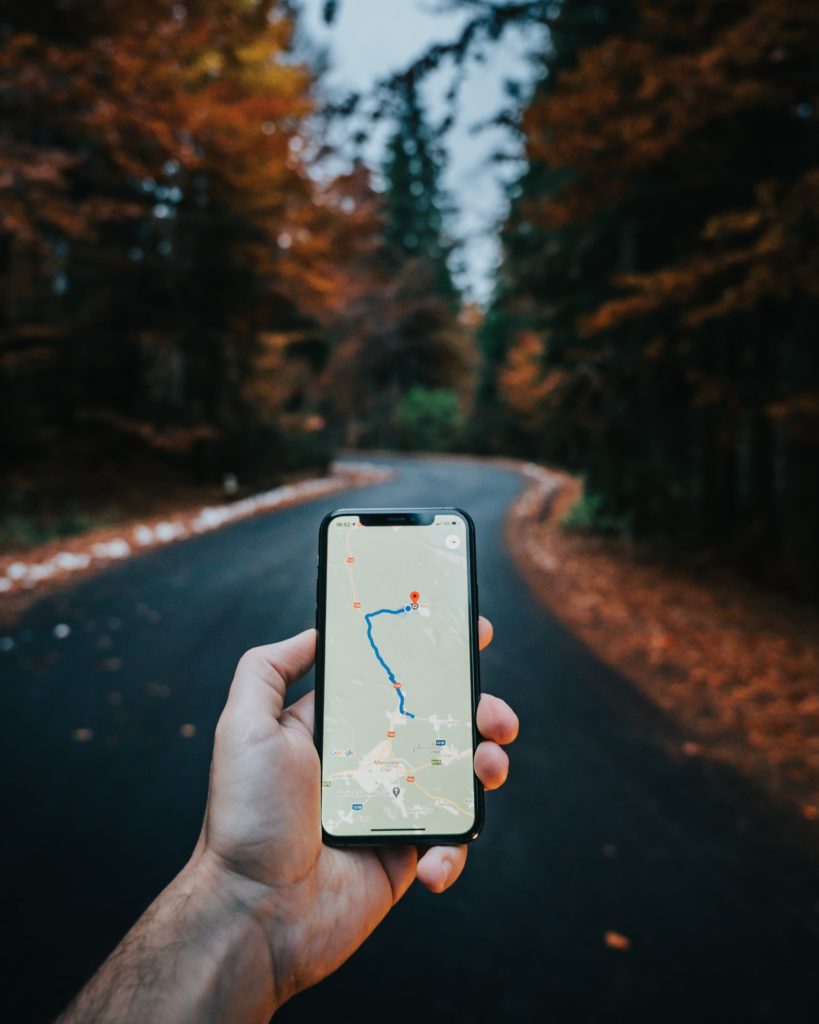
If you prefer your trip planning on the digital side, there are tons of great programs out there. Apps such as onX, Gaia GPS, and REVER have scaleable views, offline mapping options for use when you’re out of cell range, and layers to give you insight into land management and terrain. Apps such as Sekr and iOverlander can help you find campsites, as well.
As you’re pouring over all your mapping resources, remember that this is an overland trip and you will require fuel on a regular basis. Figure out your vehicle’s range and plan your fuel stops frequently enough so that you’re not sweating it out in the red or, even worse, running out of gas far from the nearest gas station.
Whether you are in a four-wheeled vehicle or on a motorcycle, figure out your range and remember to account for slow speed, low gear travel that can greatly alter your MPGs compared to when you’re just cruising along on the tarmac.
What are you bringing?
There is nothing better than a day of dirt road travel that ends at a fantastic campsite. For your overland travels, you’ll want to have everything you need to eat and sleep comfortably at camp. Driving and riding require skill and concentration, both of which depend on getting a good night’s sleep, staying hydrated, and consuming a few quality calories.
READ MORE: How to : Start Overlanding
Your camping gear doesn’t need to be fancy, but having gear that helps ensure some proper rest is key. When you plan your camp kit, make sure you have the basics for shelter and warmth: a tent or other shelter and a sleeping bag and pad to insulate you from the ground. Your camping setup will vary greatly depending on the time of year and what your rig is, but as long as you have a few creature comforts, you’ll be sleeping under the stars in no time.
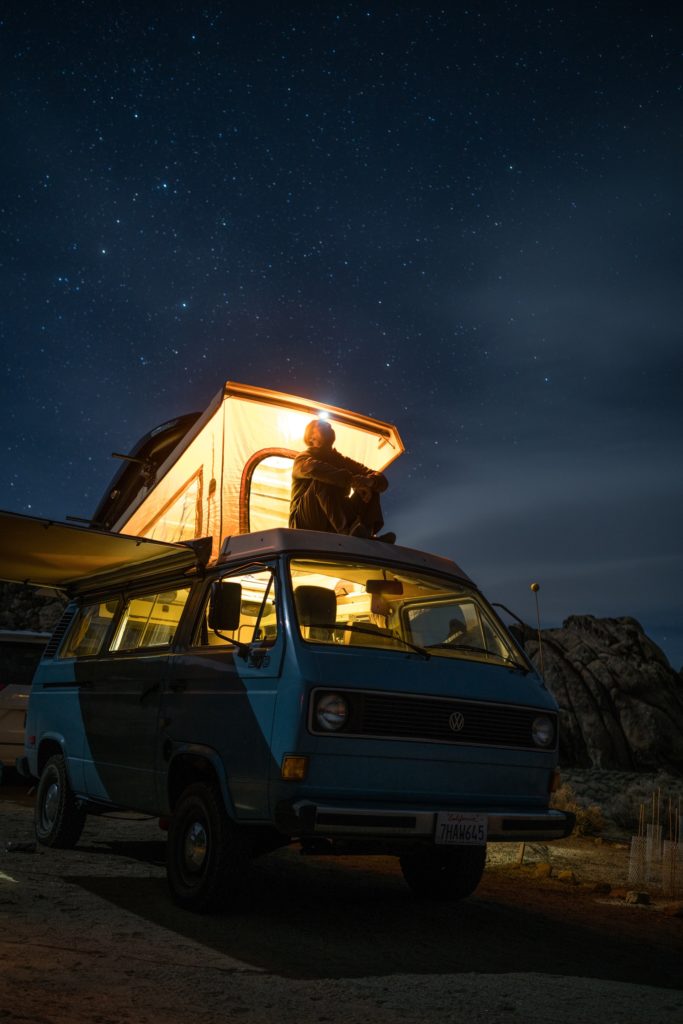
Just because you’re headed out for three days or three weeks, don’t feel like you need an entire trip-worth of water. It is often easier and more efficient to plan your water around frontcountry refueling stops. When you head out, bring at least what you’ll need to get to the next gas station, plus a little extra in case you get into a bind. When you fill up your truck, restock your water at the same time, especially in hot and dry environments.
When it comes to food for your journey, everything from freeze dried backpacking meals to filet mignon tastes better when you cook it at camp. You can keep it simple or go full-on gourmet, but remember that you’ll need everything to prepare, eat, and clean up after your meal. Plan on bringing the sort of stove, pots and pans, and dishes that will suit your needs and cooking ambitions. Also, don’t forget to bring a trash bag to dispose of scraps and packaging so you leave your campsite better than you found it.
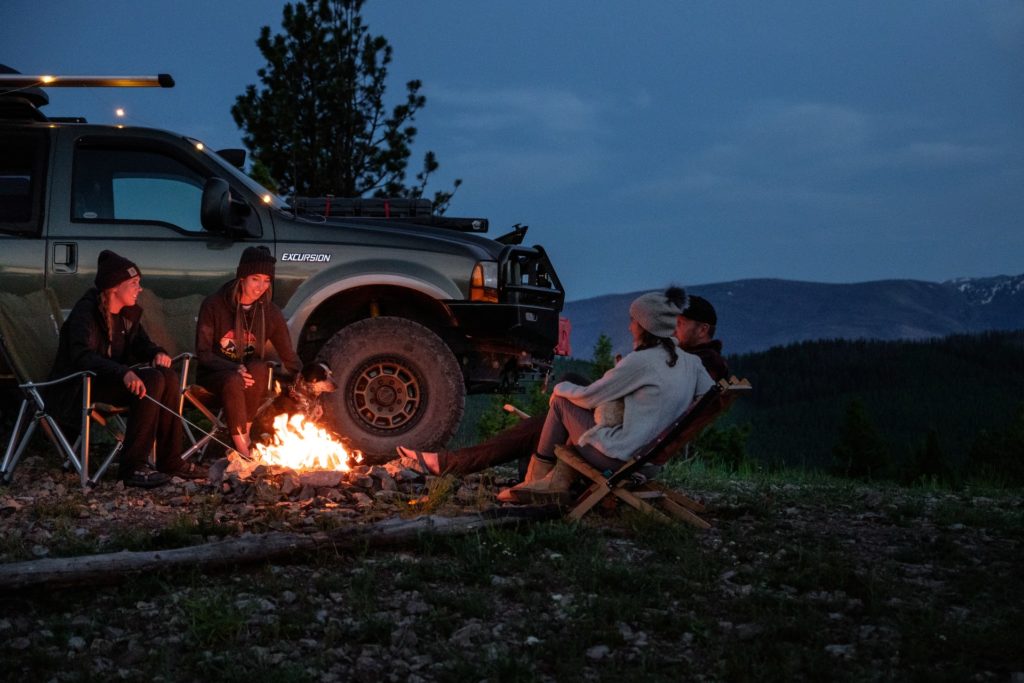
When it comes to trip planning, it is of utmost importance to be honest with yourself about your timeline and skill level. A moderate trip that gently pushes your comfort zones is far more productive and way more fun than getting in over your head when you’re new to backcountry travel. There is no shame in taking an easier route if you’re traveling solo or new to overlanding. After all, the idea is that you’ll take this trip and, as soon as it is over, you’ll return home stoked to start planning the next one and the one after that.
Latest Stories

Don't Miss the Storytelling Pavilion

All Things Moto at Overland Expo West 2024

Industry Spotlight: Imtra
Photo by Brett Willhelm
THE WORLD IS WAITING.
- The Mountains
Outdoor Gear Reviews, Tips & Adventure Stories to Inspire an Outdoor Life
Off the beaten path: a beginner’s guide to overlanding.
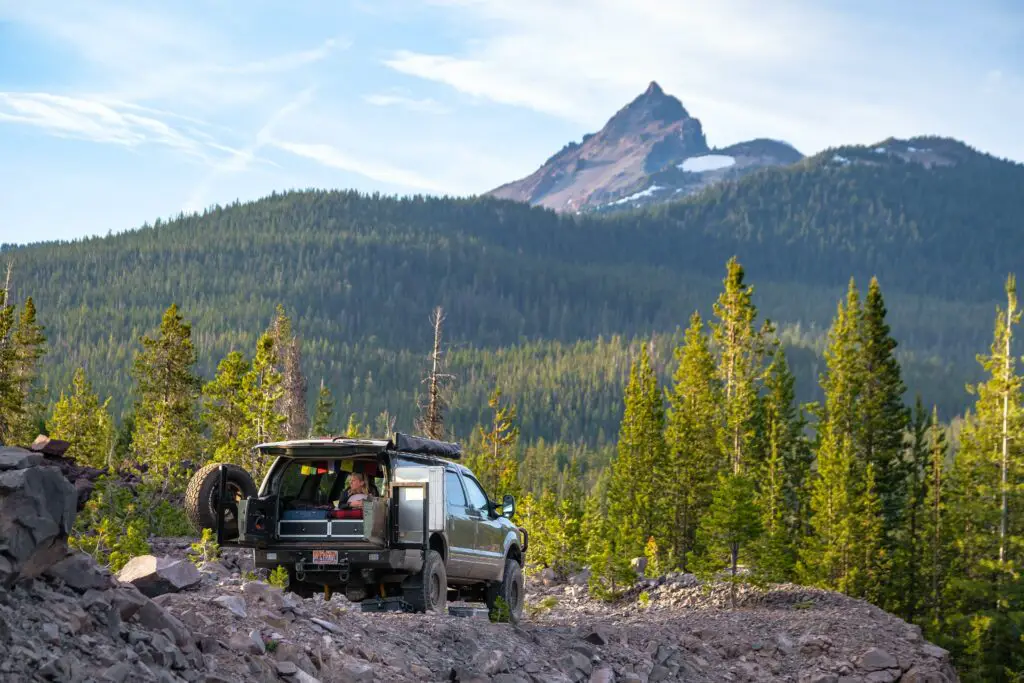
Have you ever wanted to experience the freedom of the open road and explore the world on your own terms? If so, overlanding may be the perfect way for you to do it. What’s overlanding? Overlanding is a type of travel that involves self-reliant, off-road adventure in a vehicle, usually a four-wheel drive. This type of travel allows you to experience remote and untouched destinations, away from the typical tourist crowds.
Overlanding has been gaining popularity in recent years, and for good reason. It offers an opportunity to explore new places, meet new people, and challenge yourself in ways you never thought possible. In this beginner’s guide, we’ll take a closer look at what overlanding is, what it involves, and how to get started. Whether you’re a seasoned traveler or someone looking for a new adventure, this guide will give you the information you need to plan your own overlanding trip. So buckle up and let’s hit the road!
Understanding Overlanding
What’s overlanding? Overlanding is a form of outdoor exploration that involves self-reliant, off-road adventure in a vehicle. Unlike traditional road trips, overlanding often involves remote and challenging terrains that require a certain level of skill and experience. The goal of overlanding is to explore new and untouched destinations, away from the typical tourist crowds.
We like to think of overlanding as car camping without the campgrounds. How far off the beaten path you travel to get to your camping destination is up to you and the ability of your vehicle. While similar in many ways to car camping, there are some key characteristics of overlanding that differentiate it from other forms of outdoor exploration:
Self-reliance
Overlanding requires you to be self-sufficient, meaning you need to carry all the supplies and equipment you’ll need for the journey. This includes everything from food and water to shelter and tools. Another aspect you’ll need to consider when overlanding is how you’ll use the bathroom while in remote spaces. For more information, check out our article on bathroom off-grid options .
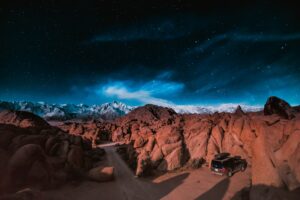
Off-road travel
Overlanding often involves traveling on unpaved roads and rugged terrains that require a four-wheel drive or other specialized vehicle. All-terrain tires are also a good idea. But even if you don’t plan to tackle difficult terrain while overlanding, a vehicle with high ground clearance is a good idea.
Remote destinations
Overlanding is all about exploring new and untouched destinations that are far away from the typical tourist hotspots. This often means traveling to remote areas that are difficult to access. The difficulty in accessing these areas is what makes overlanding so special – being able to enjoy wild spaces that not many others have.
Adventure and challenge
Overlanding is not for the faint of heart. It requires specialized equipment, a certain level of skill and experience, and a willingness to take on challenges and overcome obstacles. The adventure lies in getting to your remote destination and learning to appreciate your ability to be self-sufficient.
While overlanding has gained popularity in recent years, it’s not a new concept. In fact, overlanding has been around for centuries, with early explorers and pioneers traveling across vast distances in search of new lands and opportunities.
Planning an Overlanding Trip
Planning an overlanding trip requires careful consideration of several key factors. Here are some important things to keep in mind when planning your trip:
- Choosing a destination: The first step in planning an overlanding trip is to choose a destination. Consider what type of terrain and scenery you’re interested in exploring, and whether you want to stay close to home or venture further afield. We like to use Campendium to find free camping areas on public lands in the US.
- Deciding on the route: Once you’ve chosen a destination, it’s time to decide on the route you’ll take. Consider factors such as the terrain, the time of year, and the availability of fuel and supplies. It’s a good idea to also consider a backup route or two in case your primary route choice is closed or unpassable.
- Considering the time of year: The time of year you plan to travel can have a big impact on your overlanding trip. For example, if you plan to travel during the rainy season, you’ll need to take extra precautions to ensure your vehicle is equipped to handle muddy roads. Overlanding during the winter season can provide amazing opportunities to experience nature in rugged isolation, but you’ll need extra preparation to make sure you stay warm enough.
- Planning for fuel, food, and water: You’ll need to carry all the supplies you’ll need for the journey, including fuel, food, and water. Make sure to plan ahead and carry enough supplies to last the duration of your trip.
- Preparing the vehicle: Overlanding requires a four-wheel-drive vehicle that’s equipped to handle rough terrain and challenging conditions. Make sure your vehicle is in good condition and properly equipped with the necessary gear, such as all-terrain tires, a winch, and recovery equipment.
By carefully planning your overlanding trip, you can ensure that you have a safe and enjoyable experience. Proper preparation is key whenever you travel away from the security of stores, gas stations, and emergency services.
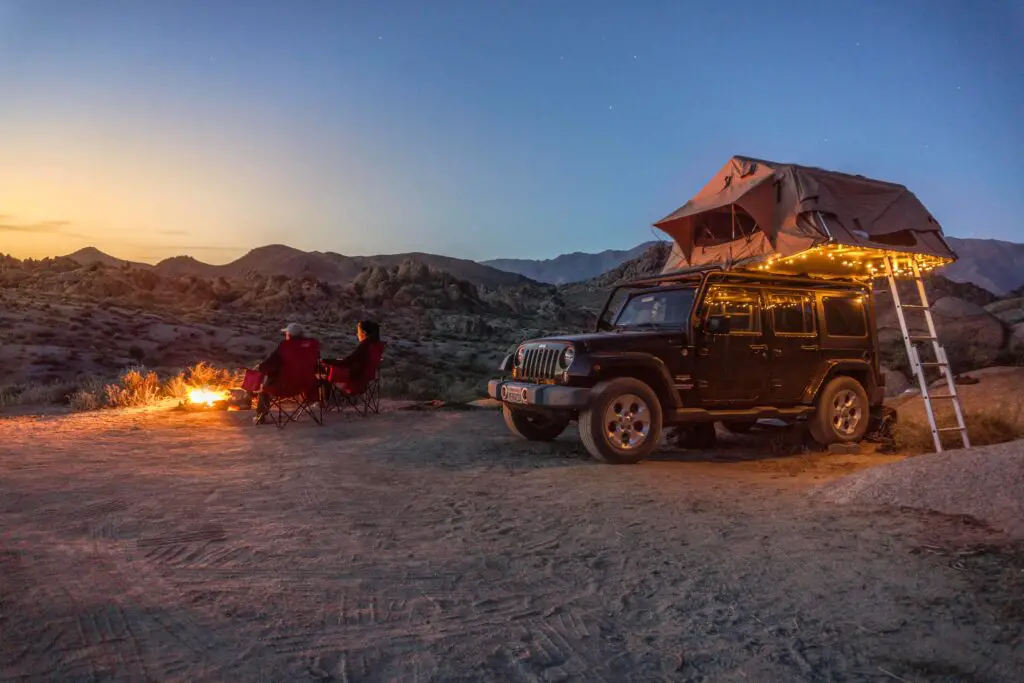
Essential Gear for Overlanding
When embarking on an overlanding trip, it’s essential to have the right gear to ensure your safety and comfort. Here are some essential items you should consider bringing on your trip:
- Navigation tools: When traveling off-road, it’s important to have reliable navigation tools, such as a GPS device or map and compass.
- Communication devices: In case of emergencies, it’s important to have a reliable means of communication, such as a satellite phone or radio. We recommend carrying a satellite communicator when traveling to remote places without cell phone coverage.
- Recovery gear: Overlanding often involves traversing rugged terrain, so it’s important to have recovery gear, such as a winch, recovery straps, and a shovel, to help you get unstuck if you get stuck in mud, sand, or snow. The level of recovery gear you’ll need will be related to how deep into the wild you plan to go. What’s overlanding without getting stuck from time to time? When it happens, make sure you have the tools and equipment you’ll need to get back on the trail.
- Camping equipment: When overlanding, you’ll need to carry all the equipment you’ll need for camping, such as a tent, sleeping bag, and camping stove. The overlanding industry has exploded in recent years with a variety of tools and equipment made for overland camping. Whether you choose to equip your vehicle with a rooftop tent or prefer to pitch a traditional tent once you arrive at your destination, a myriad of options are available to fit your preferences. We’ve purchased a lot of great and affordable overlanding gear from Overland Vehicle Systems in the past.
- Tools and spare parts: It’s important to carry a basic toolkit and spare parts for your vehicle, such as spare tires, oil, and fuses, in case of mechanical issues.
- First aid kit: Accidents can happen, so it’s important to carry a well-stocked first aid kit that includes essentials like bandages, antiseptic, and pain relievers. We like the carry the Mountain Series Explorer Medical Kit along on our trips overland.
- Water and food storage: Overlanding often takes you to remote areas, so it’s important to carry enough food and water for the duration of your trip, as well as storage containers to keep them fresh.
By packing these essential items, you’ll be well-prepared for your overlanding trip and can focus on enjoying the adventure. Making sure you have the right gear can save you from disaster while off the grid.
Safety Precautions
Overlanding can be an exciting and rewarding adventure, but it’s important to take the necessary precautions to ensure your safety. Here are some important safety considerations for overlanding:
- Vehicle maintenance: Before embarking on your trip, make sure your vehicle is in good condition and has been properly maintained. Check the tires, brakes, and fluids, and make any necessary repairs or adjustments.
- Driving cautiously: When overlanding, it’s important to drive cautiously and be aware of your surroundings. Stay alert for hazards like rocks, mud, or water crossings, and take your time when navigating difficult terrain.
- Packing essential safety gear: Make sure to pack essential safety gear, such as a first aid kit, fire extinguisher, and emergency communication devices , to help you stay safe in case of emergencies.
- Knowing the local laws and customs: When traveling in a foreign country or unfamiliar territory, it’s important to understand the local laws and customs to avoid any legal or cultural misunderstandings.
- Being aware of wildlife: When traveling in remote areas, it’s important to be aware of the local wildlife and take necessary precautions to avoid any dangerous encounters. Be careful not to disturb the habitats of the local wildlife as you’re passing through.
- Keeping in touch with others: Make sure to keep in touch with family or friends back home and let them know your itinerary and expected return date. This way, they can check in on you and alert authorities if necessary.
By taking these safety precautions, you can help ensure that your overlanding trip ends with a successful return home and many memorable moments.
Overlanding Etiquette
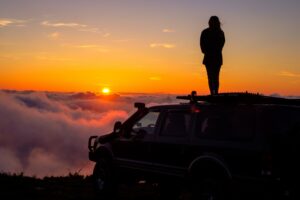
Overlanding is a unique way of exploring the outdoors, but it’s important to remember that it’s not a free-for-all. Here are some important overlanding etiquette tips to keep in mind:
- Stay on designated trails: It’s important to stay on designated trails to avoid damaging the environment and preserve the natural beauty of the area.
- Leave no trace: When camping, make sure to pack out all your trash and leave the campsite as you found it. This helps preserve the natural environment for others to enjoy.
- Respect private property: Make sure to respect private property and obtain permission from landowners before entering their property.
- Be mindful of noise: When camping in remote areas, it’s important to be mindful of noise levels and avoid disturbing the peace and quiet of the area.
- Yield to other vehicles: When encountering other vehicles on the trail, yield to the vehicle going uphill, as they have the right of way.
- Be considerate of other campers: When camping near others, be considerate of other campers and keep noise levels down, especially at night.
By following these overlanding etiquette tips, you can help preserve the natural environment and ensure a positive experience for all.
Get Out There and Overland
Overlanding is a unique and exciting way to explore the outdoors, but it’s important to approach it with the right mindset and be prepared for the challenges it may present. By understanding the basics of overlanding, planning your trip carefully, and bringing the right gear, you can ensure a safe and enjoyable experience.
Remember to take necessary safety precautions, follow overlanding etiquette, and be respectful of the natural environment. With the right approach, overlanding can be an unforgettable adventure that allows you to connect with nature and explore the world off the beaten path.
Share this post:
About the author.
Zack Newsome
You may also like.
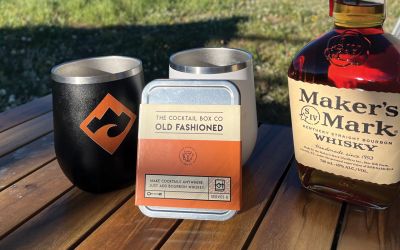
The Cocktail Box Co.’s Old Fashioned Cocktail Kit Review
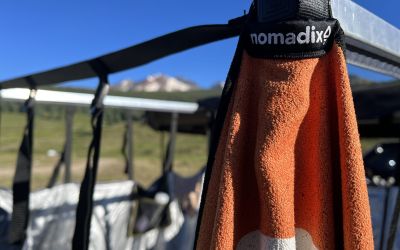
Nomadix Original Towel Review
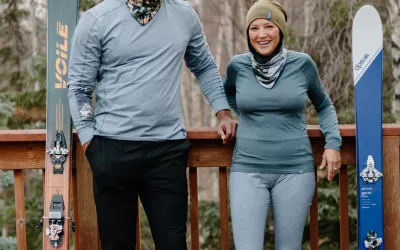
A Base Layer that Doesn’t Stink: A Review of the Alpine Fit Long Sleeve
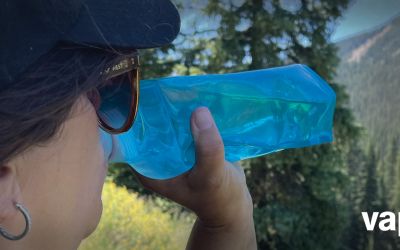
From Backpacks to Pockets: A Review of the Vapur Flexible Water Bottle
Leave a reply cancel reply.
Your email address will not be published. Required fields are marked *
Save my name, email, and website in this browser for the next time I comment.
Post Comment
Popular Articles
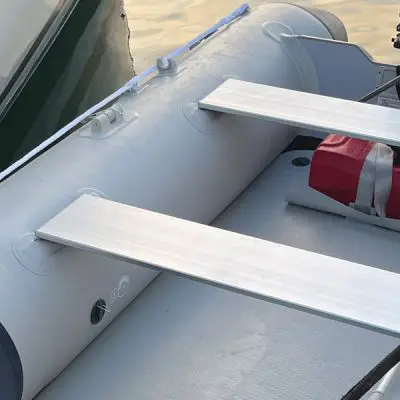
Hands-On Review: Tobin Sports Inflatable Boat
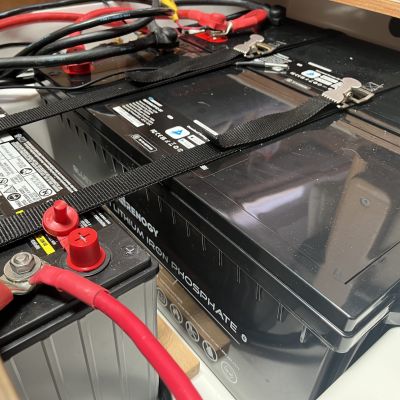
Hands-On Review: Renogy 200Ah Lithium Iron Phosphate Battery
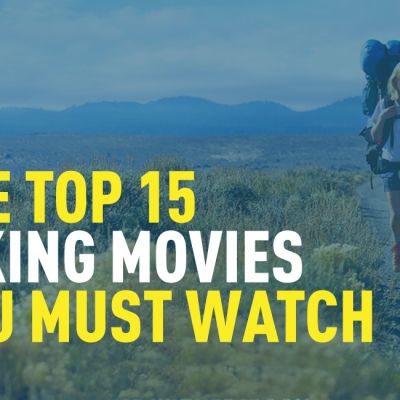
Trailblazing Tales: The Top 15 Hiking Movies You Must Watch
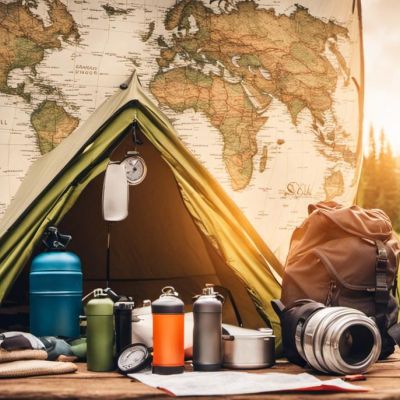
The Ultimate Guide to Solo Camping
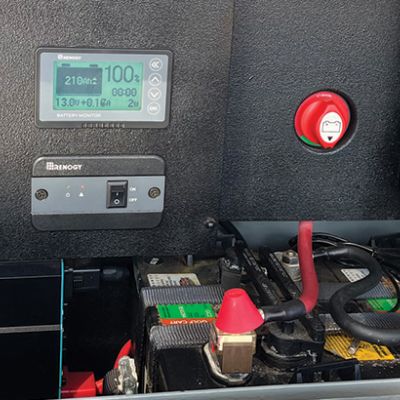
The Outward Overland Trailer: Electrical System Design & Diagram
Recent articles, 15 camping activities to keep the whole family entertained, unforgettable camping for couples: a guide, on top of the world: 6 mountain climbing movies that will leave you breathless, hands-on review: trelino® evo s composting toilet, paddling paradise: kayaking the colorado river.
Interested in overlanding? Here’s where to start and what to know
Overlanding combines camping and off-roading for self-supported adventures in remote, largely untouched areas
By Madeleine Balestrier
Imagine turning off the highway, away from traffic, paved roads, and amenities. When overlanding, you’ll be driving your rig onto stretches of road touched more by nature than humans, and enter a seemingly unknown part of the world with only your vehicle, gear, and sense of adventure. Here you can explore stunning vistas, maneuver around spiring rock formations, and sleep under the guise of looming mountains.
Overlanding is a combination of camping and off-roading. Camping and overlanding embody sleeping in nature. So, what’s the difference between overlanding and camping? Camping emphasizes sleeping at a destination, while overlanding is more about the journey to get there.
Related How to off-road like a pro in your own vehicle
Overlanding and off-roading activities share an interest in exploring hard-to-reach natural places. These experiences rely on vehicles that can navigate unpaved surfaces and drivers who can fix and maintain their rigs. So, what’s the difference between overlanding and off-roading? Off-roading typically seeks out day trips on unpaved technical roads. Overlanding is self-supported touring of natural environments over an extended period.
If you’re interested in getting started overlanding, here’s what you need to know.
Before you start overland camping, the most important—and exciting—part of the process is researching and planning.
Tap into resources like social media, overlanding forums, and local gear shops. YouTube, Facebook, and Reddit are valuable sources on how to build out your vehicle. Subscribe to the Overland Journal to learn from industry professionals and experts. Seeking out local resources is helpful as well—gear shops can help with camping gear, while mechanics can help with vehicle maintenance and knowledge.
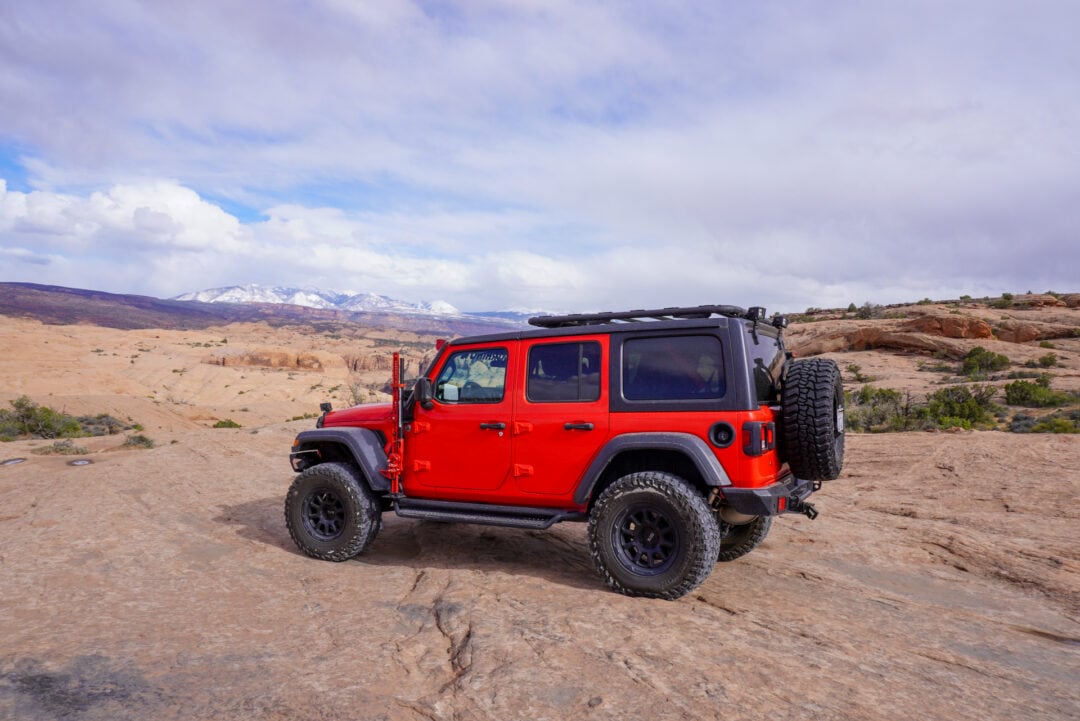
Vehicle
Your overlanding rig is crucial. It’s your home, mode of transportation, and adventure mobile. Before embarking on an overlanding excursion, prepare your vehicle. Make sure it’s reliable and equipped to handle your planned route. A broken-down rig in remote wilderness with no cell phone service is a dangerous situation.
Safety
Like any outdoor activity, overlanding comes with risk. Some dangers to plan for are vehicle accidents, breakdowns, getting stuck, and natural disasters.
These risk factors shouldn’t deter you but instead encourage you to plan and prioritize safety. Share your plans with others, invest in proper safety equipment for you and your vehicle, and make the hard decision to turn back during uncertain conditions. Be sure to take the initiative to understand your vehicle’s limits.
How to pick a vehicle for overlanding
What makes a vehicle ideal for overlanding? The best adventure rigs are secure, reliable, and safe on and off the road. There are several vehicle types and aftermarket features that can help you achieve this.
A four-wheel drive vehicle will give you peace of mind in dicey areas and access to areas with sand, mud, rocks, snow, and other variable terrains.
Quality tires are also essential for an overlanding vehicle. There are different tires to choose from depending on what kind of overlanding you want to do. Do you mostly travel off-road? Do you come across a lot of snow or sand? Answering these and other questions will help you narrow down your options.
An overlooked aspect of purchasing and personalizing an overlanding vehicle is access to spare parts and maintenance . Overlanding rigs push the limits. Your car will break down and need care. Avoid rigs with hard-to-find parts or complex mechanics.
Other features to consider when picking a vehicle for overlanding are suspension, gearing, capacity and weight, and protection. What are the best overland camping vehicles with these qualities?
Best overland trucks
- Toyota Tacoma
Best overland camping vehicles
- Ford Transit
- Jeep Wrangler Rubicon
- Land Rover Defender 110 SE
Best overland camping trailers
- Boreas Campers
- Escapade Campers
- Tentrax Trailers
Best budget-friendly overlanding vehicles
- Jeep Cherokee XJ
- Subaru Outback
- 80 Series Toyota Land Cruiser
Overland setup
An overland gear list varies based on the person, route, and weather, but here’s a list of must-haves for overlanding to get you started.
Related 20 overlanding essentials: Gear and gadgets for the ultimate off-road camping adventure
First aid kit
A first aid kit is crucial for any outdoor activity. Your overlanding kit should include gauze, bandages, wound cleaning agents, an emergency blanket, a splint, and anything else you can fit. Account for allergies and any other medical needs.
Emergency communication device
If you’re exploring the backcountry, bring an emergency communication device, like the Garmin inReach Mini . An emergency communication device is a two-way satellite communicator that will call for help even without cell service. Some models also provide weather reports and GPS information.
Vehicle recovery kit
There’s a high chance that your rig will get stuck when overlanding. This is where a vehicle recovery kit comes in handy. Your vehicle recovery kit should include tow straps, recovery boards, shackles, a jack, jumper cables, rope, and tree straps.
Related 12 tire and hitch accessories to add to your next adventure
Basic tools
In addition to basic tools such as wrenches and sockets, consider bringing shovels, axes, flashlights, and spare parts.
Portable air compressor
Airing down your tires improves traction, and traction is crucial in overlanding.
Tire repair kit
A tire repair kit is something every vehicle should carry. Practice changing your car tires before you head out on your first overlanding trip.
Water storage
When it comes to water, bring at least 1 gallon of water per person per day. For extra precaution, pack a water filter too.
Cooking equipment
Overlanding offers the luxury of packing more for prepping, cooking, and eating a delicious meal in a beautiful landscape. One-pot recipes are delicious and come with easy cleanup. Invest in quality cooking tools, a cooler, stove, and anything else that will elevate your experience.
Overland camping gear
The rest of your gear will be similar to a car camping setup. When packing your rig, be conscious of weather, how you want to sleep, power supplies, other luxuries, and weight capacity.
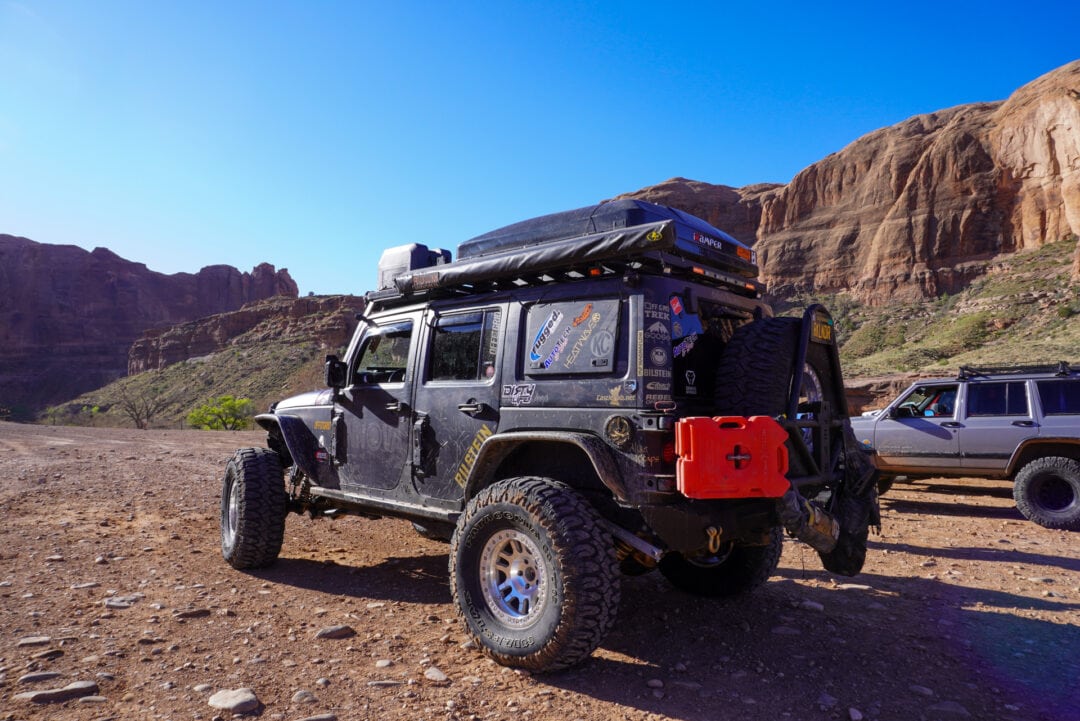
Overlanding tips and tricks
- Know before you go. Research and plan for the route, weather, road conditions, meals, local wildlife, and camping sites.
- Download your vehicle’s manual to your phone.
- Follow Leave No Trace principles.
- Drive with other people. If you’re just starting out, traveling with a caravan of overlanders will make you feel more safe and comfortable, and you’ll learn more about how you want to overland in the future.
- Carry a paper map as a backup.
- Prepare a few frozen gallon water jugs before your trip. This will keep your food colder longer, and you can use it as drinking or cooking water.
- Store your gear in the order that you need it. Keep similar items together in color-coded or clear boxes and bags for organization.
- Take a few shorter trips to figure out your ideal sleep system.
How to plan an overland camping trip
These resources can help ease stress and cover unforeseeable circumstances when planning an overland camping trip.
- Overland Expo is an event that takes place a few times a year in locations across the United States. The event is hosted in the West, East, Pacific Northwest, and Colorado. A ticket to Overland Expo gives you access to roundtables, demonstrations, and vendors all dedicated to the outdoors and overlanding.
- iOverlander is an app for finding places to travel and camp off the beaten path. It’s useful in finding remote places to camp, including national forest land and urban stealth camping spots.
- Gaia GPS is a mapping service that allows you to navigate using the United States Geological Survey and the United States Forest Service maps. The app also has a feature called the Motor Vehicle Use Maps that informs you of restrictions for high-clearance vehicles and seasonal road closures.
- Expedition Portal is an online forum for overlanders to connect.
- Recreation.gov is a resource for finding federal campgrounds, like the Bureau of Land Management (BLM) and U.S. Forest Service sites.
- Roadtrippers features everything from campgrounds to things to do, places to eat, and road services along your route.
- Campendium helps you find places to camp, with in-depth reviews from other Campendium users. The app features boondocking sites, free campgrounds, RV parks, and more.
- GasBuddy is an app that helps you find the cheapest gas on your road trip.
It’s also worth asking local gear stores along your route for recommendations and current conditions.
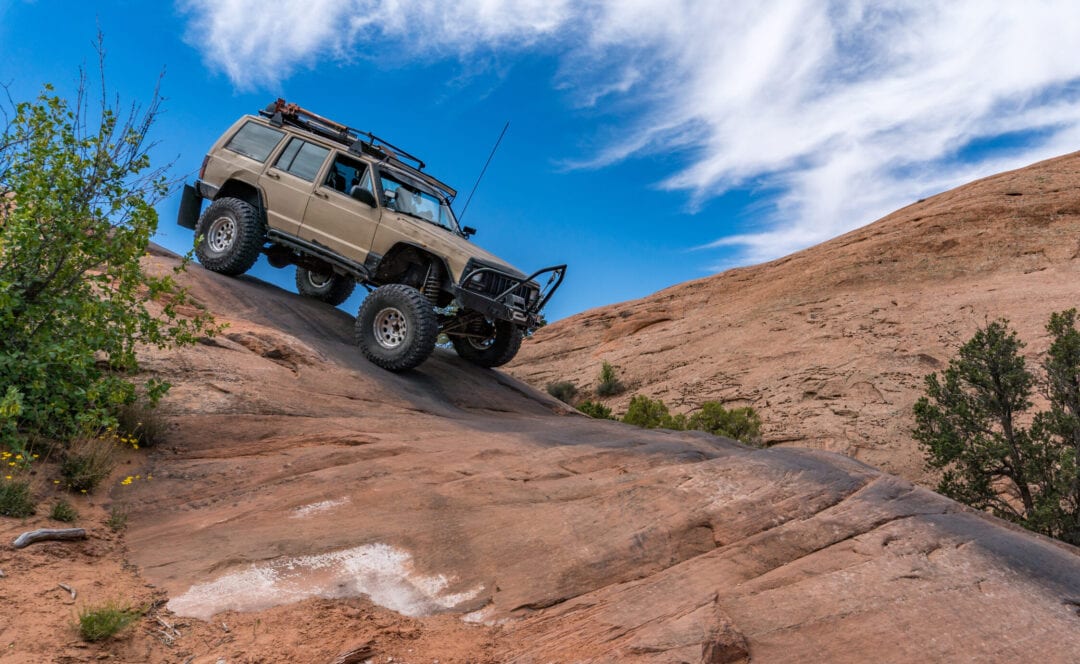
The best state for overlanding depends on the person and what they’re looking for. Utah has dramatic desert scenery and off-roading trails, while California and Oregon offer longer routes and diverse landscapes and geographical features. Colorado is home to nearly 8.3 million acres of BLM land. The East Coast is great for beach and sand overlanding adventures.
Related 7 overlanding routes with campgrounds nearby
When looking for overlanding campsites, utilize the resources listed above, like iOverlander and Campendium. Once you’ve figured out where you want to camp, download directions to each site, and prepare your vehicle for the surrounding environment.
Overlanding is a higher-risk, higher-reward version of car camping, far away from traditional campgrounds.
Where you sleep when overlanding is your choice—in a car, tent, or hammock. Rooftop tents are a popular option with overlanders.
You don’t necessarily need a 4×4 or four-wheel drive vehicle for overlanding. Four-wheel drive is an added security, but if you invest in quality tires, safety equipment, and recovery gear, you’ll be able to navigate most overlanding routes.
This article has links to products that were carefully selected by our editors. We may earn commission on your purchases from these links. Visit this page for the full details of our affiliate marketing policy.
Meet the Author

Madeleine Balestrier
Madeleine is a freelance writer who writes about the outdoors, travel, and cannabis. She loves being buried in the snow, running single-track, and eating cucumbers and gummies at the summit. When she’s not writing or traveling, you can find Madeleine in Telluride, Colorado working as a lifty or sleeping in her hammock.
- Related Articles
- Latest Articles
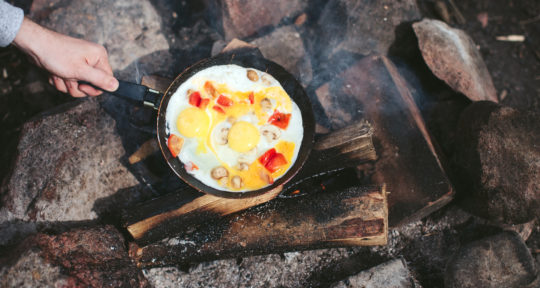
How to leave no trace during your summer road trip
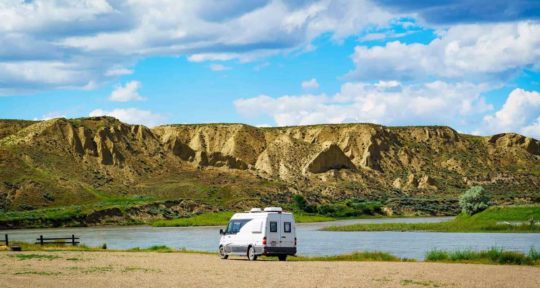
How to find a safe place to park your RV or van for the night
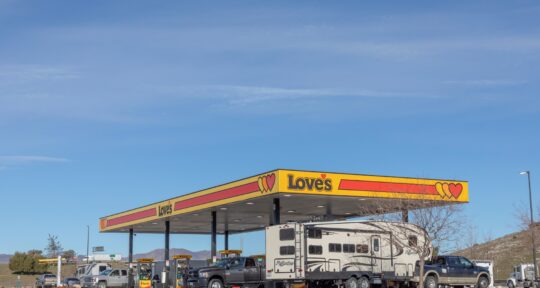
How to save on fuel and improve your RV’s gas mileage

The best festivals in the U.S.

New Hampshire’s Dartmouth/Lake Sunapee Region

What’s the Best AI Trip Planner?
Get the most inspiring stories from the road sent directly to your inbox..

- Trip guides
- Trip Planner
- Sign up Log in Sign out
- Log in Sign out
- ROADTRIPPERS MEMBERSHIP
- RV RESOURCES
Plan your journey, find amazing places, and take fascinating detours with our app.
We couldn't find an existing Roadtrippers account using that service. Please try signing in with another option or create a new account with Roadpass.
We need your email address to send you trip itineraries and other updates.

KÜHL’s Overlanding Guide: Our Tips on How to Get Started
Table of Contents [Show]
- 1. Key Takeaways
- 2. What is Overlanding?
- 2.1. What's the Difference Between Overlanding and Off-Road Driving?
- 3. Overlanding Gear Essentials
- 3.1. Navigation Tools
- 3.2. Communication Devices
- 3.3. Overlanding Recovery Gear
- 4. Other Overlanding Must-Haves and Accessories
- 4.1. Food
- 4.2. Water
- 4.3. Proper Clothing
- 4.4. Extra Fuel
- 5. Overlanding Vehicles
- 5.1. Third-Gen Toyota Tundra
- 5.2. Second-Gen Chevrolet Colorado Z71
- 5.3. JL Jeep Wrangler
- 6. Tips on How to Start Overlanding and Practice it Safely
- 7. Tips on Where to Go Overlanding
- 8. Final Thoughts
- 9.1. What is the price of overlanding?
- 9.2. Who goes overlanding?
- 9.3. Is 4WD necessary for overlanding?
- 9.4. Is a manual better for overlanding?
- 9.5. What is the longest overland route?
Overlanding is a trend that most outdoor lovers are curious about, but only a few die-hard wanderers have experienced it. Since you are here, you probably wonder, "What is overlanding?" and "Why should I try it?"
Well, here's your ultimate overlanding guide. We'll define overlanding and then dive into how you can get started with this travel style. In addition, we've included our thoughts on the best types of overlanding vehicles and popular overlanding destinations.
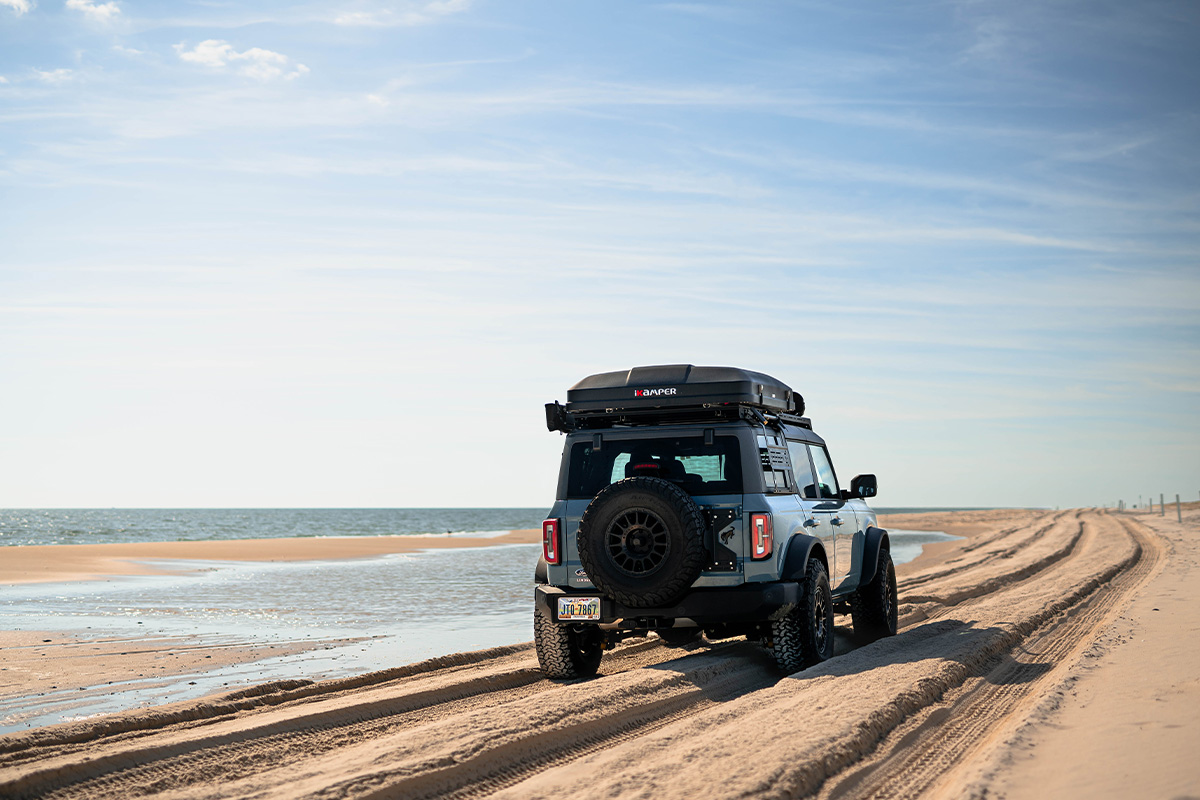
Key Takeaways
- An overland camping trip is a style of off-roading that involves long-haul driving on unmaintained roads to remote and untouched destinations.
- Overlanding or 4WD touring is unique from traditional camping trips in that the journey is the adventure, not the end destination.
- The point of overlanding is to disconnect from the grind, discover nature's lesser-known parts, experience different cultures, and strengthen one's survival skills.
- An overlanding gear list should include navigation tools, communication devices, self-recovery equipment, and camping and safety gear.
What is Overlanding?
A quick Google search of "overlanding meaning" will bring a ton of results about what overlanding is and isn't. That's because overlanding means a lot of things to different people.
Overlanding is a self-reliant journey, off the beaten path, through remote destinations, usually for days, months, or even years. An authentic overlanding experience involves crossing international borders, experiencing extreme cultural differences, and overcoming obstacles, such as language barriers, lack of infrastructure, limited technology access, and limited resources (finances, food, water, etc.).
Overlanding has elements of dispersed camping and car camping in it. From the definition above, living off your motorhome in a remote corner of Death Valley does not count as overlanding. However, it's an excellent way to build up your adventure spirit.
Unlike traditional camping trips, the real adventure when overlanding is the journey itself. It's an opportunity to test your ability to persevere and overcome various obstacles while experiencing nature's untouched beauty.
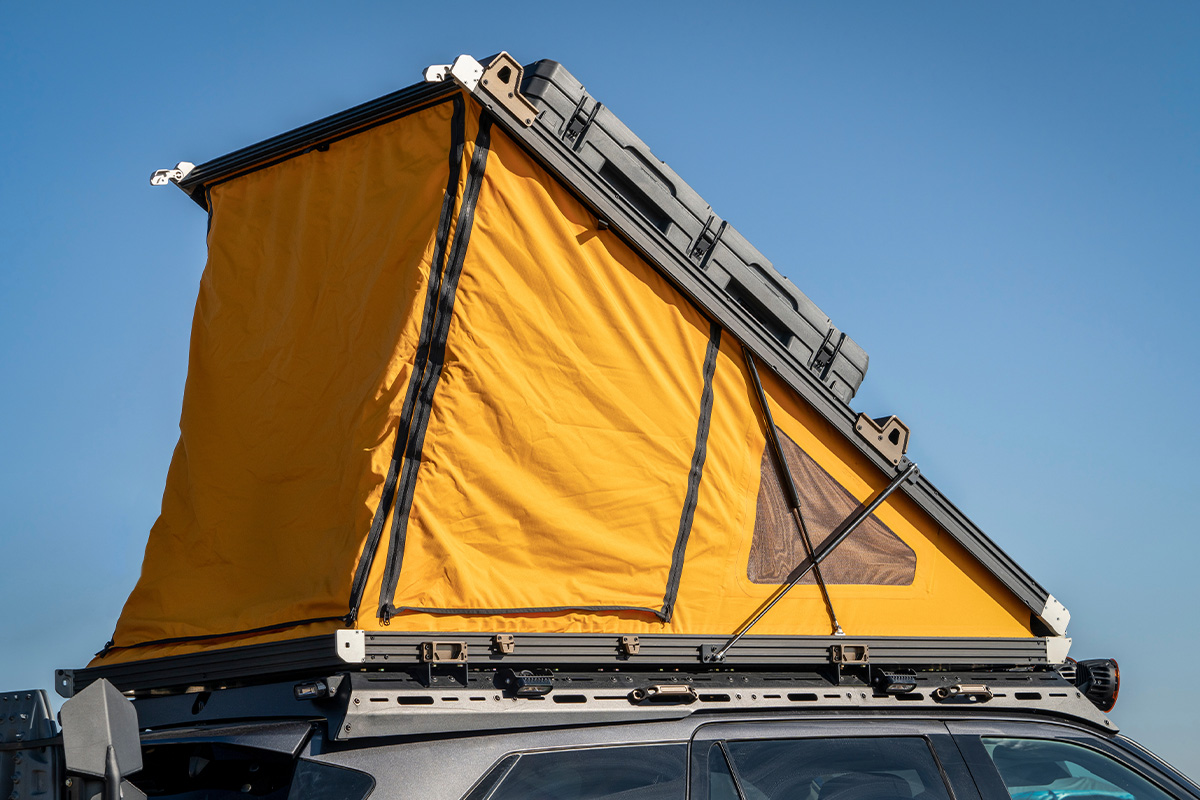
What's the Difference Between Overlanding and Off-Road Driving?
The terms overlanding and off-roading are often used interchangeably due to their numerous similarities. But the two activities couldn't be more different.
Let's start with some apparent similarities. Both activities involve driving through unpaved and challenging terrains like gravel, sand, stones, mud, and snow. Due to the nature of these activities, off-roaders and overlanders often travel ready for self-recovery.
The differences between overlanding and off-road driving become clear when considering aspects such as focus, duration, and accommodation.
Off-road driving is usually destination-based. Depending on the type of trip, the ultimate destination for the off-roaders could be a mud pool, a desert, a dune, a hill, etc. The focus is more on the adrenaline of pushing a vehicle's capabilities to navigate these rugged terrains. Second, off-roading is often within an individual's local reach, and they return home after the trip, meaning no need for camping.
Overlanding, on the other hand, is not destination-based. Although you'll encounter most challenges that come with off-roading, overlanding has a much broader focus. The ultimate goal is to connect with nature, experience different cultures, and exercise one's problem-solving skills.
Secondly, overlanding is more than your typical weekend trip. Overland adventures involve being away from home for a lengthy time, spanning weeks, months, or even a year. Overlanders camp in remote locations and typically sleep in a rooftop tent or pop-up truck camper. Our previous post dives deeper into how rooftop tents work, the various types, and how to choose a rooftop tent . Be sure to check it out.
Another difference between off-roading and overlanding is the type of gear involved. Off-roading equipment mainly focuses on self-recovery. However, an overlanding trip requires a higher level of self-reliance because it involves extended travel miles away from civilization. In addition to self-recovery equipment, overland enthusiasts typically pack camping gear and supplies, such as food, water, first aid supplies, and communication tools.
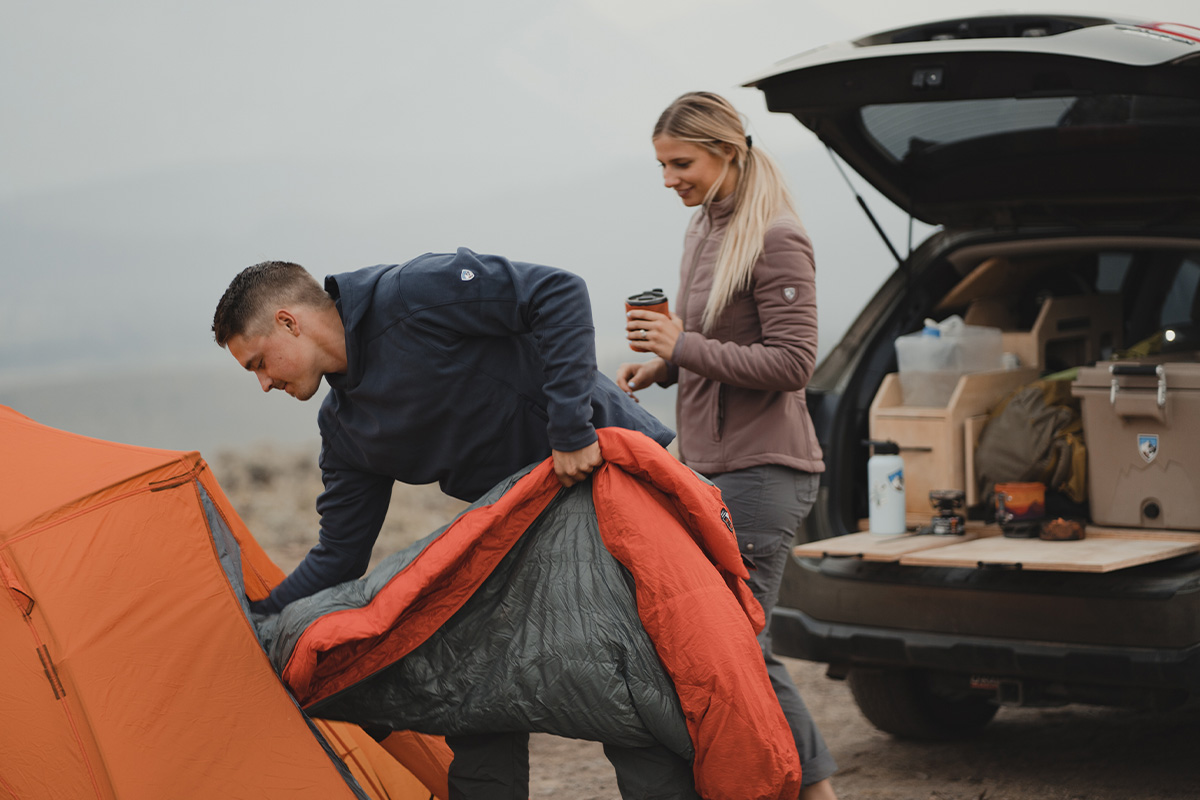
Overlanding Gear Essentials
There's nothing like the ultimate overland camping gear checklist for all overlanders. What you bring for each overland trip will depend on the environment, climate, and logistics. For this list, we focused on gear essentials that cut across various overland vacations.
Navigation Tools
Part of an enjoyable overland camping trip is being sure of where you are going. Smart overlanders know better than to rely solely on their vehicle's onboard navigation.
Combine good old Google Maps with a community-driven navigation/map app like Waze . Paper maps and a compass calibrated for your travel needs are another must-have duo.
A reliable and portable GPS device could also save your life. It's easy to get your hands on a quality device today, thanks to the ever-growing overlanding popularity. For a GPS unit designed with overlanding excursions in mind, we recommend the Garmin Tread XL- Overland Edition .
Communication Devices
Proper communication between rigs and groups is key, and if you’re traveling solo, being able to call for help is a crucial tool when overlanding. Similar to navigation tools, smart overlanders typically have more than one communication device before hitting the road:
- Cell phone booster kit - it amplifies weak cellular signals for enhanced connection quality in remote areas. WeBoost and Signal Boosters are reputable players in this niche.
- HAM and GMRS radios - these two allow vehicle-to-vehicle or driver-and-spotter communication when you are totally out of cell signal range.
- Satellite phone - ideal to have in your overlanding vehicle if you wish to stay in touch with your family when traversing isolated areas for days, weeks, or months.
- Personal locator beacons (PLBs) - satellite-synced devices that send personalized SOS signals and your exact location to rescue agents.
- Satellite messengers - a cheaper alternative to satellite phones, satellite messengers allow you to send messages and share your location with families and friends. An added advantage over personal locator beacons is being able to send detailed messages regarding your emergency.
Overlanding Recovery Gear
Overlanding comes with a greater risk of getting stuck. Having the right recovery gear will help you or other overlanders get out of different scenarios, whether on the sand, mud, snow or in a water crossing. The equipment you outfit with will depend on your vehicle and your routes. But you’ll learn what you should take with time.
Deflator Kit
A tire deflator makes it easy to air down your tires accurately for more tread grip. It’s important to air down your tires when driving on unpaved terrains. But doing this is particularly crucial when navigating through sand and loose gravel.
Portable Air Compressor
Portable air compressors are popular among off-road enthusiasts, including budget-conscious overlanders. These are compact, lightweight, and versatile units used to air tires, power air tools, and blow-up inflatables, such as air mattresses and watercraft.
A Recovery Shovel
A shovel is another must-have tool in your overlanding vehicle. It will come in handy in various vehicle recovery and general camping situations. On the road, a recovery shovel helps free the tires from mud and sand and clear snow on pavements. You’ll also need it when digging cat holes and fire pits and putting out campfires at the camping site.
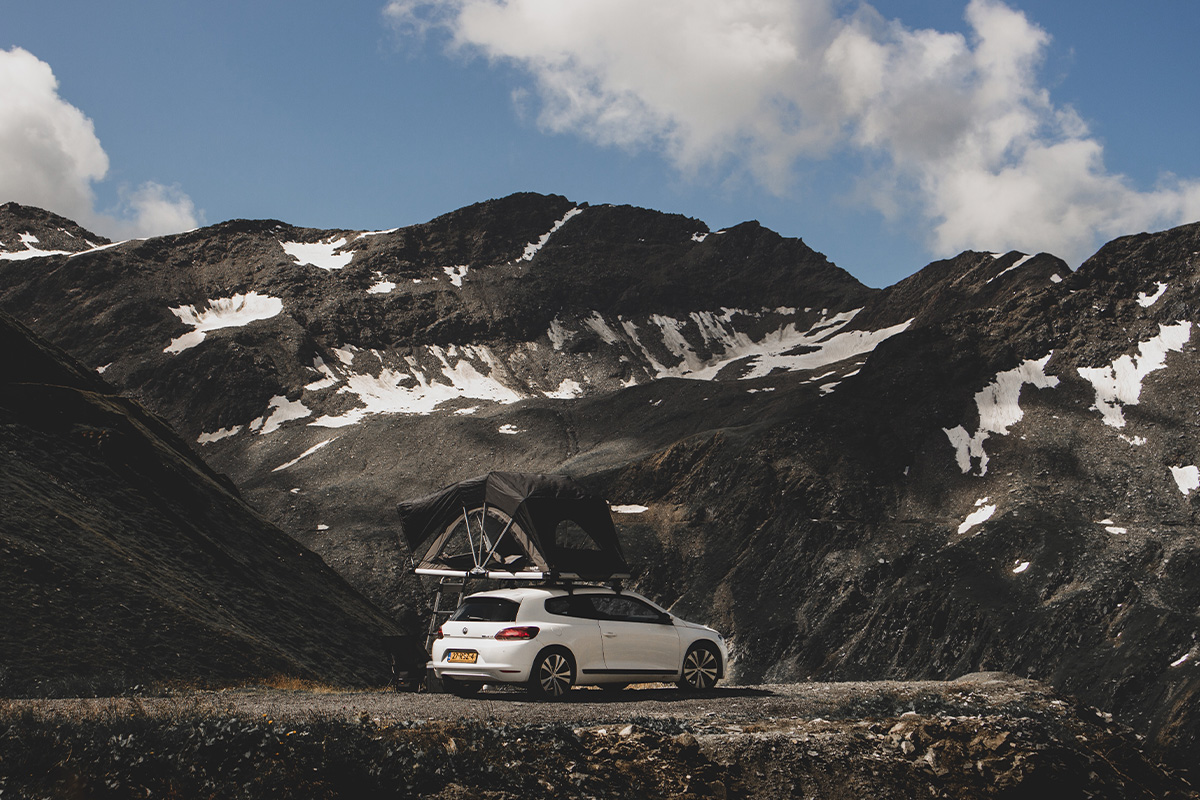
Traction Boards/Recovery Treads
Always have at least a pair of recovery boards when overlanding. It will help free your stuck four-wheel drive by adding traction (for better grip), flotation (to minimize sinkage), and clearance (to get over obstacles).
Fire Extinguisher and Fire Blanket
No overlanding rig is complete without a reliable fire extinguisher and a fire blanket in the first aid checklist. Class A, B, and C-rated fire extinguishers are the best because they can handle any type of fire on different parts of your vehicle.
Recovery Jack
Get a high-lift jack if you want a multipurpose unit that can be used for lifting, clamping, and winching (albeit slowly). Or consider an ARB jack if the convenience of one-finger lifting and lowering makes more sense to you.
Vehicle Winch
A vehicle winch is not a must. But you’ll be glad to have included it in your overlanding camping checklist in case you get stuck in mud in the middle of nowhere.
Other Overlanding Must-Haves and Accessories
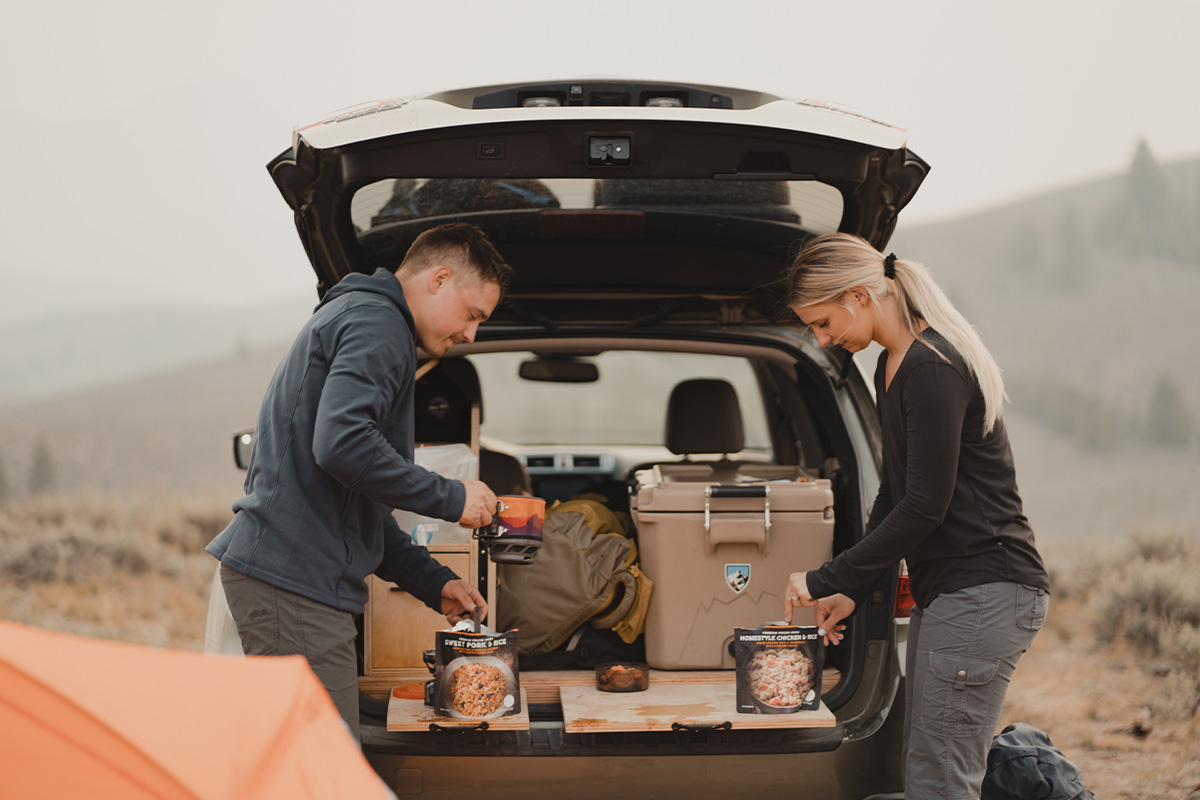
Food
Meals, Ready to Eat (or MREs), are popular among overlanders because they are ready to eat as soon as you add water. But you can also pack boxed milk, fresh fruits, and meat, so long as they are allowed across the borders you’ll be traversing. Ensure you have proper camping food storage for the food you plan to carry.
A good rule of thumb is to provide at least one gallon of water per person daily. It’s also wise to have a backup emergency supply (say five gallons) for extra safety.
Depending on the number of people and the duration of the trip, it’s a no-brainer that water weight will be an issue. Luckily, you can go around that with a reliable water filter and purification system. It keeps the water weight down by allowing you to resupply from lakes, rivers, wells, and potable water vendors, as well as getting you through emergencies.
Proper Clothing
Proper outdoor clothing is another essential component when planning for an overland trip. The type of clothing to pack will depend on the elements you’ll be traveling through. The idea, however, is to keep everything simple.
Durable and comfortable apparel that offers a superb fit and stylish appearance across all seasons, like the flannels in our men’s outdoor wear , will pay dividends. For your outdoor workout sessions, check out our collection of men’s and women’s hiking clothing . We also recommend packing proper rain gear even if the weather forecast suggests otherwise.
It’s common to go for days or weeks before seeing another person, a town, or a gas station when overlanding. That said, it’s imperative to bring at least 5 gallons of extra gas. This could be the difference between getting stranded in the wilderness and driving to the next fuel source.
Overlanding Vehicles
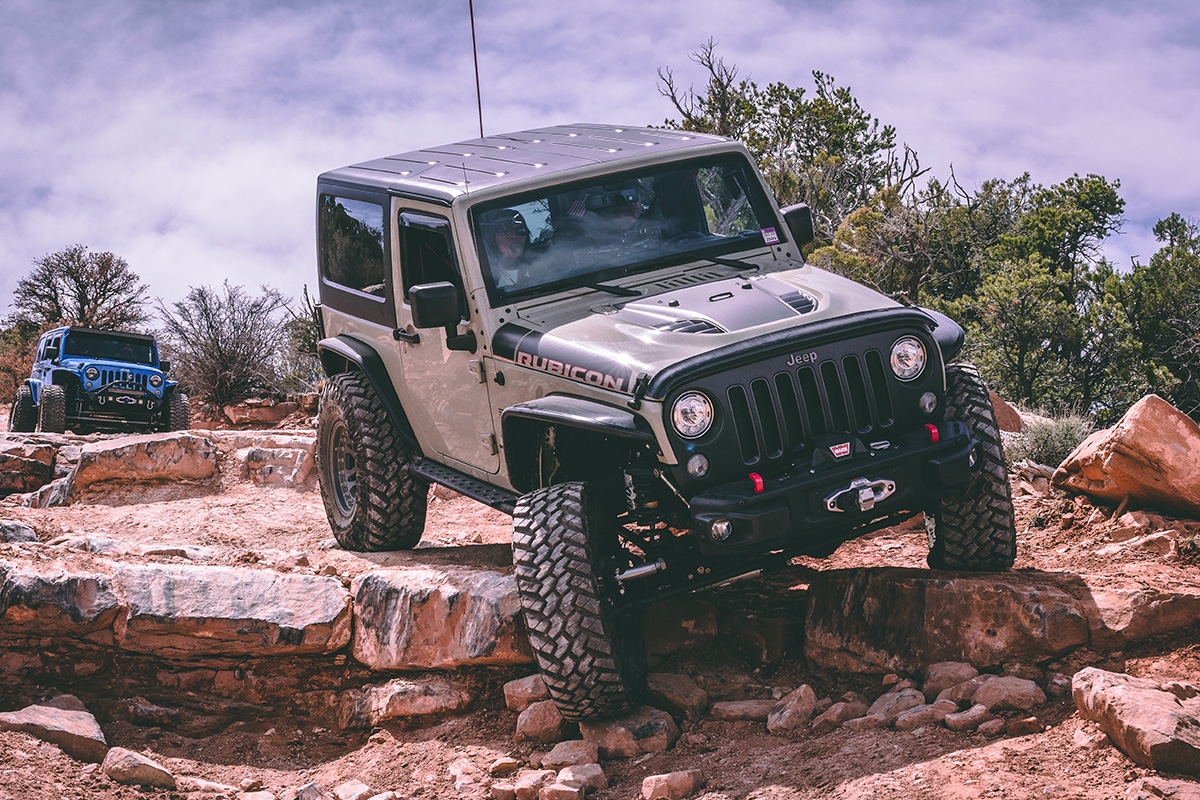
The best overlanding vehicle is the one that will get you to your destination and back. Typically, any 4x4 vehicle can be used for overlanding so long as it can handle rocky, muddy, snowy, and cross-axle situations, such as steep side slopes and severe descents.
Other key factors to consider when choosing or modifying your vehicle for overland travel are durability, fuel economy, storage space, comfort, and ease of repair.
These are some of the most popular overlanding vehicles today:
Third-Gen Toyota Tundra
The third generation of the Toyota Tundra tops our list because it shares the same DNA with the most reliable overlanding vehicle of all time- the Land Cruiser. The 3rd-gen Tundra was released in 2022 to resolve the efficiency issues that rocked the second generation.
The Tundra now boasts a 3.5-liter twin-turbo V6 engine backed by a 10-speed automatic transmission. The engine churns out 389 horsepower and 479 torques, which makes it great for handling rough terrain and towing heavy roads during off-road use.
The high-ground clearance of around 9.4” opens a world of possibilities in terms of where you can fit into or go through. Plus, the Tundra has impressive aftermarket support, offering you various ways to outfit your rig.
Second-Gen Chevrolet Colorado Z71
The Chevy Colorado Z71 is a tried and true overlanding vehicle that we bet won’t let you down. This will be your go-to model, mainly if you are after a mid-size diesel pickup truck. It comes with a 2.8L Duramax engine with a fuel economy of 20/29 MPG for city and highway driving.
Another reason for its popularity is its four-door and full-size bed in a mid-size truck. This design means a higher load capacity for your overland gear essentials. It also has adequate traction and hill descent control, making navigating technical terrain easy. This might also be a good pick if you're looking to go pickup truck camping .
JL Jeep Wrangler
The JL Jeep Wrangler has some remarkable qualities that make it a common sight in most overland destinations. It may be pricier than its older sibling- the JK Wrangler. But without a doubt, the new model has a lot to go for in terms of refinement, quality, and technology.
The first thing you notice about the JL Jeep series is that it has a more appealing dashboard compared to the plasticky layout of the JK. It also provides more interior comfort and larger wheel wells for bigger tires.
Tips on How to Start Overlanding and Practice it Safely
When it comes to how to start overlanding, there are a few tips and tricks that guarantee memorable vacations every time.
- Don’t be intimidated by Instagram, Facebook, and X gatekeepers who dictate what overlanding is and what it’s not. Steer away from people who say you’re not an overlander because you are not crossing international borders or sleeping in a rooftop tent. So long as you have a reliable vehicle you can depend on to explore the great outdoors and carry your sleeping quarters, get out and explore.
- Start small. Overlanding for beginners seems like an expensive way of life. It could be, depending on your travel style, how much you want to modify your rig, and how far you want to explore. But it doesn’t have to be expensive for everyone. Overland basics are a reliable vehicle, shelter (rooftop tent, traditional tent, hammock, etc.), a sleeping bag, food, and water.
- Match your car’s capabilities with the terrain you plan to traverse. A two-wheel vehicle will suffice if you’ll be traveling on well-maintained park roads. But getting a 4x4 with high clearance for backcountry overlanding is a good idea.
- Regardless of your experience level and your rig’s capability, always be ready for self-rescue.
Tips on Where to Go Overlanding
When you become an overlander, the world becomes your playground. But remember, you really don’t need to cross international boundaries to enjoy the freedom of overlanding. Here are the most iconic routes for overlanding in the US:
- Smokey Mountain Road Grand Staircase National Monument (78 miles, 1-3 days)
- Valley of the Gods Road, UT (17 miles, one day)
- Mojave Road, CA (138 miles, 2-5 days)
- Trans-Wisconsin Adventure Trail, WI-IL border (600 miles, 2-3 days)
- New Mexico Backcountry Discovery Route, NM (1178 miles, 5-7 days)
- California Crest Trail (2650 miles)
Final Thoughts
There’s something cool about venturing beyond your local park, experiencing new cultures, overcoming obstacles, and discovering remote campsites not many others have been into.
Importantly, you don’t need to build a sophisticated rig or spend so much on high-end overlanding gear if your budget doesn’t allow it. If your vehicle can comfortably handle the terrains you’ll be traveling on, consider the above overlanding tips, get out there and enjoy.
Featured image by: Thomas Tucker.
What is the price of overlanding?
Overlanding costs include the cost of the vehicle, modification cost, gas money, repairs, food, and parking fees. That said, overlanding doesn’t have to be expensive.
Who goes overlanding?
Overlanding is for adventure-seeking purists who enjoy discovering remote areas while embracing uncertainty and taking risks.
Is 4WD necessary for overlanding?
You can overland with a 2WD vehicle as long as it’s outfitted for self-recovery. Actually, another growing trend is adventurers exploring continents on motorcycles and bicycles.
Is a manual better for overlanding?
This comes down to personal preference. But there are several reasons most experienced overlanders choose one over the other. Stick/manual transmissions are simpler to repair wherever you are in the world. On the other hand, automatic transmissions are less likely to stall when climbing over or navigating obstacles.
What is the longest overland route?
The Pan-American Highway, which spans over 30,000 miles and travels through nine countries, is the longest overland route in the world.

Tom Harrison is an intrepid explorer and fervent nature lover. Through his clean writing style, he invites readers to join him on an exhilarating journey into the wilderness.
DON'T MISS NEW STORIES AND STYLES
Get all the news right in your mail

KÜHL’s Guide to Pine Needle Tea - Benefits And Nutrition
In the vast world of herbal teas, there's a unique, forest-derived variety that might not be on your radar yet – Pine Needle…
SEASONAL FEATURETTE

Road Less Traveled: Arizona Storm Chasing
Have you ever wondered what inspires and attracts one to chase monsoon storms?
- View All >
- Adventure >
- Travel >
- Food + Drink >
- Social >
- DIY / Craft >
- Wellness >
2-FOR-1 GA TICKETS WITH OUTSIDE+
Don’t miss Thundercat, Fleet Foxes, and more at the Outside Festival.
GET TICKETS
BEST WEEK EVER
Try out unlimited access with 7 days of Outside+ for free.
Start Your Free Trial

15 Overland Destinations to Add to Your Bucket List
Plan the trip of a lifetime or just the weekend with these iconic routes
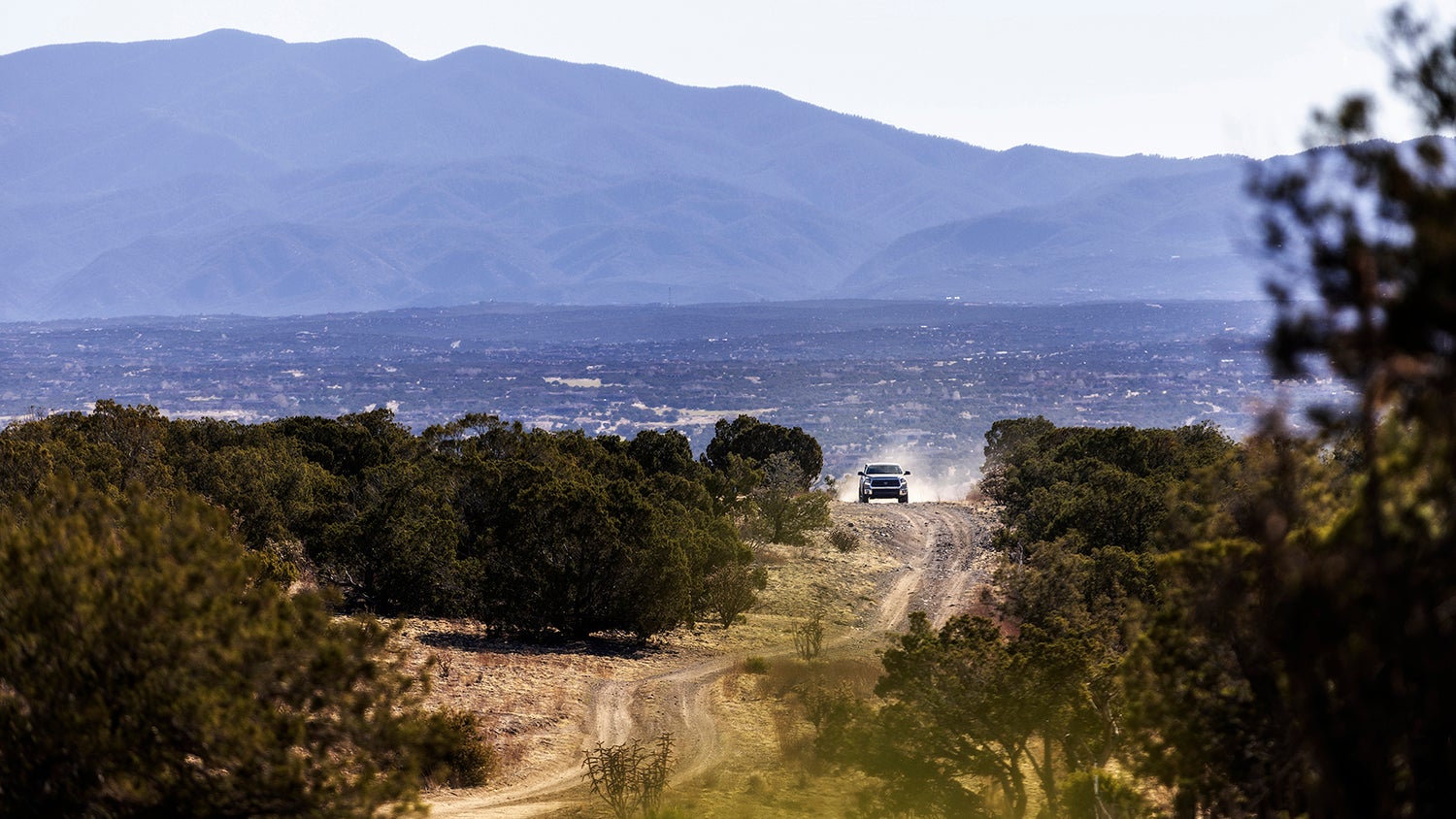
If you know where to look, the world is still a truly wild place, filled with remote back roads and empty campsites. And one of the best ways to explore them is by overlanding, a style of self-reliant travel that entails using an off-road vehicle or a van to cover a long distance, typically in a remote area. That’s why we teamed up with Toyo Tires to create a guide to everything you need to know about overlanding .
Where to start? We rounded up some of our favorites, from one-day excursions to week-long adventures. Just remember to do your homework before you hit the trail. Research the routes online, download an app like Gaia GPS so you can map out your route, and, if possible, talk to people who’ve already driven these trails. Reach out to overlanding groups in the area, direct message people on social media, or call the rangers in charge of these roads and gather as much on-the-ground information as you can before heading out.
New Mexico Backcountry Discovery Route, NM
Length: 1178 Miles Time Needed: 5-7 days
This trail traverses the entire state of New Mexico from Dell City, TX to Antonito, CO. You’ll drive through many different landscapes , with incredible vistas but zero crowds. There’s plenty of rough and dusty terrain, but drivers without any overlanding experience will do just fine and you can drive the entire route in a regular four-wheel-drive vehicle or van.
Medano Pass Road, Great Sand Dunes National Park, CO
Length: 22 miles Time Needed: 2 Days
Colorado’s Great Sand Dunes National Park contains North America’s tallest sand dunes, and a highly underrated overland route—The Medano Pass primitive road, which goes through several deep water crossings and sand pits as it winds its way up from the dunes to 10,000 foot Medano Pass. This is not a beginner-friendly road so make sure you have some off-road driving experience before you set out.
The Alpine Loop, Lake City, CO
Length: 63 miles Time Needed: 1-2 days
The Alpine Loop is one of the most scenic and iconic overland routes in the world. Open from June-September, the Alpine Loop can only be driven for a short period of time during the Summer when it’s free of snow. It’s chocked full of high mountain passes and incredible views but also has terrifyingly-steep one-lane switchbacks and some technical terrain so you’ll need a high-clearance four-wheel-drive and some off-road experience.

Smokey Mountain Road Grand Staircase National Monument, AZ and UT
Length: 78 Miles Time Needed: 1-3 Days
The Smokey Mountain Road is a 78 mile overland route that cuts right through one of the most remote areas in the lower 48, between Page, AZ and Escalante, UT. The road is rough but not technical and a stock 4×4 with reliable all-terrain tires like the Toyo Open Country A/T III is capable of driving the route. The sheer remoteness of the area can be a little intimidating but that also means you’ll never have to worry about finding a beautiful campsite. The views of slot canyon country also make it unforgettable.
Valley of the Gods Road, Mexican Hat, UT
Length: 17 Miles Time Needed: 1-2 Days
Valley of the Gods Road near Mexican Hat, Utah, is known for its dramatic red-rock towers and wide-open spaces. It’s one of the best beginner overland routes in the country because you get to access incredible vistas and hikes and are never very far from a paved road and gas station. There are also plenty of incredible but easy-to-access backcountry campsites.
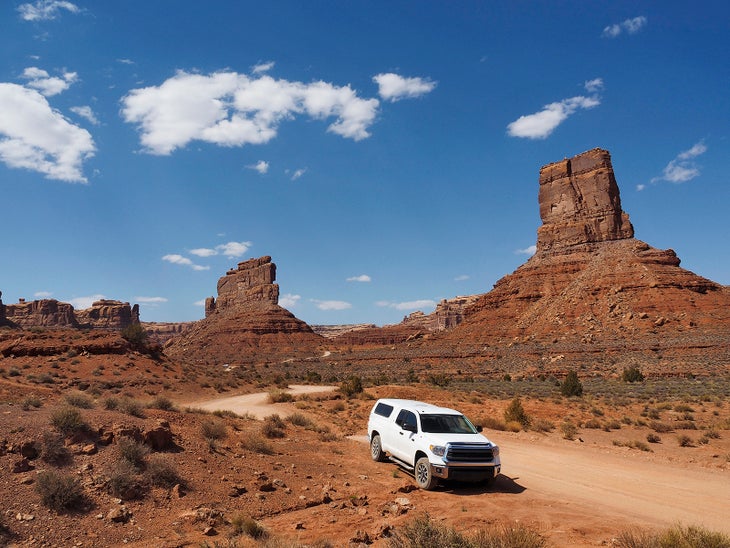
Mojave Road, CA
Length: 138 Miles Time Needed: 2-5 Days
The classic Mojave Road bisects Mojave National Preserve in California’s southeastern desert. First used by Native Americans and later Westward-bound settlers as a trade route, this area is full of history and has remained largely untouched. The road is remote but not overly technical so overlanders with a basic off-road driving experience will be fine. Heads up: the summer and winter temperatures can be extreme, so it’s recommended you visit in the spring or fall.
Cape Lookout National Seashore, NC
Length: 20+ Miles Time Needed: 1-2 days
A ferry ride from the small mainland town of Davis to South Core Banks , the middle of three barrier islands that make up Cape Lookout National Seashore, gets you to 21 miles of undeveloped, drivable beach ripe for fishing, swimming, and surfing. Tip: make sure you know how to air down because tires with a lower PSI help with traction in the sand. And, remember, you’ll also need an onboard or portable air compressor so you can air back up.
White Rim Trail, Canyonlands National Park, UT
Length: 110 Miles Time Needed: 2-4 Days
This classic route explores Canyonlands National Park’s stunning Island in the Sky district, a Mars-scape hemmed on three sides by river—to the east, the mighty Colorado; to the west, the snaking Green; to the south, their confluence. The White Rim trail is one of the more crowded overlanding routes in the United States, but the dramatic views easily make up for the extra people.
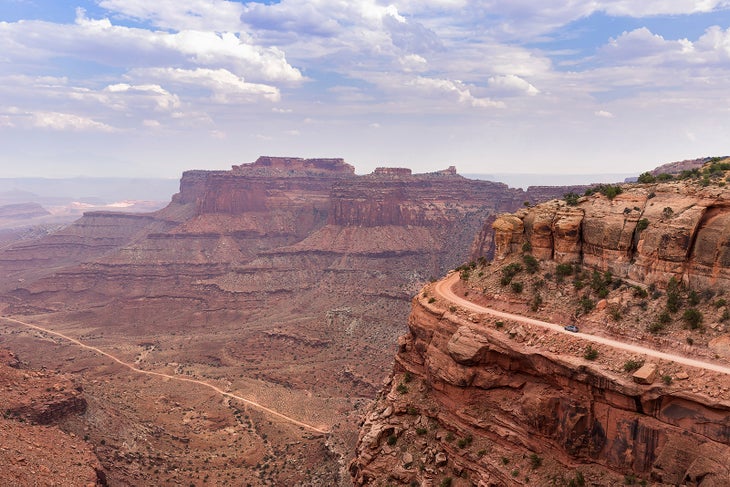
Naranja Road, Baja California, Mexico
Length: 55 Miles Time Needed: 1-3 Days
Also used by bikepackers, Naranja Road climbs through cardón cactus desert and over two forested passes in the Sierra de la Laguna mountains before rolling down toward the Pacific Ocean. Road conditions are notoriously unpredictable so make sure you have some off-road driving experience under your belt, just in case the road is in poor shape.
Rubicon Trail, Georgetown, CA
Length: 22 Miles Time Needed: 1-2 Days
It’s a gnarly, beautiful 22-mile route through the rugged Sierra Nevada that should be on every overlander’s bucket list. The demanding route takes a highly experienced driver and a highly modified, well-built vehicle to complete—the trail’s mix of granite slabs, soft dirt, sharp rocks, and large boulders require precise maneuvering and your standard four-wheel-drive vehicle is not enough.
Dempster Highway, Northwest Territories and Yukon, Canada
Length: 456 Miles Time Needed: 5+ days
The Dempster Highway , which runs between central Yukon and the far northern Northwest Territories, is mainly nontechnical gravel and dirt, but it takes some serious logistical and route planning to pull it off, given the long distances between fuel stops. It’s the gateway to an otherwise untouched swath of mountainous tundra.
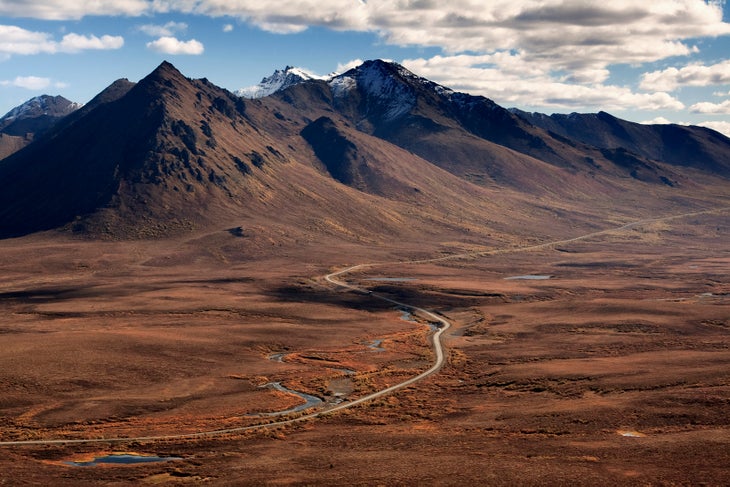
High Water Mark Trail, Ozark National Forest, AR
Length: 140 Miles Time Needed: 2-3 Days
Arkansas’ Ozark mountains have long been an underrated adventure destination, and taking this trail lets overlanders explore some of the most scenic areas in the state. There are over a dozen water crossings along the trail, and travelers will get a firsthand look at the milky blue streams, bluffs, and caves that make this area so special. Tip: you might also want to pack a chainsaw just in case you need to clear any downed trees.
Guadalupe Mountains Adventure Trail, Guadalupe Mountains National Park, TX
Length: 296 Miles Time Needed: 4-6 Days
This trail in far western Texas can be done in a stock 4×4, and its remoteness means you’ll have incredible views all to yourself. You can spend a week exploring the Guadalupe Mountains’ canyons, ghost towns, archeological sites and nearby attractions like Carlsbad Caverns. Sprinter vans and Subarus can cover most of the route but drivers with those vehicles should check here to avoid some of the rougher spots.
Sedona Backcountry Trail, Sedona, AZ
Length: 250 Miles Time Needed: 4-7 Days
This trail is doable for any stock 4×4, and gives you a taste of everything the Sedona area has to offer without the crazy crowds some of the more-famous trails are known for. Make sure you bring hiking boots and a mountain bike so you can explore off the road as well.
Whipsaw Trail, British Columbia, Canada
Length: 63 miles Time Needed: 2-3 days
One of the most famous off-road trails in Canada, the Whipsaw requires a high-clearance 4×4 with at least a two-inch lift as well as a driver who has previous off-road experience—beginners be wary. Adventurers are rewarded with epic scenery and a challenging trail that will put your rig to the test. Make sure you’re running a more aggressive all-terrain tire like one of the models from Toyo’s Open Country line to ensure you can clear the tricker spots.
Toyo Tires® has delivered innovation, quality, and performance for 75 years. Well-known for the Open Country® line of light truck and SUV tires, the company offers a tire for nearly every vehicle including crossovers, sports cars, and luxury sedans. Many of the tires are built in the United States at their state-of-the-art factory in Georgia. Find the right tire and an authorized dealer at toyotires.com .
Popular on Outside Online

Enjoy coverage of racing, history, food, culture, travel, and tech with access to unlimited digital content from Outside Network's iconic brands.
Healthy Living
- Clean Eating
- Vegetarian Times
- Yoga Journal
- Fly Fishing Film Tour
- National Park Trips
- Warren Miller
- Fastest Known Time
- Trail Runner
- Women's Running
- Bicycle Retailer & Industry News
- FinisherPix
- Outside Events Cycling Series
- Outside Shop
© 2024 Outside Interactive, Inc

- ROOF TOP TENTS
- ANNEX ROOMS
- ACCESSORIES
- TRUCK BED RACKS
Your cart is empty
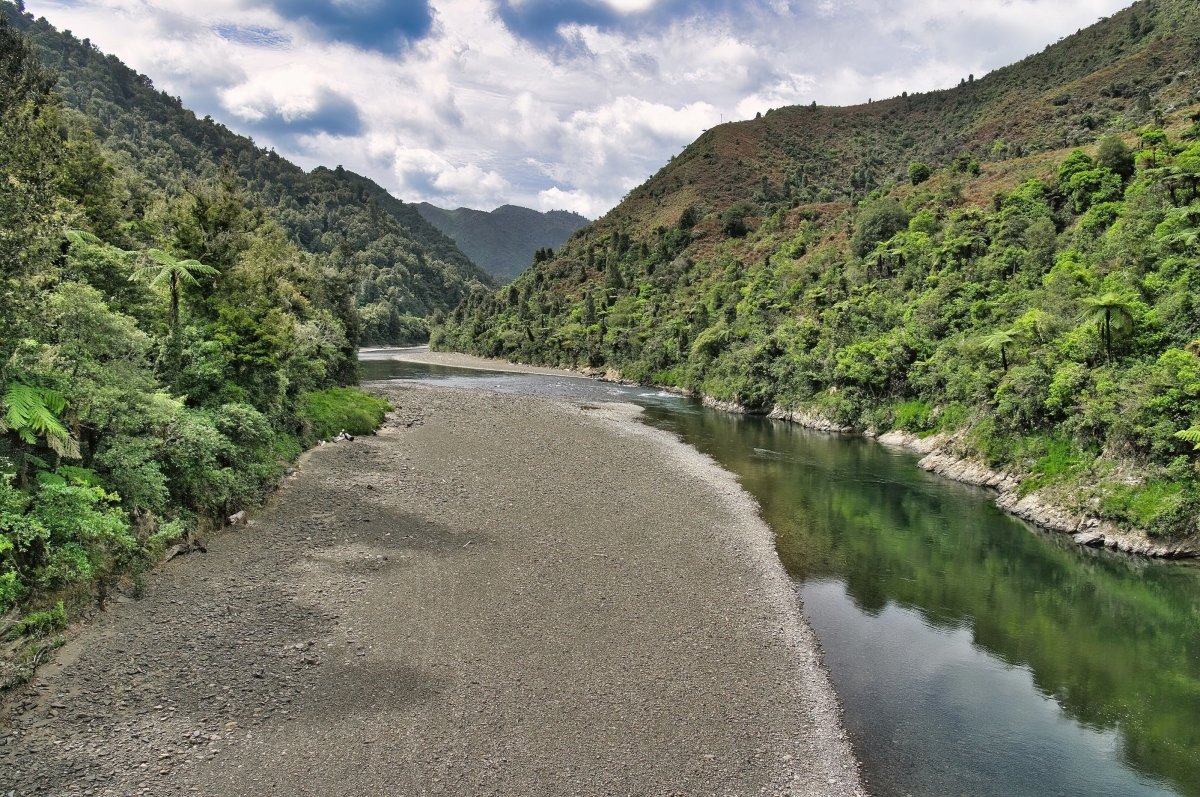
The Best Overland Routes & Trails On The East Coast (USA)
- Destinations
Overlanding has become a popular lifestyle in many parts of the United States of America, and the East Coast is not left out. Although it shares proximity with the Atlantic Ocean, the East Coast of the United States boasts several exciting overlanding routes for adventurous souls planning an overland trip.
Although overlanding routes on the East Coast might not be easy to find, like in the North, these places do exist. Knowing what trails to travel on and where these trails are will play a significant role in having a successful and exciting overland trip. To help, we have provided some of the best overland routes and trips to check out on your next adventure.

Best Overland Routes And Trails On The East Coast
The East Coast Of The USA is the Atlantic coastline of the United States of America. Also known as the Eastern Seaboard or Atlantic Seaboard, the East Coast includes the farthest parts of the country that touches the Atlantic Ocean up to Canada.
The East Coast is made up of fourteen states which include:
- Connecticut
- Massachusetts
- New Hampshire
- North Carolina
- Rhode Island
- South Carolina
West Virginia, Vermont, and Pennsylvania are also considered members of the East Coast, even if they do not touch the coast of the Atlantic Ocean.
The East Coast is a beautiful collage of different cultures and exciting landforms like their famous Appalachian mountains. Although the states on the East Coast are smaller and more compact than the states in other parts of the United States of America, there are still many interesting things to do and places to visit.
Each state on the East Coast boasts unique experiences that will leave any visitor in awe. It has everything from estuaries to small lakes, wetlands, bogs, islands, and even lush coastal habitats. Thanks to these unique and different geological features, overlanders have interesting and scenic places to visit and make memories.
From mountain routes to thick forest trails, here are some of the best overlanding trails fit for different overland experience levels.
1. Pachaug State Forest
Pachaug State Forest is a picture of nature at its finest. An area with everything from the famous Green Fall Pond to the gorgeous forest and the rocky hills it cradles, Pachaug is a dream come true for any overland enthusiast.
Pachaug State Forest is located in Connecticut, Voluntown. It is the largest State Forest in the state , spanning over 26,477 acres.
Although Pachaug State Forest is described as being located in Voluntown, it passes through six towns which are Voluntown, Sterling, Plainfield, Griswold, North Stonington, and Preston.
The Pachaug State Forest is divided into the Chapman Area and the Green Falls Area. Both areas have interesting trails waiting to be explored.
Pachaug State Forest has everything from four well-maintained hiking trails at different parts of the State Forest to a wheel-chair-accessible Rhododendron Sanctuary Trail and other unnamed routes of gravel and dirt roads that are accessible by vehicles.
Here, you will enjoy more than 58 miles of off-road trails in the Enduro trail used by motorcyclists, snowmobilers, and even hikers. These trails are perfect if you plan to go overlanding with your dirt bike or motorcycle.
2. Cape Cod National Seashore
If you have always wanted to go overlanding on a picturesque sandy beach area, the Cape Cod National Seashore is perfect for a solo overlanding trip or one planned with friends and family.
Cape Cod National Seashore spans almost 45,000 acres of land along the peninsula, extending to the coast of Massachusetts. It comprises six swimming beaches with interesting historical sights and towering lighthouses that are the cherry on top of a magical view.
Although no words can describe how beautiful Cape Cod National Seashore is, ‘exquisite’ is a great way to start.
Because the Cape Cod National Seashore sits atop the peninsula and overlooks the oceans, you will enjoy an easy view of the dazzling Ocean at all times. The Cape also offers easy access to salt marshes, uplands, ponds, and interesting rock formations like the Doane Rock (which also happens to be the largest glacial boulder on the Cape, and possibly, in the entire Southeastern New England.
Vehicles are permitted in the Cape from Race Point Light to Long Nook Beach (south of Coast Guard Beach) most of the year. So, if a drive along the pristine sandy beach sounds like something you might be interested in, along with exciting scenery, then you should add Cape Cod National Seashore to your list of places to go on an overland trip.
3. Pulaski State Park
Pulaski State Park is located near the village of Chepachet in Glocester, Rhode Island. It is a 100-acre park within the 4000-acre George Washington Management Area.
Established in 1939, the Pulaski State Park is a ‘day use’ facility that offers guests the opportunity to enjoy an unforgettable outdoor experience through interesting outdoor activities.
There are a lot of activities explorers can explore in Pulaski State Park. From fishing to having picnics or even an overland trip to the area, you can never run out of exciting things to do in this park. More importantly, Pulaski State Park has some attractive and scenic trails that serve as quick (although you will definitely wish they last longer) and scenic routes for an adventurous overland trip.
Pulaski State Park is well-maintained, so you will have an easy ride. There are lots of activities to indulge in, so you should remember to enjoy the moment you find yourself in this State Park.
4. Assateague Island National Seashore
Assateague Island National Seashore is a protected area off the coast of Maryland and Virginia. It sits on a long barrier island and is extremely popular not only for the beach but also for its fantastic trails and scenic views of dunes and pine forests.
Assateague Island National Seashore is described as the largest natural barrier island ecosystem in the Middle Atlantic states region. Easily accessed within a three-hour drive from Richmond, Washington (are you in Washington? Check out our list of twenty best dispersed camping spots in Washington , The Evergreen State!), Baltimore, Philadelphia, the National Seashore offers a breathtakingly dreamy experience that feels almost surreal.
Although there are many rules put in place to protect the National Seashore, the Assateague Island National Seashore features an Over-Sand Vehicle Zone (OSV zone) for people to explore the beaches. However, to gain access, you will need to purchase a permit with fees that range from $110 to $200.
Although this is quite expensive, it is worth the experience you will enjoy on the untouched and unspoiled natural landscape.
We recommend going fully prepared with a vehicle recovery kit, as vehicle breakdowns are not uncommon. Drivers are told to explore the area without the necessary preparation at their own risk. In fact, the National Park Service staff cannot winch or pull the vehicles out or recommend a towing company.
5. Allegheny and Shenandoah Overland Trail
Although it might not be popular among overlanders, the Allegheny and Shenandoah Overland Trail no doubt deserves a shout-out as one of the best overland trails on the East Coast. This 700-mile loop cuts through Virginia, West Virginia, and Maryland states, offering a wide range of breathtaking scenery as you go.
When you go overlanding on the Allegheny and Shenandoah Overland Trail, you pass through fascinating places like the George Washington National Forest, Flagpole Knob, Reddish Knob, Lake Moomaw, and Green Ridge State Forest. While this is exciting, it also means you deal with irregular terrain ranging from rocky paths to muddy roads, dirt roads, and even paved roads in some areas.
Because the trail is moderately difficult, we recommend exploring it with a capable 4x4 vehicle with high clearance.
Because of the distance, you can expect to explore the Allegheny and Shenandoah Overland Trail for three days and even up to a week, depending on how many hours you spend exploring the trail daily. Thankfully, there are free dispersed camping areas that you can make use of.
Regardless, we guarantee that as long as you go prepared, you will have fun exploring the Allegheny and Shenandoah Overland Trail.

6. King Knob Motorsports Park
King Knob Motorsports Park is located in Philippi, which is just an hour outside of Morgantown in West Virginia. This park is a must-visit for every adventurous overlander and should be top of your list if you find yourself in West Virginia.
King Knob Motorsports Park measures about 1,300 acres and is popularly used by off-raiders looking to explore the area. However, the park is not always open, so it is essential to check before setting out for your trip. King Knob Motorsports Park is often available in the Summer and select weekends for the rest of the year.
The park has 200 miles of trails with varying terrains. From rocky paths to steep hill inclines and mud pits, the King Knob Motorsports park is perfect for overlanders with varying experience levels from amateur to expert.
King Knob Motorsports Park also has a few campsites along the trails that you can use as rest stops. However, you will also need to call ahead to confirm their availability.
7. Beartown State Forest
Beartown State Forest is located in Monterey, Massachusetts. It is a publicly owned forest that measures more than 12,000 acres which are spread across Monterey, Great Barrington, Lee, and Tyringham.
Beartown State Forest is a four-season recreational, natural site that is also the third-largest state forest in Massachusetts. It is home to diverse flora and fauna, offering the ultimate outdoor experience to campers, off-roaders, and overlanders.
The forest is home to several fun activities. It features trails for horseback riding, mountain biking, snowmobiling, and vehicle use. Although off-roaders mainly use the trails, they are open to overlanders as well.
Beartown State Forest is open from sunrise to sunset. However, you will need to buy a permit to gain entrance. When you do, you get to enjoy 16.4 miles of challenging rocky trails, mud paths, and hilly roads.
We recommend going overlanding in Beartown State Forest with a capable 4x4 vehicle.
8. Bald Eagle State Forest
Bald Eagle Forest is a State Park located in Pennsylvania. It is named for the famous Native American Chief, Bald Eagle, and includes 194,602 acres spread across Snyder County, Union County, Centre County, Mifflin County, and Clinton County.
This State Forest is located in the ridge and valley section of Pennsylvania state. It features mountain streams, high and sharp mountainous ridges, and the lush green growth of the forest.
Along with exciting trails that can be explored with a high-clearance vehicle, Bald Eagle State Forest features dispersed campsites, hiking trails, and swimming and picnic areas that contribute to an unforgettable experience.
9. Hunter Mountain
Located in New York, Hunter Mountain is a ski resort in Greene County. It is three hours northwest of NYC. Although the Hunter Mountain trail is inarguably one of the most beautiful trails any overlander will set their eyes on, it is also one of the trickiest routes.
If you haven't guessed, the Hunter Mountain trail is a high mountain pass with an elevation of about 4000 feet. It gets crowds, mostly tourists looking to enjoy several activities such as skiing, camping, and hiking. However, it is also primarily sought-after by overlanders.
Hunter Mountain trails are pretty rugged. We recommend using a capable 4x4 vehicle for this trip.
10. Green Mountain National Forest
Green Mountain National Forest is located in Vermont. It is one of two Vermont's and New York's only public, federally managed national forests ( the second being Finger Lakes National Forest ).
Green Mountain National Forest might be known for its breathtaking panoramic view, but it is equally famous for its amazing trails. It is a four-season adventure fight that offers a wide range of flora and fauna to tourists’ delights.
Because the Green Mountain National Forest seems to change every season, you will be treated to a unique experience when you drive through its trails. From Long Trail to Highway 100, we guarantee you will have a swell time exploring Green Mountain National Forest’s numerous trails.
With more than 400,000 acres. Green Mountain National Forest is undoubtedly any overlander’s dream.
Are You Ready To Go Overlanding On The East Coast?
The East Coast might be made up of compact states, but we guarantee there is no shortage of places you can explore with your trusty overland vehicle. From Pachaug State Forest to Green Mountain National Forest, the East Coast is a treasure chest of excellent trails to create overlanding memories you won't forget.
So, what are you waiting for? Pick a trail off our list and go have an overlanding experience you won’t regret. As a bonus, we have created a list of essential overland camping gear to help you make the most of your overlanding trip!
Continue reading
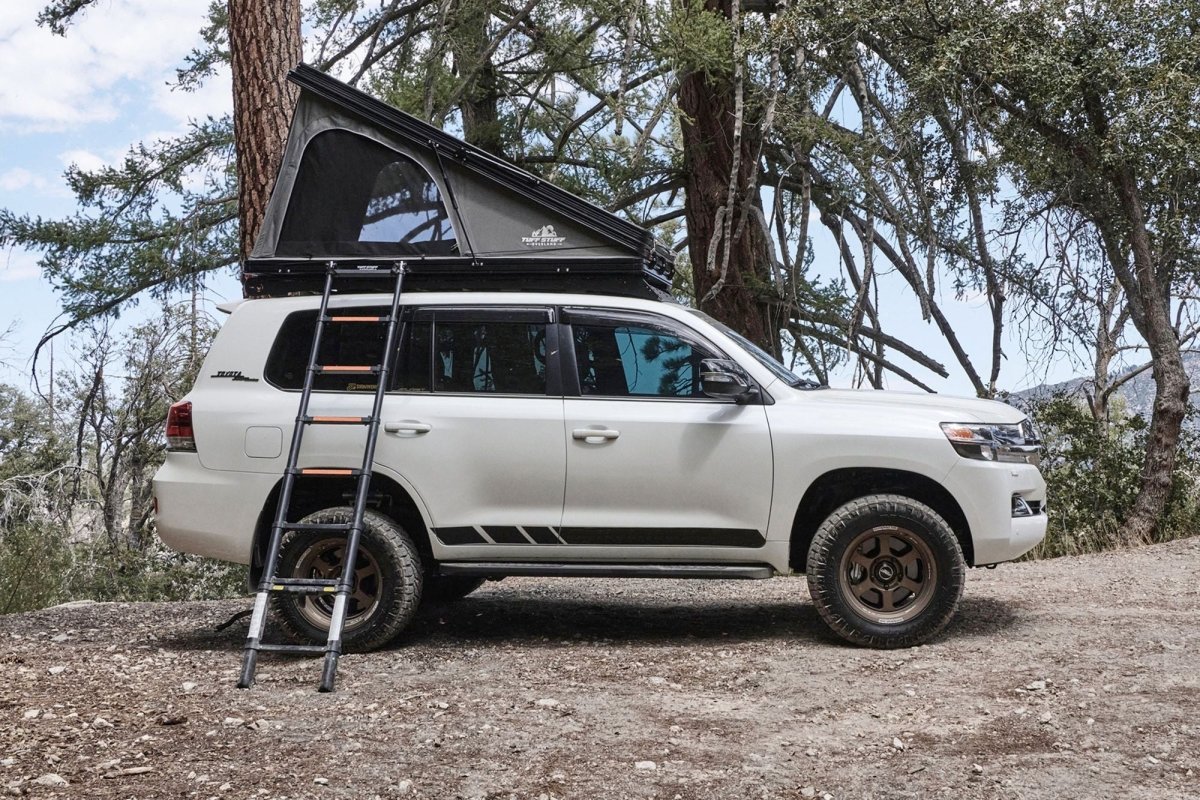
Rooftop Tent Frequently Asked Questions (Answered)

The Best Overland Routes And Trails In The Midwest (USA)
TALK TO AN EXPERT
Monday - Friday - 9am-5pm 1-866-220-0171
Free shipping
FREE SHIPPING on $50 or more
Click on the TSO icon in the lower right of your screen, select the correct form under Quick Links, or call us!

Most Famous Overlanding Routes
The world is your oyster when it comes to where to plan your next overland trip. If you’re wondering what overlanding is and where can you go, here are some of the best examples but the route ideas are endless:
Classic and Modern Routes Used by Overlanders: Overland Trips
The pan american highway.
Driving on the Pan American Highway that starts in Alaska all the way to Argentina is probably one of the most popular overland routes in the world. The best part of this overland route is that it is quite achievable for an ordinary person.
We are doing this overland trip right now and it may be one of the biggest adventures that we do in our lifetime . There are a number of people who have already done it, who gained immense knowledge on how to travel overland and how to tackle the number of issues one definitely comes across during a 40-thousand-mile trip. You can check out overlanding legends Ashley and Richard’s website, DeskToGlory , to get inspired.
The Rubicon Trail, California
The Rubicon Trail is a classic overlanding route that is located in California’s Sierra Nevada region. The route features a challenging mix of paved roads and dirt trails that take travelers past some of the most scenic areas in California.
Different trails along the route lead to popular destinations such as Lake Tahoe, El Dorado National Forest, Loon Lake, Buck Island Lake, and the campsites that surround Rubicon Springs.
The terrain is rife with obstacles such as Walker Hill, Thousand Dollar Hill, Silby Rock, and Cadillac Hill, and the off-roading opportunities are so authentic that car manufacturers test out their 4×4 vehicles on parts of the route.
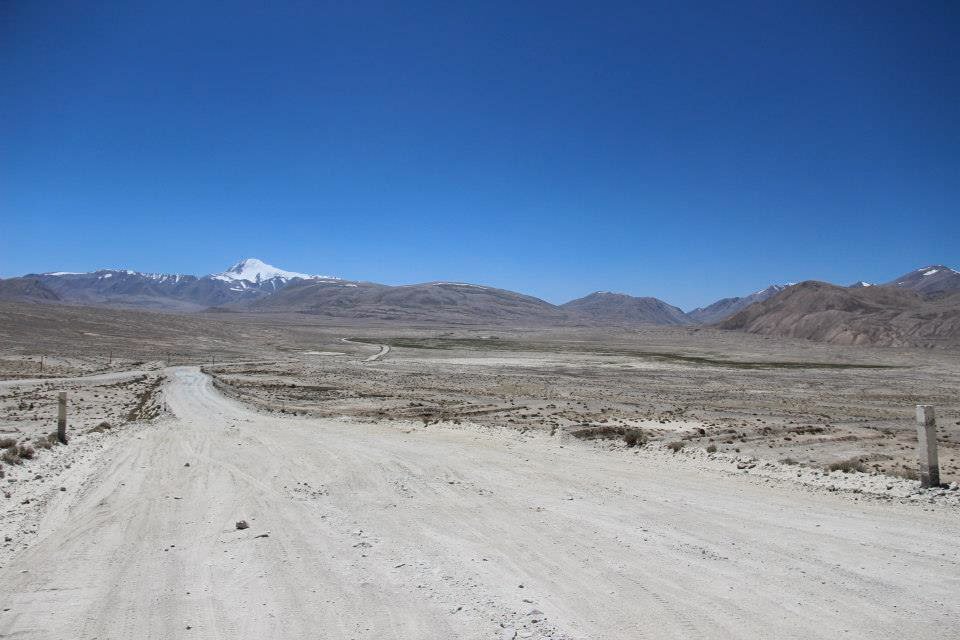
Pamir Highway
The Silk Road
The Silk Road is a famous road from medieval times that spans the Eurasian continent.
You can now go on an overland tour of this ancient trade route that goes all the way from China up to Paris or Rome, or in fact, any parts of Europe. You can traverse the entire path or only on sections of it.
Connecting to the Silk Road, the great Karakoram Highway (known as KKH among overlanders) crosses from Pakistan to China and it is one of the most spectacular roads in the world.
You definitely feel far away from home while traveling the 800 miles of this mostly paved road that took 20 years to construct.
Another route often on the bucket list of overlanders is the Pamir Highway . This 1000-year-old route is a spectacular and challenging part of the old Silk Road. Going through the 15,270 ft high Ak-Baital Pass in Tajikistan is demanding, to say the least.
Australia is a vast country, with endless opportunities for overlanding. There is no shortage of wild marvels along the coast or, in fact, inland. One example would be the Canning Stock Route, which is a 1,150 miles long, challenging four-wheel drive trek typically taking two to three weeks to complete.
Australia has got so much to offer in self-reliant vehicle-assisted adventures, that it deserves a whole new article.
Cape Town to Cairo
The route is a great way to see Africa. It starts in Cape Town and goes all the way to the very north of the continent through Mozambique, Tanzania, and Kenya, just to name a few.
The stage from Cape Town, South Africa to Nairobi, Kenya is complete with the woodlands and grasslands of the famous big game reserves and national parks, Wildebeests, zebra, antelope, elephants, and hippos are all likely to be stars of the show.
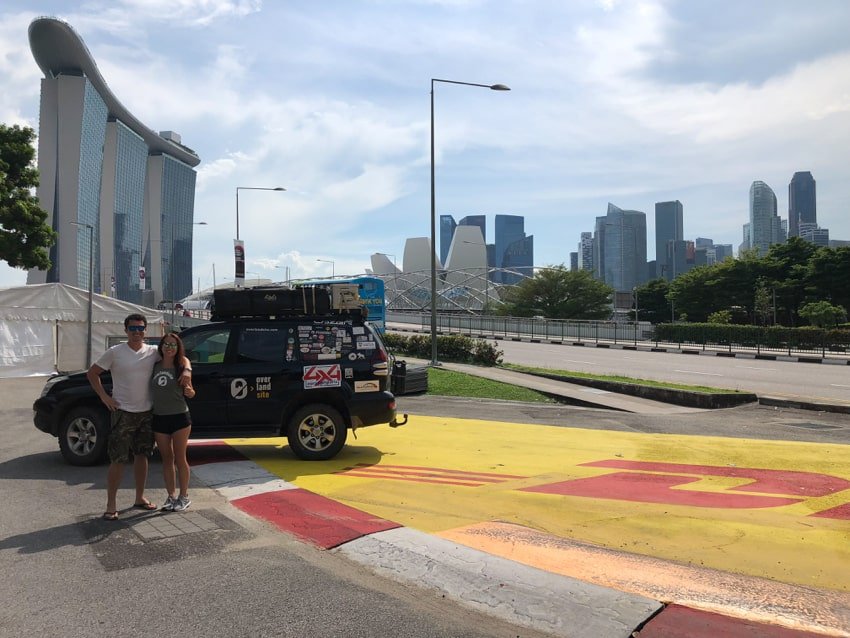
Europe to Singapore
Whether you start in London or Budapest, it doesn’t really matter when you’re driving all the way to Singapore .
For Europeans, Singapore is often the finish line, given that travelling any further requires shipping. You can choose to travel through “the Stans” and include the Silk Road in your adventure, or discover nearly the whole length of Russia before usually crossing south through Mongolia and China towards South East Asia.
The African Adventure Blog Series
The Budapest to Singapore Blog Series
Once overlanders arrive at their destination of Singapore, they either ship from Kuala Lumpur or Singapore itself.
The shipping process can be overwhelming, but there are great resources online to educate yourself, such as LandCruising Adventure’s articles on the subject .
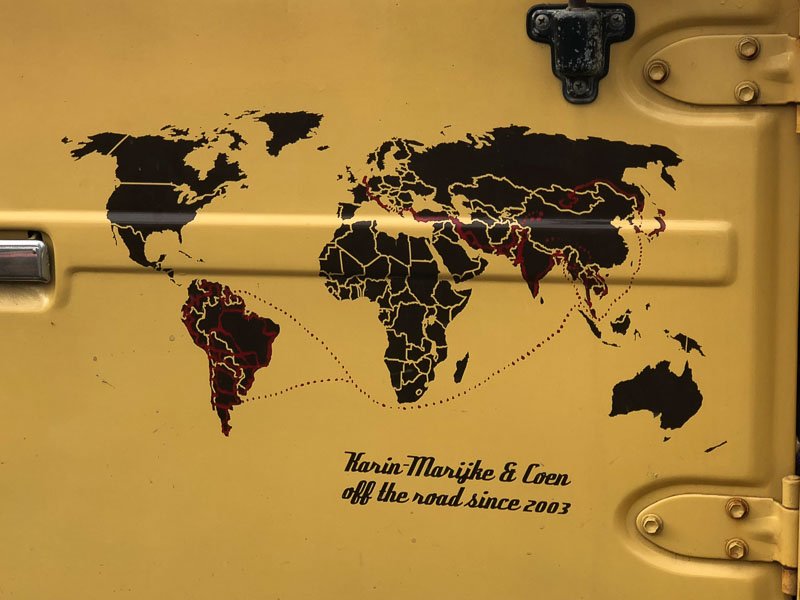
They’ve been on the road since 2003, so you can be sure they know what they’re talking about! What is overlanding? They’re the ones who really know the answer.
There are many other routes of course, but these are amongst the longest and most popular.
<<< Part II: History Of Overlanding?
Read Part IV: How To Start Overlanding >>>
Please let us know what do you think by adding a comment below and perhaps check out the Infographic
Take the quiz to find out which overlanding vehicle best fits you and your travel style.
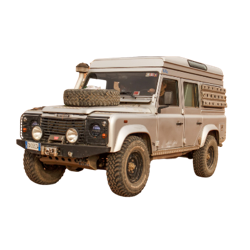
Expert advice on Overlanding - equipment, routes, inspiration, overland blog. Overlandsite - The Authority on Overlanding. Disclaimer: Listen up folks, before you start clicking and buying, let's get one thing straight: We may earn a little something-something when you use our links, but don't worry, it's not gonna sway our opinions. We promise to always keep it real and unbiased, giving you the straight scoop to help you make the best decision for you. So, go ahead, click away, just don't blame us if you end up with too many Amazon packages on your doorstep. Happy shopping! As an Amazon Associate, I earn from qualifying purchases.
Sign up to learn more about overlanding!
YOUR PRIVACY IS PROTECTED
© OverlandSite
What type of vehicle suits your overlanding style?
Taking the train in Ireland – what you need to know
Apr 19, 2024 • 11 min read
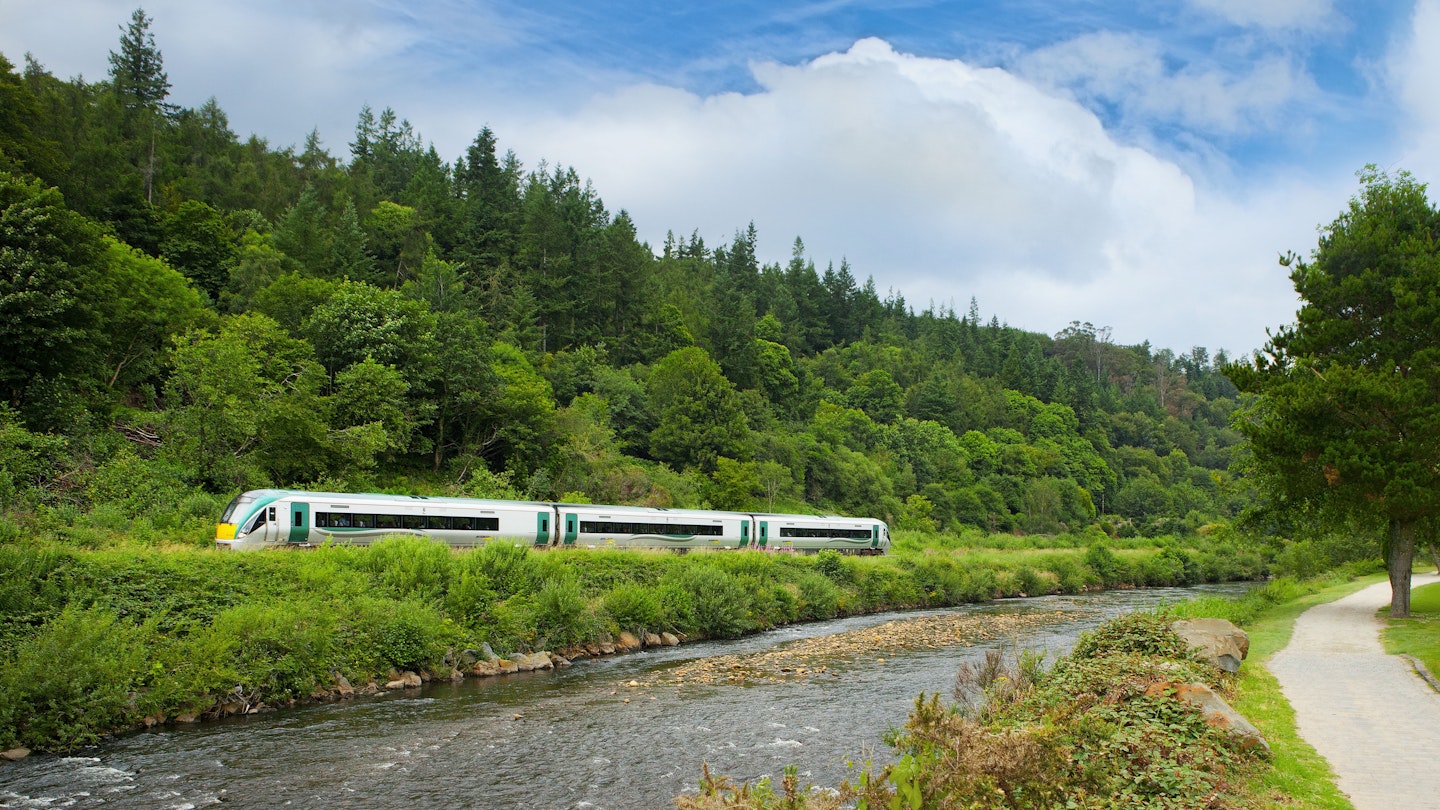
A train travels along the Rosslare, Wexford to Dublin line in Ireland © Irish Rail
Traveling by train is one of Ireland ’s great, if under-appreciated, pleasures.
It’s a small island and the rail network is limited, so no journey is especially long – but riding the rails across the country is one of the loveliest ways to enjoy the rolling countryside.
Compared to its European counterparts, Irish trains aren’t especially spectacular, but this is a country that doesn’t need high-speed or sleeper trains: you roll along at a maximum of 160km/h (99mph) and before you know it you’re on the other side of the island.
The particular nature of Irish demographics has shaped train travel in Ireland: with around a quarter of the population clustered in the greater Dublin region, it makes sense that most train journeys begin or end in the capital. In Northern Ireland the same is true of Belfast .
Irish trains might not be especially quick or super luxurious, but they’re an efficient and eco-friendly way of exploring the island – so long as your explorations are focused on the major cities and towns. Here is our essential guide to train travel in Ireland.
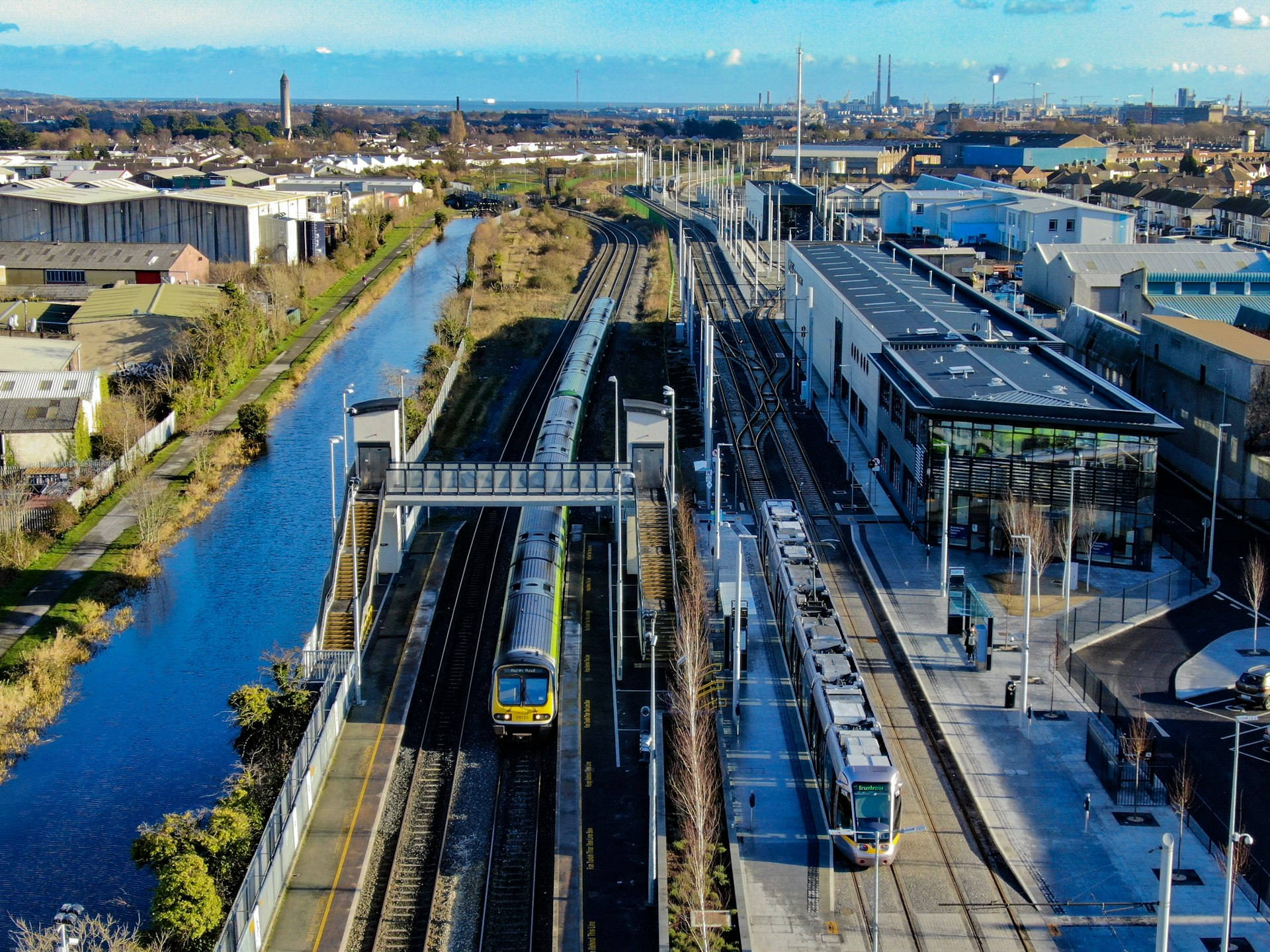
The lowdown on rail travel in Ireland
Irish trains are efficient, relatively frequent and usually on time. Irish Rail/Iarnród Éireann operates the entire network of trains in the Republic, from intercity trains linking the major urban centers to the busy commuter network that services the greater Dublin region.
There are two main lines into the west and three into the south and southwest; spurs off the main lines connect to a host of smaller towns throughout the country. There’s also a line to Belfast, from where Translink services connect the city with the Antrim Coast and Derry (Londonderry) .
Within the greater Dublin region, a network of commuter services connects the capital with a host of suburbs and dormitory towns in the surrounding counties. Dublin’s coastline between the northside suburbs of Howth and Malahide, and Greystones in County Wicklow is served by DART (Dublin Area Rapid Transport) trains.
There are some notable gaps in the country’s rail network, with no services in counties Donegal , Monaghan and Cavan , and no trains into West Cork . Some towns – like Buttevant in Cork or Annacotty in Limerick – are on the rail line but they’re bypassed as they have no functioning station.
Ireland’s bigger train stations – including Cork , Limerick , Galway , Sligo, Belfast and the two in Dublin – are all pretty well stocked when it comes to picking up supplies and other assorted sundries for your journey. Most other stations will have a small shop.
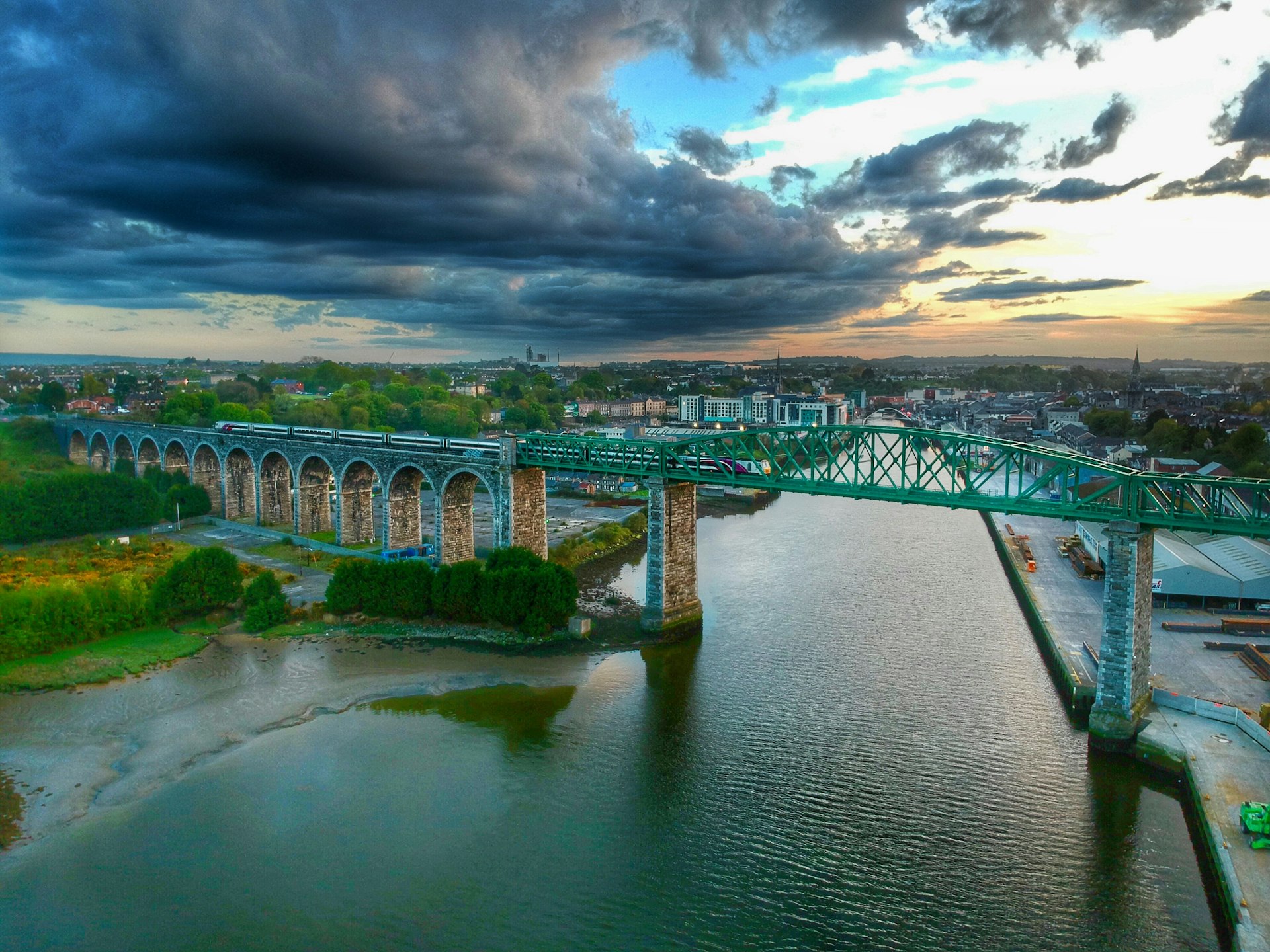
Train tickets are relatively good value
The good news about traveling by train in Ireland is that it is relatively inexpensive compared to train travel in some places, such as the UK, for example. If you buy it online, a standard one-way fare between Dublin Heuston and Kent Station in Cork costs €30–35, and around €55 in first class.
Online is the best place to buy your tickets for train travel in the Irish Republic. Not only do you get the best fares (with savings of up to 50% compared to buying the ticket at the station), but you can purchase your ticket up to 90 days in advance and reserve a seat when you do.
You have the option of collecting your bought ticket from a machine at the station as you’re boarding, or downloading a QR code at the point of purchase. If you wait to buy your ticket at the station, you’ll pay significantly more and have to get there early to queue up at the ticket kiosk.
For travel in Northern Ireland, you’re better off buying the ticket at the station as only a limited number of tickets are available online. Show up a short time before your intended departure time and just buy your ticket there.
Only a handful of services offer first class, but upgrading is relatively inexpensive. On average, expect to pay around €20–25 more to sit in first. There are three kinds of first class service on Irish trains. CityGold is on direct Dublin to Cork services, and includes an onboard host and a complimentary newspaper on selected early morning services. The Enterprise service between Dublin and Belfast offers the same, plus a fine breakfast. Premier Class is similar, but is only available on direct services between Dublin and Tralee and some Dublin to Cork trains.

Some discounts and offers apply
There are discounted fares for children and young adults aged between 19 and 25, as long as they have a valid discount card. Under fives and those aged 66 and over travel for free.
The commuter network in the Greater Dublin area has a fare cap of €6 for travel between the capital and a host of towns in the surrounding counties.
There are two rail passes aimed at visitors. The Trekker Four Day (€88) offers unlimited travel for adults on all Irish Rail services on four consecutive days from the date of issue. The Explorer (adult/child €128/64) provides five days of travel on all services in a 15-day window.
However, before investing in either, be sure that you plan on making the most out of it. The limited rail network means that connections are limited and traveling between some destinations involves backtracking: Cork and Waterford are both on the south coast, but to get from one to the other means travelling to Limerick, while Sligo and Westport are only 140km (87 miles) apart along the west coast, but to go between them by train you’ll have to travel through Dublin – which is on the other side of the country.
In Northern Ireland, the Sunday Fun Day Tracker ticket gives passengers unlimited train travel on a Sunday for £9 (£4.50 for children). Tickets are available from all ticket offices, the mLink ticketing app and from the conductor on the train.
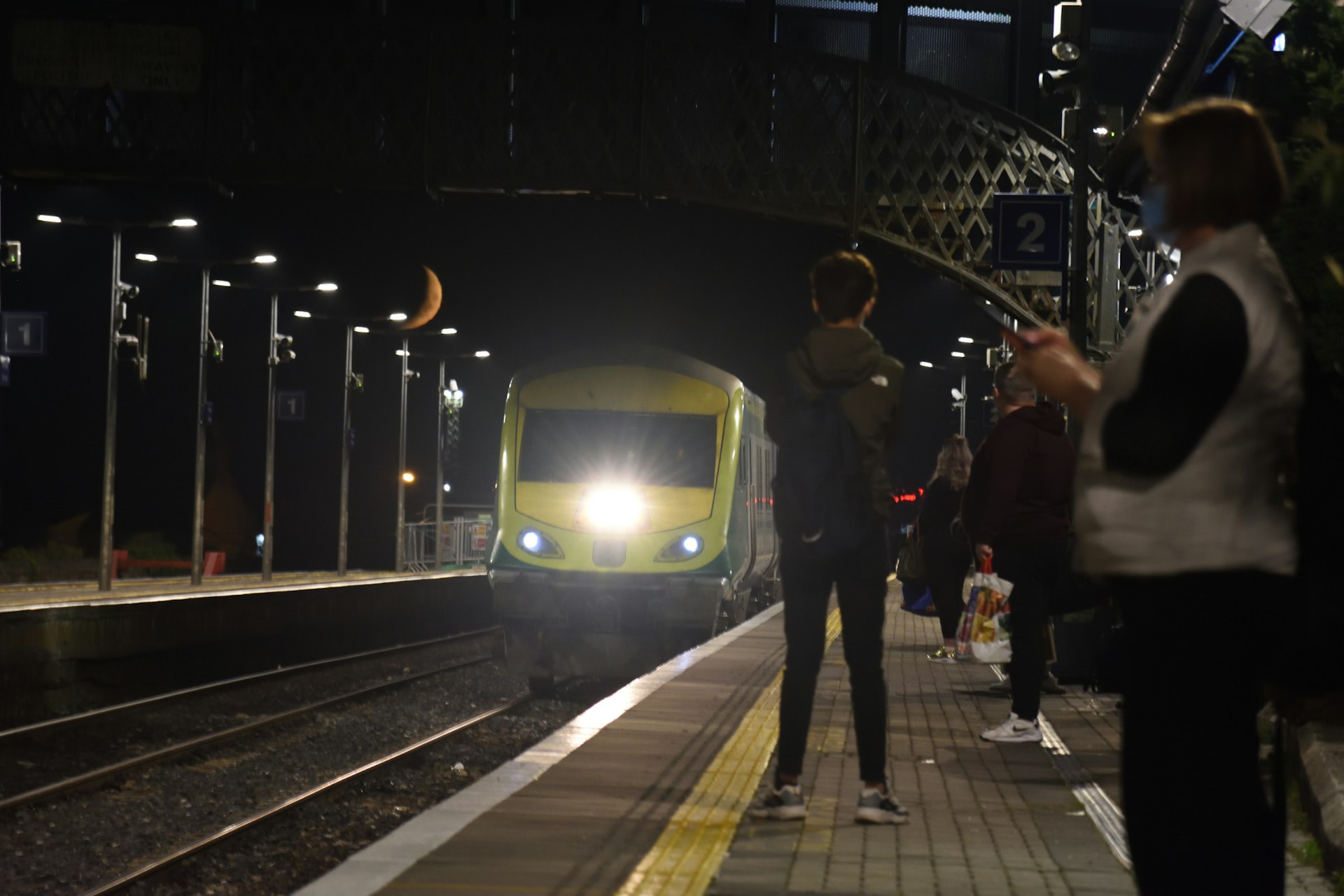
These are the busiest times to travel by train
Unsurprisingly, peak times for train travel coincide with busy rush hour periods. Early morning services to Dublin from cities including Cork, Galway and Limerick can be busy, especially if the train is due to arrive in Dublin around the start of the working day. Friday evening trains departing Dublin can also be quite busy. However, as online bookings also include the option of booking a seat, you’ll never have to stand.
The commuter network is busiest on weekdays from 7am to 9am and from 4:30pm to 6:30pm as thousands of people travel in and out of work. You can’t prebook seats on these services, so plenty of people do end up standing. Keep an eye out on changing schedules, especially for weekend and holiday travel, as frequencies diminish.
The train network is limited, but it has some benefits over road travel
There are no rail links to any Irish airport, which means you’re relying on taxis, private cars or buses once you arrive in the country. Irish ferry ports are better connected to rail lines, however, and you can catch trains in Rosslare, Dublin and Larne; there is no rail link to Belfast Port.
If you want to reach the more remote corners of the island, then the Irish rail network is quite limited, and a car will give you the flexibility you need. However, rental fees can be very expensive and fuel is another considerable cost, with the price of unleaded and diesel hovering between €1.75 and €2 a liter. Parking is also pricey in all urban centers, especially Dublin.
Traveling by bus is the cheapest way to get around, but it can be a slow business, as most make lots of stops along the way. There are some direct express services, but they are at the mercy of traffic, which can also add considerable time to a journey compared to traveling by train. Plus, buses don’t have bathrooms, with those traveling longer distances relying entirely on rest stops.
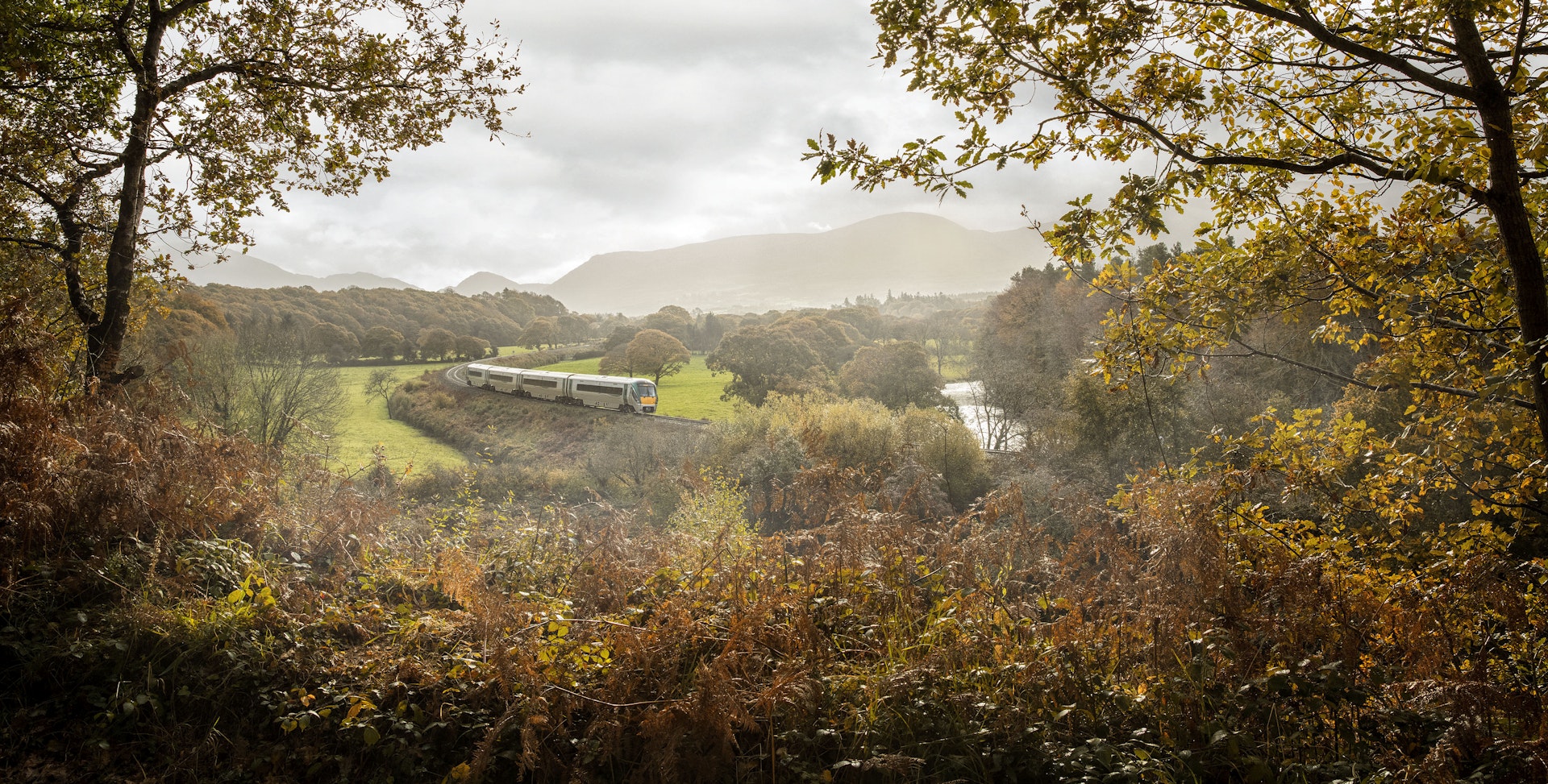
On board facilities vary depending on the type of train
There are two kinds of Irish trains: InterCity and commuter. InterCity trains are all the same – relatively modern with comfortable seats in standard class and fancier recliners in first – and they travel at speeds of up to 160km/h (99mph). There’s no journey in Ireland that is longer than 2½ to 3 hours. Commuter trains are slightly older, with less comfortable seats; older trains are used on some small-distance spur lines in rural areas and are very basic (facilities include seats and a toilet).
While Ireland’s flagship service is the one between Dublin and Cork, the fanciest train is the Enterprise service between Dublin Connolly and Belfast Lanyon Place, which is a joint venture between Irish Rail and Translink. This train is on a par with most services you’ll find in mainland Europe and first class is the most luxurious of any in the country.
All InterCity trains have three-pin sockets at every row where you can plug in a charger or a laptop. Most commuter trains in the greater Dublin area also have sockets. All trains have toilets and there is a cross-network wi-fi service operated by Irish Rail, but it is patchy and inconsistent. Translink has its own wi-fi network, which is accessible on all bus and rail services in the north, but, like in the Republic, you’re at the mercy of signal strength and contention levels.
Food options are pretty limited. There is a trolley service on the Dublin to Cork service, while the Enterprise between Dublin and Belfast operates a full service menu in a dedicated dining car; first class passengers also get a pretty good breakfast as part of their ticket.
Some trains on the Dublin to Cork route have a “quiet carriage” (usually Carriage G, marked in purple when booking) where the use of phones is prohibited and passengers are encouraged to keep noise levels down.
You can bring a bike on any Irish Rail train for free, although there are some restrictions during busy periods (such as sporting fixtures and concerts). The Dublin to Cork line is the only one to have a dedicated bike storage area; all other InterCity trains have (very) limited bicycle spaces within the passenger compartment – it’s not unusual for only two bikes to be allowed into the compartment, so be sure to book in advance. Bikes are not allowed on commuter and DART services during peak hours – before 10am and from 3:30pm to 7pm Monday to Friday.

There are many scenic train routes: here are the best
No matter where you are in Ireland you’re going to find a beautiful landscape or two, but some journeys are worth keeping your eyes wide open for.
Dublin to Sligo
Once you’ve gone past the huge suburban sprawl of the greater Dublin area, the landscapes get quite gentle; beyond Mullingar the train skirts alongside the edge of beautiful Lough Owel. For the best views, sit on the left-hand side of the train.
Dublin to Belfast
The Enterprise service is the best in the country, with the most comfortable seats and the best food options – especially in first class. The train skirts alongside the Irish Sea between Malahide and Balbriggan, so be sure to sit on that side as you travel (on the right-hand side if you’re traveling to Belfast).
Derry (Londonderry) to Coleraine
The Translink service between Northern Ireland’s second city and Coleraine is a stunner, a 40-minute journey along the Causeway Coast that comes with beautiful beaches, huge cliffs and unimpeded views out over the North Sea.
Downpatrick to Inch Abbey
It’s only a 10-minute journey, but the trip from Downpatrick in County Down to the monastic ruins of Inch Abbey takes place in a vintage steam train (or a 1960s diesel train) that chugs its way along the line, over the River Quoile and past the drumlin-specked landscape.
Cork to Cobh
One of Ireland’s most scenic trips is the 25-minute trip from Cork City to the seaside town of Cobh , which takes you along the river (sit on the right for the best views), past marshy Harper’s Island and over the bridges on Lough Mahon and the Slatty Water. You can always stop off at Fota and visit the wildlife park there.
Book in advance for wheelchair access to trains
All InterCity services are nominally accessible, but if you do need assistance you will need to book it in advance so that suitable arrangements can be made. This usually means that a conductor will have a ramp ready for wheelchair access, but we have also heard plenty of anecdotal evidence of staff simply lifting a wheelchair onto a train, which depending on the individual can either be a help or an annoying hindrance. Whatever you do, make sure to communicate your requirements before you travel as assistance is not guaranteed otherwise.
For passengers with learning difficulties or any issue where there may be a challenge with communication (such as autism) Irish Rail staff are trained to recognize visual cue cards such as the JAM card , which inform the interlocutor of the holder’s condition. JAM cards are available online or at mainline train stations in Dublin, Cork, Galway, Limerick, Waterford and Sligo.
Explore related stories

Sustainable Travel
Apr 1, 2024 • 11 min read
With its small size, flat terrain and range of public transport options, getting around Dublin is easy. Here are the best ways to travel in Dublin city.
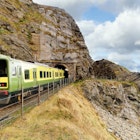
Mar 13, 2024 • 7 min read
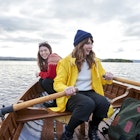
May 27, 2023 • 10 min read

Dec 27, 2022 • 8 min read

Aug 3, 2022 • 7 min read

Jun 26, 2020 • 2 min read

Jan 22, 2020 • 11 min read
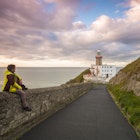
Apr 15, 2024 • 7 min read

Apr 14, 2024 • 6 min read

Apr 8, 2024 • 7 min read
- Skip to main content
- Keyboard shortcuts for audio player
'Conan O'Brien Must Go' is side-splitting evidence of life beyond late night TV

Eric Deggans

Conan O'Brien dresses as a Viking in Norway. Conaco/Max hide caption
Conan O'Brien dresses as a Viking in Norway.
To be honest, when I first heard Conan O'Brien was ending his TV talk show in 2021, I assumed news that he might turn to variety shows and online programs to continue his career was some combination of face-saving and wishful thinking.
But after watching the four episodes of his new Max series Conan O'Brien Must Go , it's now obvious — even to a thickheaded critic like me — that leaving late night TV really was liberating for O'Brien. He's leveraged his unique sensibility into several different podcasts, a deal with Sirius XM , specials featuring other stand-up comics and now this travel series for Max — which resembles jokey specials he did for cable channel TBS back in the day.
And as the late night TV genre crumbles under sagging viewership and the decline of traditional media, O'Brien's renaissance also provides an example for the future — where fertile comedy minds and talented performers can spread their work over a much larger canvas.

Pop Culture Happy Hour
Is conan o'brien the best 'hot ones' guest ever discuss., learning a lesson from 'hot ones'.
O'Brien already made a splash recently with his brilliantly maniacal appearance on the interview-while-eating-hot-wings show Hot Ones , slobbering over hot sauces while claiming, as he was checked over by a fake doctor, that "I'm fine! I'm perfectly f*****g fine!"
This is the place where O'Brien shines — he's called it "this strange phantom intersection between smart and stupid" — and it's on full, freakish, super silly display in every episode of Conan O'Brien Must Go .
The conceit of the show is pretty simple. O'Brien heads overseas to visit average folks in Norway, Argentina, Thailand and Ireland who had once Zoomed in to speak with him on the podcast Conan O'Brien Needs a Fan . Sometimes the visits seem like a surprise — he catches one aspiring Norwegian rapper in shorts and Crocs after popping up on his doorstep — and others seem a bit more planned, including his visit to a radio show with about four listeners in Buenos Aires.
Each episode begins with a solemn monologue which sounds like it is delivered by the film world's most eccentric voice, German filmmaker and actor Werner Herzog (he's not credited in the show and when asked, a publicist at Max shared a quote from O'Brien: "I can neither confirm nor deny the voice in question.")
The torturous accent by "Herzog" makes every line sound absurdly hilarious, describing O'Brien as "the defiler ... with dull, tiny eyes ... the eyes of a crudely painted doll ... he scavenges in distant lands, uninvited, fueled by a bottomless hunger for recognition and the occasional selfie."
Now that's smart. And oh so stupid.
A funhouse mirror version of a travel show

O'Brien performs onstage with a fan in Norway Conaco/Max hide caption
O'Brien performs onstage with a fan in Norway
Fans of O'Brien's Conan Without Borders specials on TBS already know what his style is when he tackles a travel show — throwing himself into outrageous reactions and situations while working his quirky brand of improvised conversations with hapless bystanders.
In the Max series Conan O'Brien Must Go , that includes O'Brien offering screechy vocals onstage during a performance of a Norwegian emo/rap band. Or asking provocative questions of a couple therapist/sex expert. Or getting beat up in a "fight" with a 10-year-old boy in a bar.
It's all an excuse for O'Brien to unleash his energetic wit, taste for silly absurdity and skill at drawing laughs from sympathetic — if often befuddled — strangers. Whether you enjoy this special will depend on how you feel about O'Brien's style, which can feel a bit like the world's best class clown doing everything possible to make you crack a smile.
(Rent a family in Norway so they can say goodbye when he gets on a SeaCraft? Check. Get local artists to paint a mural of O'Brien, a soccer star and The Pope on the side of a building in Argentina? Double check.)

'Conan O'Brien Needs A Friend' Is A Joke Name For A Podcast — Sort Of
But what amazes in a larger sense is how O'Brien has turned his sensibility into a comedy brand to fuel work on many different platforms. And, at age 60, with more than 30 years as a comedy star, he's been released from the shackles of any genre to shine wherever he chooses — whether it's an episode of Hot Ones or a streaming service which sometimes looks like a collision between True Detective and 90 Day Fiancé .
Leaving late night TV as late night left him
I'm old enough that I started covering TV not long after O'Brien made his first move from the shadows of life as a comedy writer – he worked on Saturday Night Live and The Simpsons — to succeed David Letterman in 1993 as host of NBC's show Late Night (now hosted by Seth Meyers). Back then, NBC gave O'Brien years to figure out the show, honing his smartly serious comedy in a way that would inspire then-teenage fans like Seth Rogen and Bill Hader .
O'Brien left NBC after a disastrous deal where the network tried to make him host of its venerated late night program The Tonight Show and also keep its former host Jay Leno at the network. He moved to a late night show on TBS in 2010, but even then, there was a sense that his creativity was a bit hemmed in by the format.

After 28 Quirky Years, Conan O'Brien Is Leaving Late Night
By the time he left his TBS show Conan for good, it seemed O'Brien was already caught in a trend which would hobble other late night shows — as young viewers consumed his content online and ratings on cable dropped.
Now, with a podcast and digital media company worth many millions and growing status as a TV comedy legend still willing to do almost anything for a laugh, O'Brien is proving there is a successful life beyond late night.
Particularly, if you have the talent to play the fool while leaving little doubt you're also the smartest person in the room.
Recommended
- Click to share on Facebook (Opens in new window)
- Click to share on Twitter (Opens in new window)
- Click to email a link to a friend (Opens in new window)
- Click to copy URL
Save hundreds on celeb-loved jewelry at Jennifer Meyer’s biggest sale ever: ‘May never happen again’
- View Author Archive
- Follow on Twitter
- Get author RSS feed
Thanks for contacting us. We've received your submission.

Stars have access to practically any bling on the market — so they know a gem of a design when they see it.
Fom Taylor Swift to Meghan Markle to Jennifer Aniston, plenty of famous folks are bejeweled in Jennifer Meyer’s luxe baubles on a regular basis.
And today, the in-demand designer is kicking off her biggest savings event ever : 23% off on everything, a deal the site warns “may never happen again.”
While most items are investment pieces, you’ll be splurging significantly less right now when you shop designs like the Mini Circle Link Necklace ( $6,000 $4,620) Taylor Swift wore in her “Anti-Hero” video — which is currently a whopping $1,380 off.
Jennifer Meyer Mini Circle Link Necklace

For a (slightly) more budget-friendly buy, it’s your lucky day for shopping meaningful charms like the Mini Clover Necklace ( $300 $231) and Good Luck Necklace ( $3,950 $3,641).
“I get the greatest stories of people who wear that necklace, and all the good things that they feel happened to them while they’re wearing it,” Meyer herself previously told us of the latter pendant, which Swift, Sofia Richie, Reese Witherspoon and Emily Ratajkowski all own.
Jennifer Meyer Good Luck Necklace

Plenty of Meyer’s famous friends also love the designs, including Courteney Cox and Jennifer Aniston — the latter of whom helped give the brand its big break when she wore a version of the Mini Leaf Necklace ( $350 $270) in her movie “The Breakup.”
Jennifer Meyer Diamond Huggies

Jennifer Meyer Mama Necklace

With Mother’s Day on the way , the site also offers plenty of gift-ready sparkle for less — including over $100 off the Mama Necklace ( $675 $540), delicate Diamond Huggies ( $1,850 $1,425) and Mini Uppercase Letter Necklace ( $350 $270).

Whichever pieces you select, just be sure to shop fast; even the brand’s famous good luck charms can’t ensure deals this good will come around again.
Shop 'til you drop with Post Wanted
Save time and money with the latest deals, discounts, trends, reviews and more.
Thanks for signing up!
Please provide a valid email address.
By clicking above you agree to the Terms of Use and Privacy Policy .
Never miss a story with New York Post newsletters.
Share this article:

IMAGES
VIDEO
COMMENTS
Offroad trips and camping on 4x4 with rooftopt tents, overlanding and basically just having a good time. Subscribe if you feel like following future trips and Jimny mods! ...
What to pack for an overlanding trip. In addition to food, water, and the usual assortment of clothing and toiletries, I've found the below items to be crucial for a successful overlanding trip. Coolers are really useful, especially when overlanding for multiple days in hot, desert-like conditions. You can even buy small, collapsible cooler ...
The ULTIMATE Guide to Overland Travel (2024) It is absolutely without question that my best travel journeys to date have been overland. Some were on motorbike, others were by way of a cardboard sign on the side of the road, and I have visions of future journeys that involve a big old school bus traversing the lands between Europe and Asia.
As a popular training grounds for Jeep, the overland classic has a variety of terrain ranging from beginner to expert. Don't be fooled by this route's popularity; it's still considered one of the most dangerous and difficult. Experienced overlanders shouldn't miss this one. 4. The Infamous: Black Bear Pass, Colorado.
The BLM and Forest Service produce maps of popular off-road routes with ratings. These systems take into account a route's grade, road width, tightness of turns, surface type, and the size and type of obstacles. Generally, a rating will reflect the road's most challenging section or element.
2 - High Water Mark Trail (Ozark Overland Trail) Location: Ozark Mountains, Arkansas. Total Distance: 140 miles. Estimated Time to Complete: 2-3 days. Best Time to Travel: Fall. Located partially in the Ozark National Forest, the High Water Mark Trail is a longer trek, with the exact route taking up to three days.
Cooking Equipment. Cooking while on the road is part of the overlanding experience. Key items to pack include: Portable stove: A compact stove allows you to cook hot meals, boil water, and make coffee or tea. Cooking utensils and cookware: Bring pots, pans, and utensils that are durable and easy to clean.
8. A good sense of adventure. Getting out of your comfort zone is what overland travel is all about and an intrepid sense of adventure is a key ingredient of any journey. River crossings, close-up encounters with wildlife and remote wilderness camping are all possibilities that make up part of the truly epic adventure that an overland journey ...
Discover the ultimate overlanding adventure guide, packed with tips, routes, gear recommendations, and safety advice. Embark on unforgettable journeys, from family-friendly trips to off-road explorations. Start your overlanding adventure with confidence and immerse yourself in the great outdoors!
You can actually overland in any vehicle - a truck or SUV, a station wagon or motorcycle. It's really up to you and what you want your overlanding trip to look and feel like. You can overland in a two-wheel-drive vehicle, AWD, or four-wheel-drive. Heck, you can make a Volkswagen Bug into an overlanding vehicle if you want!
For your overland travels, you'll want to have everything you need to eat and sleep comfortably at camp. Driving and riding require skill and concentration, both of which depend on getting a good night's sleep, staying hydrated, and consuming a few quality calories. READ MORE: How to: Start Overlanding.
Overlanding is a type of travel that involves self-reliant, off-road adventure in a vehicle, usually a four-wheel drive. This type of travel allows you to experience remote and untouched destinations, away from the typical tourist crowds. Overlanding has been gaining popularity in recent years, and for good reason.
How to plan an overland camping trip. These resources can help ease stress and cover unforeseeable circumstances when planning an overland camping trip. Overland Expo is an event that takes place a few times a year in locations across the United States. The event is hosted in the West, East, Pacific Northwest, and Colorado.
Covering over 6200 miles, the journey guides you through Sudan, Ethiopia, Kenya, Tanzania, Zambia, Zimbabwe, Botswana, and more before landing in your final destination. 4. The Pan American Highway. The enormous 18,640-mile Pan-American Highway is the Overland trip of a lifetime - for true adventurers only.
Key Takeaways An overland camping trip is a style of off-roading that involves long-haul driving on unmaintained roads to remote and untouched destinations.Overlanding or 4WD touring is unique from traditional camping trips in that the journey is the adventure, not the end destination.
Step 1: Select an Overland Navigation Device or App: Overland Navigation Apps. There are a variety of overland navigation apps on the market today that can help you plan your overlanding trips. The Gaia GPS apphas been around for awhile now and we've found it to be the most capable, cost-effective (most basic features are free), and user ...
Routes it categorizes as Overland should be accessible to any carefully operated vehicle with good tires; those classified as High Clearance 4×4 trails should only be attempted with a true four ...
The Alpine Loop, Lake City, CO. Length: 63 miles. Time Needed: 1-2 days. The Alpine Loop is one of the most scenic and iconic overland routes in the world. Open from June-September, the Alpine ...
9. Hunter Mountain. Located in New York, Hunter Mountain is a ski resort in Greene County. It is three hours northwest of NYC. Although the Hunter Mountain trail is inarguably one of the most beautiful trails any overlander will set their eyes on, it is also one of the trickiest routes.
When Overlanding, a good fridge or cooler is essential for keeping food cold. EUHOMY 12 Volt Refrigerator, is a great option as it functions as both a fridge and freezer. With a durable outer shell and a 45L/48QT capacity, it is perfect for long expeditions. ... Nothing says a successful overland camping trip like some fun cocktails to enjoy ...
Valley of the Gods Road. Location: North of Mexican Hat, Utah Distance: 17-mile loop Recommended Trip Duration: 2 hours - 2 days When to Go: Spring (March-early June) and Fall (September-October) While Valley of the Gods Road in Utah is the shortest overland trail on our list, we intentionally include it because it offers a truly remarkable overland experience with an incredibly low barrier to ...
The Rubicon Trail is a classic overlanding route that is located in California's Sierra Nevada region. The route features a challenging mix of paved roads and dirt trails that take travelers past some of the most scenic areas in California. Different trails along the route lead to popular destinations such as Lake Tahoe, El Dorado National ...
Photo: Tim Snel. Oasis Overland offers an incredible South American trip which will take you on an epic full-circle journey through Ecuador, Peru, Bolivia, Chile, Argentina, Brazil, French Guiana, Suriname, Guyana, Venezuela and Colombia, over the course of 31 adventure-filled weeks. This expedition offers you the chance to explore off-the ...
The good news about traveling by train in Ireland is that it is relatively inexpensive compared to train travel in some places, such as the UK, for example. If you buy it online, a standard one-way fare between Dublin Heuston and Kent Station in Cork costs between €30-35, and around €55 in first class. Online is the best place to buy your ...
'Conan O'Brien Must Go' review: The Max travel show proves life after late night As the late night TV genre crumbles under sagging viewership and the decline of traditional media, O'Brien's ...
Jennifer Meyer. BUY NOW $6,000.00 $4,620.00. For a (slightly) more budget-friendly buy, it's your lucky day for shopping meaningful charms like the Mini Clover Necklace ( $300 $231) and Good ...